Paul Finch's Blog, page 11
December 29, 2018
Eerie East Anglia, above and below ground

Well, it’s not quite New Year yet, but this is likely to be the last time I speak to you all before 2019, so it seems an appropriate time to say Happy New Year and to wish you all every success and prosperity in the months ahead.
On the personal front, my next novel, STOLEN, which is book 3 in the Lucy Clayburn saga, will be published on May 16. That’s some way off yet, I know, and as such, I still haven’t got any cover artwork for you. But the official back-cover blurb has now appeared online, and so I’m going to run that today before I do anything else.
Staying on the subject of lady cops, I’ll also be reviewing and discussing Elly Griffiths’ intriguing mystery-thriller, THE CHALK PIT, which sees her female investigator, Dr Ruth Galloway, head into the tunnels underneath Norwich, where something truly odious may be going on.
As usual, you'll find the Elly Griffiths review at the lower end of today’s blogpost. But talking about Norwich and odious, I’m also moved today to muse a little on East Anglia, and the mythical horrors that may lurk amid its flat fields, gentle broads and deceptively pretty woodlands – particularly in regard to an anthology I edited, which was published several years ago, called TERROR TALES OF EAST ANGLIA .
But more about that later. First up, here’s the latest on the Lucy Clayburn front.
Missing without trace
Regular followers of this column will know that Lucy Clayburn is a young street-cop – a detective now, though she started out in uniform – in the fictional Crowley district of Manchester, and who, though she technically works divisional CID, frequently gets embroiled in much darker and more complex enquiries.
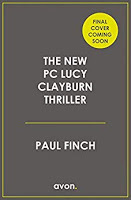 She’s appeared in two of my novels to date:
STRANGERS
in 2016, and
SHADOWS
in 2017, and will be hitting the bookshelves again in May next year.
She’s appeared in two of my novels to date:
STRANGERS
in 2016, and
SHADOWS
in 2017, and will be hitting the bookshelves again in May next year.Here, as promised, is the official blurb for the next book:
How do you find the missing when there’s no trail to follow?
DC Lucy Clayburn is having a tough time of it. Not only is her estranged father one of the North West’s toughest gangsters, but she is in the midst of one of the biggest police operations of her life.
Members of the public have started to disappear, taken from the streets as they’re going about their every day lives. But no bodies are appearing – it’s almost as if the victims never existed.
Lucy must chase a trail of dead ends and false starts as the disappearances mount up. But when her father gets caught in the crossfire, the investigation suddenly becomes a whole lot bloodier…
The Sunday Times bestseller returns with his latest nail-shredding thriller – a must for all fans of Happy Valley and M.J. Arlidge.
A cheerless realm
And now back to East Anglia. But before today’s Thrillers, Chillers section focusses on Norwich-set Gothic crime novel, THE CHALK PIT, I must talk a little about that anthology I edited back in 2012, TERROR TALES OF EAST ANGLIA .
This was the third volume in my round-the-UK antho series, which I started in 2011. The ethos of the Terror Tales books has always been to mingle local fact with local fiction, with a heavy emphasis on folklore – and of course to terrify readers out of their wits. (This has been the format throughout the series, and the format we’ll continue to use when, next year, my Terror Tales publishers, Telos Publishing, and I, will be going all out to get TERROR TALES OF NORTHWEST ENGLAND ready for an autumn release).
Before I say anything else about the East Anglian anthology (seven years old last September), please allow me to explain why I’m even thinking about it at the end of 2018.
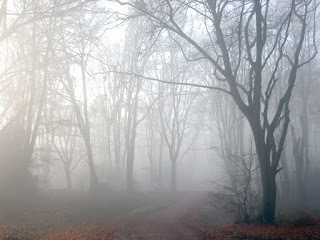 Frankly … it’s because of the time of year.
Frankly … it’s because of the time of year.We’ve got some snow and ice forecast for next month, but at present Britain is a typical dreary scene: drab, leafless woods, grey, gloom-shrouded moorland, skies colourless and cold, any abandoned buildings, follies, disused bridges or railway tunnels, or other curious, unearthly structures standing desolate and alone in a landscape devoid of life.
Doesn’t that start to make you think MR James?
Whether it does or doesn’t, it always starts to make methink of the old ghost story master. Though, maybe this is as much the influence of the many television adaptations as it is the wonderfully frightening stories that he, himself, penned.
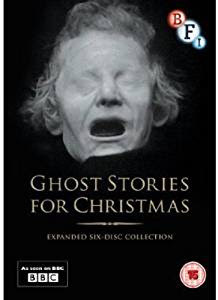 Because, though many of his eerie fictions were set at Christmas, or written to be read at Christmas, and in later decades became regarded as ‘Ghost Stories for Christmas’ (the famous BBC adaptations of the 1970s can now be bought together on DVD under that very title), they actually contain very few Christmassy elements. Oh yes, he frequently touches on the religious side of it – Midnight Mass, the Nine Lessons and Carols, etc – but the tales are quite spartan when it comes to festive trappings. We aren’t overly concerned with Christmas trees, or Yule logs, or wassailing, or even that staple of so many Christmas stories – snow.
Because, though many of his eerie fictions were set at Christmas, or written to be read at Christmas, and in later decades became regarded as ‘Ghost Stories for Christmas’ (the famous BBC adaptations of the 1970s can now be bought together on DVD under that very title), they actually contain very few Christmassy elements. Oh yes, he frequently touches on the religious side of it – Midnight Mass, the Nine Lessons and Carols, etc – but the tales are quite spartan when it comes to festive trappings. We aren’t overly concerned with Christmas trees, or Yule logs, or wassailing, or even that staple of so many Christmas stories – snow. So, though they are undoubtedly winter tales, they don’t always feel as if Christmas – at least, the Dickensian Christmas that we all know and love – is an essential ingredient, instead depicting the rural landscape of eastern England where so many of them are set (Norfolk, Suffolk and Essex), in the bleakest way imaginable. Okay, I know that’s not the whole story, but that’s very much my personal perception of the archetypal Jamesian backdrop, and that’s why, when we’ve finally worked our way through the festive bun-fight, and found ourselves with the bulk of the winter still stretching ahead, and especially if it’s as snowless and cheerless as this one, I inevitably find myself drawn to the writings of MR James and to the Jamesian school of horror writers.
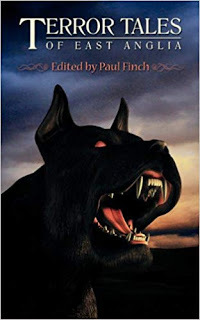 Which brings me neatly back to
TERROR TALES OF EAST ANGLIA
.
Which brings me neatly back to
TERROR TALES OF EAST ANGLIA
.When I first commissioned a bunch of authors to send me some terrifying tales for this book, I didn’t specify that they needed to be written in the style of MR James, but almost inevitably, links were made, and a Jamesian tone generated.
Its back-cover blurb, which I wrote after selecting the stories, is perhaps a clearer indication of this:
East Anglia – a drear, flat land of fens and broads, lone gibbets and isolated cottages, where demon dogs howl in the night, witches and warlocks lurk at every crossroads, and corpse-candles burn in the marshland mist …
The giggling horror of Dagworth – The wandering torso of Happisburgh – The vile apparitions at Wicken – The slavering beast of Rendlesham – The faceless evil on Wallasea – The killer hounds of Southery – The dark guardian of Wandlebury ...
And so now, to celebrate this for no other reason than the weather being Jamesian and the mood very Jamesian (at least to me), I proudly present …
East Anglian terrors on film
Now, first of all, this is not a real thing. Not by any means. (Not yet, anyway).
But you may recall that, earlier this year, I decided to alter my regular Thrillers, Chillers, Shockers and Killers section by occasionally reviewing and discussing anthologies and single-author collections as well as novels, and each time, of course, selecting four particular stories from the book in question, which I’d love to see incorporated into a single movie, and giving them my usual fantasy cast.
Well … I’ve still got no anthologies ready to review at present, though plenty reside in my to-be-read pile. So, in the meantime, and just for a bit of a laugh, I’m keeping my hand in by doing it with the Terror Tales books. Obviously, I won’t be reviewing them as well, as that would be a bit incestuous (even though they are all brilliant), but at least I can turn each one into a portmanteau horror movie all of my own. You may recall that on May 16, we did it with TERROR TALES OF THE LAKE DISTRICT , and on July 4 with TERROR TALES OF CORNWALL. And so, totally keeping up with that theme, here is is …
TERROR TALES OF EAST ANGLIA – the movie
As I say, just a bit of fun. No film-maker has optioned this book yet, or any of the stories inside it, but here are my thoughts on how they should proceed. Note: these four stories are NOT the ones I necessarily consider to be the best in the book, but these are the four I perceive as most filmic and most right for a compendium horror. Of course, no such horror film can happen without a central thread, and this is where you guys, the audience, come in.
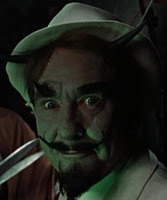 Just accept that four strangers have been thrown together in unusual circumstances which require them to relate spooky stories. It could be that they visit a series of sideshows in a run-down fair hosted by a mysterious, vaguely demonic showman, (remember Torture Garden?) or force entry to an eerie old wax museum, where each one of them finds his/her reflection in one of several ghastly effigies (Waxwork, anyone?) – but basically, it’s up to you.
Just accept that four strangers have been thrown together in unusual circumstances which require them to relate spooky stories. It could be that they visit a series of sideshows in a run-down fair hosted by a mysterious, vaguely demonic showman, (remember Torture Garden?) or force entry to an eerie old wax museum, where each one of them finds his/her reflection in one of several ghastly effigies (Waxwork, anyone?) – but basically, it’s up to you.So, without further ado, here are the stories and the casts I envisage performing in them:
The Watchman (by Roger Johnson)
Woolton Minster, a Norman church deep in rural Suffolk, is a nondescript religious building, not particularly handsome, nor especially rich, but it contains some precious vessels and boasts several horrific gargoyles, including one that stands almost ten feet in height. Thomas Drinkhall, a Scrooge-like local merchant, who has recently lost everything through misadventure, is unimpressed by this menacing figure, and as he carries a spare key to the church, resolves to rob the place. Night falls and Drinkhall secretly enters the ancient building, but it isn’t long before he starts to suspect that something else is there, something that moves with heavy, clumping feet …
Tomasina Drinkhall (for the sake of gender diversity) – Kathy Bates
Wicken Fen (by Paul Finch - sorry guys, but I’m never going to pass a chance to put my own work on film)
Middle-aged Londoners, Trevor and Gerry, take a weekend’s break away from their wives, hiring a narrow-boat on the Cambridgeshire broads, at the same time eyeing up girls and drinking lots of beer. But stresses soon emerge in their relationship, Gerry wanting to do more than just oggle the talent, and Trevor soon missing home. However, when they spy two young ladies who think nothing of sunbathing nude, even Trevor’s head is turned. He wants to stay loyal to his wife back home, but this nubile twosome are sexiness personified. Unfortunately, neither man has heard anything about the East Anglian myth of the terrifying mere-wives ...
Trevor English – Hugh GrantGerry Axewood – Jason Isaacs
Deep Water (by Christopher Harman)
Musician Peter Belloes might be having an affair with pretty young Elise, but when his wife, Celine, goes missing in their seaside hometown, he gets worried. Celine, a novelist who specialised in adapting East Anglian myths as children’s stories, was investigating the legend of the nightmarish Seagrim, which has clearly been a darker-than-usual project. The oddly odious Detective Sergeant Trench suspects that Celine drowned herself because of her husband’s infidelity, the Seagrim merely a metaphor for this. But Belloes isn’t even sure Celine is dead, especially when he starts to catch glimpses of her dripping-wet figure in various spots around town …
Peter Belloes – Colin FirthDetective Sergeant Trench – Timothy Spall
Wolferton Hall (by James Doig)
Medievalist, Hugh Terne, is given permission to occupy Throgmorton Hall in the wilds of Norfolk. There are plenty of documents to dig through, but a two-panelled fresco really catches his eye, depicting on one side the funeral of a murder victim and on the other a terrified man being chased by a skeleton. It creates an eerie atmosphere in the lonely manor house, as does the story that the Throgmorton family came into possession of the property after swindling it from a reputed sorcerer, who duly cursed the property. Is the curse still in force? And is there any truth in the rumour that it involves that infamous East Anglian demon, Black Shuck himself …
Julie Terne (again for the sake of gender diversity) – Nathalie Emmanuel
THRILLERS, CHILLERS, SHOCKERS AND KILLERS …
An ongoing series of reviews of dark fiction (crime, thriller, horror and sci-fi) – both old and new – that I have recently read and enjoyed. I’ll endeavour to keep the SPOILERS to a minimum; there will certainly be no given-away denouements or exposed twists-in-the-tail, but by the definition of the word ‘review’, I’m going to be talking about these books in more than just thumbnail detail, extolling the aspects that I particularly enjoyed … so I guess if you’d rather not know anything at all about these pieces of work in advance of reading them yourself, then these particular posts will not be your thing.
 THE CHALK PIT
THE CHALK PIT by Elly Griffiths (2017)
Professor Ruth Galloway is Head of Forensic Archaeology at the University of North Norfolk. She also works regularly for the local Serious Crimes Unit (and its rugged, adversarial boss, DCI Harry Nelson) as a forensic investigator, but this is rural East Anglia, and as the largest nearby towns are Norwich and King’s Lynn, no one would expect Galloway to find herself on regular secondment to the police. However, that isn’t the case. Over the years, she’s had enough involvement in murder enquiries to consider the cops her colleagues, but on this occasion, it is Galloway herself who sets the ball rolling when she is summoned into the chalk workings underneath Norwich to examine some recently discovered bones.
Ordinarily, she’d expect these to be ancient and therefore of greater interest to the university than the local homicide team, only for her initial examination to show that not only are they relatively recent, but that they’ve been boiled clean – which might indicate that the unfortunate victim was cooked and eaten after he/she was killed.
This is hardly music to the ears of handsome architect Quentin Swan, who, though he is the one who called Galloway in, is looking to develop a subterranean shopping mall and food court, and now realises that he must put his obsessive dream on hold. Harry Nelson, meanwhile, is looking into the disappearance of a homeless woman called Babs. It isn’t a high priority, especially as other members of the local homeless community are proving unwilling to talk. But then he gets word – from an unreliable source, admittedly, but it’s unnerving nonetheless – that Babs has been ‘taken underground’.
No one really knows what this means, but further investigation uncovers rumours that a nameless group is dwelling in the labyrinthine passages beneath the city streets, not just the sewers, cellars and crypts, but in the same chalk workings that Ruth Galloway is investigating.
Galloway and Nelson are unsure what to make of this. It could be just a myth, but these stories won’t go away – and now there is the potential cannibal angle. Is it conceivable, as the scholarly Dr Martin Kellerman suggests, that some mysterious branch of the homeless community have not just become troglodytes, but are now hunting humans as food?
It’s almost too horrible to contemplate, but there are other sinister developments that seem to confirm this suspicion. Two of the homeless men who’ve admitted to knowing Babs and who seem to possess knowledge about what happened to her are found brutally murdered, one on the police station steps. In response, the whole machinery of the law swings into action, the division’s very correct Superintendent Jo Archer, determined that, at the very least, they have a serial killer on their patch who must be stopped.
Of course, fear that it may even be worse than that – namely that the killer is protecting a cannibal clan – preys on all their minds, and this is the kind of distraction that no one in The Chalk Pit needs. Because despite all outward appearances, this is quite a dysfunctional unit.
To start with, Galloway and Nelson once had a fling, during the course of which Galloway became pregnant and gave birth to a daughter. This is particularly awkward for Nelson, as he already has a wife, Michelle, who now knows about the affair and its illegitimate offspring, and resignedly accepts it, and two older legitimate daughters as well, who are still unaware that they have a half-sister. Nelson finds himself walking this tightrope every time he and Galloway work together, while his most able underlings – Detective Sergeants Judy Johnson and David ‘Cloughie’ Clough – are the opposite ends of the spectrum politically (Judy’s boyfriend, Michael ‘Cathbad’ Malone, is a practising druid while Cloughie likes beer and football!) and are often like fire and water with each other.
And then, as if all this means they haven’t already got enough to deal with, the stakes are raised dramatically, when a young, well-to-do mother vanishes from her own home, and once again rumours start circulating that she has been ‘taken underground’ …
My first thoughts on reading The Chalk Pit was that it doesn’t quite do what it says on the tin. It’s difficult to elaborate on that point without revealing too much of the synopsis. But I’ve said it now, so I’m going to have to offer some kind of explanation.
The blurb for this book provides us with a real hook:
Boiled human bones have been found in Norwich’s web of underground tunnels. When forensic archaeologist Dr Ruth Galloway discovers the bones aren’t as old as originally thought, it’s time for DCI Nelson to launch a murder inquiry. What was initially just a medieval curiosity has taken a much more sinister nature …
Local academic Martin Kellerman knows all about the tunnels and their history – but can his assertions of cannibalism and ritual killing possibly be true?
On this basis, it would be very easy to get stuck into this book expecting to find a cannibal tribe lurking under the streets of Norwich. But suffice to say that there isn’t anything like the blood and thunder this might lead you to anticipate.
Does that mean the book is disappointing?
Well … it all depends on what you were hoping for. Regular readers of the Dr Ruth Galloway mysteries, and The Chalk Pit comes ninth in that series, will know that they aren’t for the squeamish, but that there is still a degree of cosiness about them. They are solid procedurals, even though the main protagonist is not a copper. And the crimes that Galloway and her police allies investigate, while often grisly, are rarely OTT.
It’s true that the books often come wrapped in jackets adorned with Gothic imagery, which could easily make you think that we’re in supernatural territory. But we aren’t; Elly Griffiths writes crime fiction, not horror. But such imagery isn’t totally misplaced as her books bounce joyously around ancient borough towns like Norwich and King’s Lynn, which are rich in East Anglian history and can boast their fair share of dramatic and violent events – everything from Celtic resistance to the Romans, to Saxon resistance to the Normans, and on into the witch-hunting era (which saw one poor wretch not hanged or burned, but boiled alive!). All of this gives her novels a richly esoteric flavour, and The Chalk Pit is particularly good in this regard. It concerns itself with many contemporary issues, such as child protection, class distinction, homelessness, but there are also hints of the Grand Guignol, with much to do concerning medieval buildings like churches and guildhalls, and of course that eerie network of long-forgotten tunnels snaking beneath the city streets.
Galloway herself is an archaeologist, whose main interest is antiquity and for whom the discovery of a pile of human bones is usually a source of delight rather than despair. Then there are characters like Cathbad, who harks back to the beliefs of those eldritch days predating Christianity. Oh yes, The Chalk Pit , like all of Elly Griffiths’ work, is rammed with local colour and local lore. Just don’t expect it to be gory or terrifying.
That said, the novel’s criminal investigation is deeply intriguing, and a genuine page-turner, particularly after Cloughie’s girlfriend, Cassandra, is kidnapped. I reckon I flew through the final third of the book. But at least half the jeopardy in this narrative doesn’t stem from the police enquiry, so much as from the tense relationships between characters.
This is particularly effective where Galloway and Nelson are concerned, their unrequited love providing the book’s emotional core. The irony here, of course, is that Galloway is a very modern woman. Independent-minded and successful, she doesn’t need a man in her life, but she wants Nelson. He, already married and with two grown-up daughters, is equally tortured, because while he loves Galloway, he dotes on his existing family too. And it’s all nicely understated. There are no outbursts here, no hysterical tears. The duo just gets on with it, working together quietly in that staid, stiff-upper-lip British way, but secretly enjoying the contacts they have with each other.
The rest of the cops – and The Chalk Pit is very much an ensemble piece, rather than exclusively a ‘Ruth Galloway adventure’ – are instantly recognisable as the sort of people you’d meet in any real-life police station.
Judy Johnson, another modern female, is confident, terse, leaning a little towards authoritarianism, and yet somehow just right for the off-the-wall man in her life, Cathbad. Then there is Cloughie, who is much more ‘old school’, and yet whose working-class origins ensure that he gets a rapport going with the many homeless characters they encounter. (On the subject of the homeless, and there are plenty in this book, I feel the author delivers an idealised picture of them. While they are all clearly damaged, few appear deeply troubled, instead spreading good will and happiness wherever they go – which I’m sorry to say I didn’t buy).
That only leaves us with the villains, though I don’t want to talk too much about them for fear of giving vital stuff away. But put it this way: we have an entire array of suspects by the end of this book. They’re all totally believable – none are slotted in as obvious red herrings, and all emerge under their own steam, Griffiths gradually persuading us without actually needing to say it that any one of them could be the killer.
But no more about that now; as I say, no further spoilers here.
Like all good novels, The Chalk Pit is not just about what’s happening on the surface. All through the book there is an interesting if subliminal discussion about the absence of faith in the modern day. Quite a few of the characters are hostile to religion, but as the case progresses, more and more are drawn to reminisce about their religious upbringing when they were young, and while there isn’t any obvious regret that it’s all gone, some of them start to recognise an emptiness in their lives, and increasingly as they suspect they’re up against a horrific evil, they feel less and less equipped to deal with it. It didn’t escape my notice that two of the most contented characters in the book are Cathbad, the druid, and Paul Pritchard, the born again ex-bank robber. And it won’t go unnoticed by anyone that, towards the end of the book, two characters who previously were planning to get hitched in a registry office, change their plans and opt for a church wedding instead.
The Chalk Pit is a great example of a fast, multi-layered (literally) and very well-written British police thriller, the sort you could easily imagine being put on television. A straightforward murder case, but believably presented and built around characters you care about. As long as you aren’t led by the blurb to expect gaudy displays of Dark Ages carnage, you should enjoy this one thoroughly.
As usual now, in the event that Ruth Galloway does end up on TV sometime, I’m going to try and pre-empt everyone by nominating my own cast. Just a bit of fun of course, but here are my picks for who ought to play the leads should The Chalk Pit ever make it to the screen:
Dr Ruth Galloway – Emily WatsonDCI Harry Nelson – Christopher EcclestonMichelle Nelson – Jessica HynesDS Judy Johnson – Katie McGrathMichael ‘Cathbad’ Malone – Kevin DoyleSupt. Jo Archer – Helen BaxendaleDS David Clough – Kevin Fletcher Cassandra Blackstock – Sophia Jayne MylesQuentin Swan – Jason HughesPaul Pritchard – Patrick Baladi Dr David Kellerman – Jeff Rawle
Published on December 29, 2018 06:29
December 6, 2018
Old evils wake in the dark depths of winter

Well, it’s a week into December, which means that Christmas is finally looming large on the horizon. So, we’re now well into the winter ghost and horror season, and that means we literally have no option but to continue in that chilling (pun intended) vein.
This week, for the benefit of recent readers, I’m going to resurrect memories of and post free, direct links to the plethora of Christmas spook stories I’ve written in recent years and attached to this blog. I’ll also be seeking to push a few Yuletide terror addicts towards my Christmas ghost story collection, IN A DEEP, DARK DECEMBER, which was first published as an e-book in 2014 (though it also appeared the following year in Germany, as a paperback).
And if that’s not enough for you fans of this most atmospheric part of the scary story calendar, I’ll be reviewing and discussing in some considerable detail Ramsey Campbell’s masterly, winter-set horror novel, THE GRIN OF THE DARK.
If you’re mainly here for the Campbell review, that’s perfectly fine. You’ll find it, as always, at the lower end of today’s blogpost. However, if you’ve got a bit more time on your hands, let me talk a little bit first about some of my own festive horror output.
Spirits of the season
Each year for the last – tell the truth, I’m not sure how many – I’ve celebrated December by posting a new Christmas ghost story on this blog, entirely free to read. It’s my intention to do the same this year, so in the next few weeks keep checking in, and at some point you’ll find my latest contribution to this season’s fearsome frolics.
However, just in case you’re impatient for some immediate festive ghost/horror action – and especially if you’re relatively new to this blog, here are some links to past stories, with a brief snippet in each case to whet your appetite. Feel free to check ’em out at your leisure – just be advised that the first one, Brightly Shone the Moon That Night is a thriller rather than a supernatural horror, but I’m reliably informed that most horror fans have enjoyed it thus far).
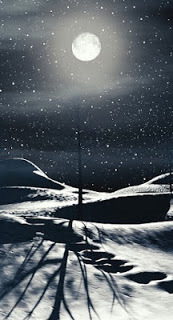 BRIGHTLY SHONE THE MOON THAT NIGHT
BRIGHTLY SHONE THE MOON THAT NIGHTPart One, Part Two, Part Three
Heck is the only cop on duty one very cold Christmas Eve when a trio of deranged carol singers goes house to house, leaving a trail of bloody carnage …
Jen turned the lock and opened up the narrowest of narrow gaps. It was an enormous surprise to see how close the singer was actually standing. He was virtually on the step, his face no more than ten inches from her own. ‘Ahhh … good evening, my dear,’ he said, breaking off from his song. The immediate odour was of halitosis, followed promptly by stale sweat and nicotine. His garb, though reminiscent of a hundred adaptations of Scrooge – a double-caped greatcoat and muffler, a cravat and a high collar, a tilted topper and Faginesque fingerless gloves – was worn and moth-eaten, a pantomime costume purloined from some forgotten cellar. His face was pudgy and discoloured, with overgrown side-whiskers, brownish teeth, and a left eye milky and rolling independently in its narrowed, unblinking socket. Even then, she thought, in some vague way, a wholesomeness might lurk there – that lovely baritone voice! – or might have lurked there once even if now long departed. ‘And a merry Christmas to you,’ he said, in a voice rich and resonant. It bespoke education and breeding rather than the hardscrabble streets of the East End, which seemed to fit with the impression she had of a gentleman gone to seed. She observed the twosome with him. They stood to his rear, one partly behind the other. The furthest away loitered in the gap between the gateposts. Despite the deluge of snowflakes, which continued to obscure much, this was clearly a woman. Not especially tall, about five-foot-six – a little shorter than Jen – but also done up in shabby Victorian garb, and clutching a bundle of rags as though it was a baby. She wore a coal-scuttle bonnet and a drab, floor-length dress, much patched, and was huddled into a ragged shawl. The bonnet completely concealed her face because, all the time Jen watched her, the woman stood with head drooped, motionless even as the flakes gathered on her wool-clad shoulders. The second of the visitors, the one immediately behind the soloist, was much more alarming. From his size and shape, he was clearly male, and he wore a parti-coloured red and green suit, like a harlequin costume, but this too was baggy and threadbare. On his head, there was a red coxcomb hat, which rose to several peaks, all dangling with bells; underneath that, his face was concealed behind a protruding papier-mâché mask, a basic, crudely-made thing whose exaggeratedly moulded and painted features – the axe-blade nose in particular, and the jutting, knifelike chin – denoted the malign visage of Mr Punch. Though perhaps the most disturbing feature of this particular character was the eyes. They were nothing but empty holes, and though real eyes undoubtedly lay behind them, at present they were pits of inscrutable blackness …
THE UNREAL
A ghost-hunting sceptic and devout Christmas-hater opts to spend Christmas Eve alone in a notoriously haunted theatre, midway through the production of A Christmas Carol …
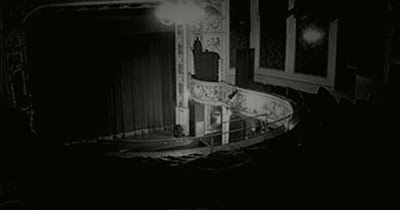
“I have to say, I’ve never really thought the Ambridge haunted myself, and I’ve been a member over forty years. There are no specific stories; it’s just an eerie old building I guess. If there’s any spirit here at present …” Lampwick glanced at the lobby’s festive brocade, “… I’d say it was the spirit of the season. Not that this is always a good thing.” “It isn’t?” Hetherington asked, puzzled by that. “Well, they say Christmas is what you make it … that you get the Christmas you deserve, and all that.” “Good job I don’t do Christmas.” Lampwick headed to the fire-door, muttering something in response that sounded like “Let’s hope it doesn’t do you.” “I’m sorry?” Hetherington asked. “Missed that.” Lampwick opened the door, and a waft of icy air blew in. “I said good luck to you.” “Okay … thanks.” “One last thing,” Lampwick said. “When are you planning on leaving tomorrow?” “First light … half past eight, nine-ish.” “If you throw the breakers back on first, and whichever door you leave through, make sure you close it after you. I’ll be popping in mid-morning on my way to my daughter’s for Christmas lunch, to check everything’s okay. And I’ll put the alarms back on.” Lampwick halted in the doorway. “You’re absolutely sure you want to do this?” Here we go again. “I’m sure. And thanks for your concern, but I’ve done it many times before.” “Not here.” “No, not here,” Hetherington agreed. “But then you don’t believe this place is haunted either.” “No, but then I’ve never stayed here overnight, not on my own.” In the dark, when there’s nobody else here … eh, Mr Lampwick? Lampwick smiled, again as if he’d just read Hetherington’s inner thoughts. Then he departed into the blackness and the snow, shutting the fire-exit door behind him …
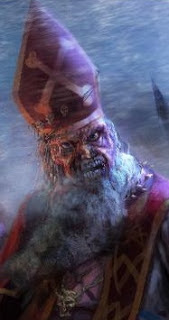 KRAMPUS
KRAMPUS
In the deprived years after the close of World War Two, a German child living in Britain is terrorised by nightmarish Nazi version of Father Christmas …
The street we had just walked along was lined down either side with terraced houses; a perfectly normal street in our part of the world, yet now an increasingly stiff breeze was whipping the snow in eddies – on some occasions I could see as far along it as the coal wagon parked at its distant end, on others no more than thirty yards. I remained there for several minutes, convinced there’d be something to fix on if only I could gaze into the murk hard enough. Intermittently down that street, curtains were only half-drawn, thus allowing rays of soft, warm lamplight to penetrate outward. Without warning, someone passed one of these. I blinked – and they’d gone again, hidden by renewed swirls of flakes. But it was someone headed in my direction. Someone wearing red. It could have been any ordinary person walking home; there was absolutely no need to assume the worst. But briefly I was rooted in place. Only slowly, with great difficulty, was I able to retreat to the edge of the pavement, where again I waited. I don’t know why; it makes no sense now – it was as if I had some inner urgent need to know I was in danger rather than simply fear it. But then something happened that leant genuine panic to my heels. I spied the figure again, much closer this time – maybe forty yards away – crossing the street to the side on which I was waiting. It was only a silhouette, half-glimpsed as it passed through another shaft of flake-speckled lamplight, but it was bent forward in ungainly fashion, its back humped, its heavy robes trailing behind it. There was no further debate in my mind. I spun around and raced blindly along the next street, and along the one after that, regardless of the treacherous footing. I must have covered half the distance home before I stopped to get my breath. I had seen no-one else that whole way, but likewise no-one was in sight behind me either, and now, the flakes having relented a little, I was able to see a good distance in every direction – and spied nothing but snow-covered road junctions, the red-brick gable walls of houses, the weak palls of light cast by streetlamps. Nothing advanced through them, so I felt a little better, though I had yet to cross Dalewood Brow. That place no longer exists today – a supermarket and offices have been built there instead, but in my childhood, it consisted of several hundred yards of derelict colliery land, hummocky and deeply overgrown; a wonderful place for children to play in summer, but in wintry darkness a test of anyone’s nerve …
MIDNIGHT SERVICE
A disillusioned college lecturer spends Christmas Eve marooned in a mysterious and semi-deserted town, where the celebrations are the eeriest he’s ever known …
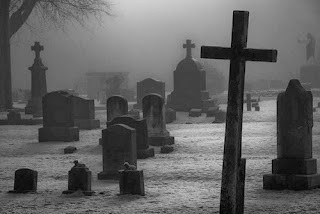
The bigger problem at present was the cold. Never having expected to be outdoors, he was only wearing a lightweight jacket over his shirt. His trainers were already caked with ice crystals, which were fast melting through the rubber and canvas, soaking his socks and feet. It was pure good fortune that he had gloves, but they weren’t much protection in truth. He’d wandered for quite some time by now, and probably wouldn’t even be able to find his way back to the coach station. He glanced around, feeling more than a little concerned, but no fellow pedestrians were abroad to ask. The steadily falling snow muffled all sound, so even if there’d been someone on a nearby street, he wouldn’t necessarily hear them. The occasional car swished by, but they were few and far between. Capstick walked on, entering a small square, on the other side of which stood a row of spike-topped railings with an open gate in the middle, giving through to what looked like a yard enclosed by high buildings, though down at the far end of it a light was moving. It was only a glimmer; from this distance it looked like someone carrying a lantern. As Capstick watched, the clotted blackness down there split vertically as more light spilled through an opened door, widened further to admit the outline of a figure, then narrowed again and winked out. A faint thump was heard. He approached the railings and peered across the yard. The building at the far end looked vaguely churchlike. It was too dark to see any real detail, but its roof was vaulted and there was a spire of some sort. Before he knew what he was doing, he was walking down towards it. Capstick hadn’t been into a church for as long as he could remember and had no religious beliefs. In fact, there was a time when he’d badmouthed Christianity at every opportunity, calling it “abusive superstition” and preferring to ignore the good things it did, such as the provision of charity and shelter. Not that he was going to ask for either of those things now – good God, he wasn’t that far gone! – but he could use some directions, and it wouldn’t hurt to go indoors and get warm for a few minutes. A high stained-glass window on the right implied he was correct about the ecclesiastical purpose of this place, though there was no light behind it, making it look grimy, while several of its panes appeared to be missing. On the left, he passed what looked like a small memorial garden recessed between cliff-faces of brickwork. A central statue grinned at him from beneath a veil of icicles. One stone hand clutched an upright spear; the other extended forward, also covered in snow, but pointing downward. When he reached the main entrance door, he saw a slogan painted in black on the whitewashed bricks above its lintel:
GOD IS JUST
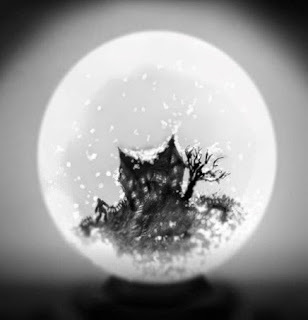 A CHRISTMAS YET TO COME
A CHRISTMAS YET TO COME
A neglectful son lets his aged father die one desolate Christmas Eve and thinks he’s unloaded a burden. But as Christmas comes around again his nervousness grows …
Mike went back to bed, still feeling weak. Chrissie wouldn’t be back from work until five – not that this was anything to look forward to. She found it trying, having an invalid in the house, and did nothing to hide it. That was when he heard the sleigh bells. He sat up from the pillow and looked slowly round at the window. It was open, and beyond it he saw the azure sky of late summer, the rich green leaves on the trees opposite. He heard children playing – still on holiday from school; the sound of someone mowing their lawn. He smelled chopped grass and barbecue coals being stoked up for another glorious evening. Yet sleigh-bells were approaching gaily, along with crisp, clip-clopping hooves. They came to a halt right under his bedroom window. Mike felt his hair prickling but was unable to move to look. The children were still playing, the lawnmower still revving over the turf. At any second, he expected a hearty knock at the door. But the next thing he heard was a foot on the stair. Then another. Stealthy, padding footfalls – as though someone was coming up uncertainly, or painfully. A silvery bell tingled. Mike imagined that shabby, stumbling Father Christmas – holding out a little Yuletide bell, ringing it before him to bring in custom, just like one of those old men paid to stand outside department stores in December. The footsteps were now on the landing, the tingling bell right outside Mike’s bedroom door. It was not closed properly, and someone slowly pushed it open ... Then Mrs. Barnard from next door walked in. When she saw that he was awake she looked relieved. She hadn’t wanted to disturb him, she said. But she felt she had to return the house-keys Chrissie had given her while they’d been away on holiday last July. She held them up in a bunch, and they tingled together – just like bells. Mike swore hysterically at her for nearly a full minute before she turned and fled in rivers of tears. When Chrissie returned from work that evening, she was ambushed by the distraught woman before she could even get into the house, and finally came upstairs in a vexed mood. Mike was still lying in bed, and his wife gave him a good four minutes of her time before she even began to get changed. It was no use him taking things out on her and the neighbours! Just because he wasn’t feeling so good! They had cause to get annoyed with him if they felt like it! But by the time she’d finished, Mike was no longer listening. He was too busy staring out through the bedroom door at the scattered white globules on the landing carpet. They steadily dissipated as he watched them. It was the sort of thing you saw in deepest winter, when somebody had come in with snowy boots on.
 THE TRUSTY SERVANT
THE TRUSTY SERVANT
Office-worker, Wilton, is increasingly disturbed as the Roman temple in the nearby church crypt is excavated. It’s almost Christmas, and the feast of Saturnalia is looming …
It was early afternoon and he was working in his office, when he heard a step on the landing beyond the door. He glanced up sharply. Dowerby and his partner were both away on business, and their secretaries were on Christmas leave, so Wilton should have been the only person in the building. Before he knew what he was doing, he was reaching for the telephone. What happened next, however, practically paralysed him. The handle on the door to his office began to turn. But only slowly. Furtively. Wilton felt sweat break on his brow as he watched. His blood went cold. There was a grunt on the other side of the door, as though whoever was there could not manage to open it. The handle stopped turning and there was a brief silence. Then, the wooden panelling of the door began to creak from some weight being applied to it. Wilton’s spine was literally crawling. He found his fingers fumbling with the dial on the telephone. For ludicrous seconds, he couldn’t remember the emergency code. Then the intruder seemed to move away. Wilton listened to soft but heavy feet, as they padded up the next flight of stairs. He stood up, his heart pounding. The whole demeanour of whoever this person was gave him away as a burglar. The outer doors to the Society Chambers were not locked during the day, but a visit like this was not bona fide. Wilton didn’t know what valuables Dowerby and his partner kept in their offices upstairs, but the intruder was clearly on his way to find out. Without hesitation, Wilton called the police. They said they would send someone immediately, but minutes seem to pass and eventually Wilton began to fear that the burglar would leave the premises before they arrived, or even worse try to get into his office again. It was now very quiet upstairs. Wilton strained his ear as he listened against his door. It occurred to him that he was behaving in a rather cowardly fashion. This might be the thing for a young female secretary to do – call for help and then hide. But would he, as a male, not at least be expected to make some approach to the intruder? What would his employers think if he just let the villain walk away again before the police even arrived? After a minute of agonised indecision, he stuck his head out through the door. The landing was deserted. That was to be expected, whoever it was having gone upstairs. Wilton followed stealthily, praying for the sound of an approaching siren. At the top of the next flight, there was still no sign of anybody, but the door to Dowerby’s office stood ajar. It could have been left that way, but it seemed unlikely. Swallowing hard, Wilton advanced towards it. When he pushed it, it swung open. He entered. There was nobody in there. Wilton was now baffled. He had heard somebody coming up here, hadn’t he? He turned to leave – and found his way barred by a hulking man with mad, staring eyes and a gross beard filled with crawling lice.
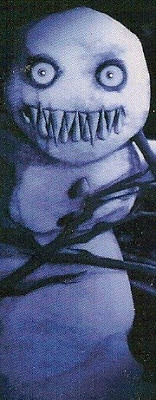 SNOW JOKE
SNOW JOKE
An evil-looking snowman and a book of spells are all that young Jimmy needs to punish his thoughtless dad, but once the means of vengeance is loose, will anyone be safe? …
Charlotte wasn’t coming home this Christmas. She spent most of her time at a place called the LSE, but now apparently, was somewhere called Kathmandu and had recently written to her parents, saying that she considered the yuletide feast a corrupt, western opiate and no longer had any time for it. Mum had cried, and Dad had gone mad, storming around the house shouting something about “the weed” finally getting to “her great, stupid, empty head!” Jimmy hadn’t got cross with Dad on that occasion because both he and Mum, for once, had seemed to be in agreement on it. But it didn’t make any difference: Charlotte was still away for Christmas and would see them some time in the New Year. Once Jimmy had got used to the idea, it hadn’t bothered him too much because it meant that he could spend the first few days of his school holidays digging around among the various odds and ends in her room. That was when he’d found the Tome of Lore. The treasure trove of odd-smelling bric-a-brac in Charlotte’s room, stuffed under her bed, littering her desk and dressing table, had proved a novel distraction at first, but not as much as this particular book, which as well as being full of mucky drawings, also had gross but neat pictures of goats’ heads on tables, half-men-half-monster things, people on crosses upside-down, and animals with unreadable names scrawled underneath them. Jimmy was a bright lad and it hadn’t taken him long to work out what it was all about. He vaguely remembered Dad once having a row with Charlotte over the “voodoo crap” he’d found on the toilet shelf when he’d been looking for his football yearbook. The thing was, Jimmy hadn’t believed that any of it was for real – not until soon after lunch, when he’d gone out into the back garden again and found the snowman missing …
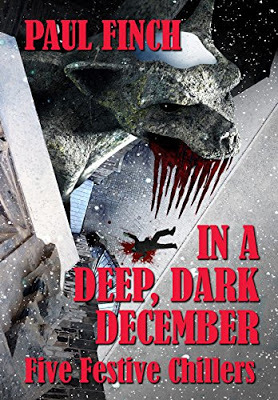 If all that leaves you wanting more, don’t forget that my Christmas e-collection of 2014,
If all that leaves you wanting more, don’t forget that my Christmas e-collection of 2014,IN A DEEP, DARK DECEMBER , is still available for purchase. As I mentioned earlier, German readers can acquire it in paperback if they so wish. Just follow DAS GESPENST VON KILLINGLY HALL .
In case you need any more persuading, here is a quick thumbnail outline for each of the five stories contained inside.
THE CHRISTMAS TOYS: Two burglars target an ordinary suburban house one Christmas Eve, only to awaken the dark side of the festive spirit …
MIDNIGHT SERVICE: A stranded traveller in a desolate town one snowy Christmas Eve. Where can he find shelter? The former workhouse, of course …
THE FAERIE: Timid husband Arthur snatches his young daughter and flees his angry wife across the wintry moors, finally seeking sanctuary in a mysterious snowbound house …
THE MUMMERS: Two men plot an elaborate Christmas Eve revenge by summoning a pantomime from Hell …
THE KILLING GROUND: During an atmospheric English Christmas, man and wife security experts are hired to protect a film star’s family from the cannibal woman said to haunt their new country estate … (Be advised that The Killing Ground is a novella, so if you decide to cough up the 99p price tag, you’re still getting quit a bit of wordage for you money).
THRILLERS, CHILLERS, SHOCKERS AND KILLERS …
An ongoing series of reviews of dark fiction (crime, thriller, horror and sci-fi) – both old and new – that I have recently read and enjoyed. I’ll endeavour to keep the SPOILERS to a minimum; there will certainly be no given-away denouements or exposed twists-in-the-tail, but by the definition of the word ‘review’, I’m going to be talking about these books in more than just thumbnail detail, extolling the aspects that I particularly enjoyed … so I guess if you’d rather not know anything at all about these pieces of work in advance of reading them yourself, then these particular posts will not be your thing.
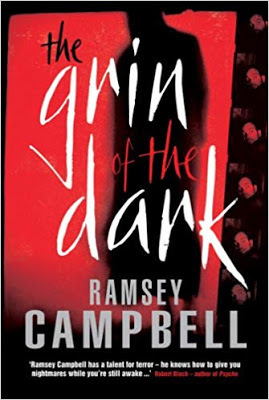 THE GRIN OF THE DARK
THE GRIN OF THE DARK by Ramsey Campbell (2007)
London-based northerner, Simon Lester, feels that he’s on the verge of making a breakthrough in his chosen career of film journalism.
He almost managed it once before when he found himself working for the controversial movie magazine, Cineassed – though all of that went belly-up when Simon and his reckless editor, Colin Vernon, got the mag sued for libel. Since then, Simon’s been employed at a petrol station, with nothing to offer his pragmatic fiancée, Natalie Halloran, other than vague guarantees that all will be well eventually.
But yes … now, at last, it seems to have happened.
High-flying academic, and former tutor of Simon’s, Rufus Wall, offers him a commission to write a film studies textbook for London University’s new line, with a £10,000 advance. Simon finally thinks that he’s arrived, but not everyone shares this viewpoint. Natalie will only believe that her beloved’s career is back on track when she sees it, while her parents – Warren and Bebe, who also happen to be Simon’s landlords – remain steadfastly unimpressed, thinking that Simon should get a proper job, and wishing that their daughter was back with her ex, the smooth and moneyed Nicholas (who also happens to be father to her lively young son, Mark).
Of course, Simon, agog with excitement that someone will finally pay him to do what he loves, brushes all this aside in his quest to find a suitable topic for the new book, settling on the career of one Tubby Thackeray, a British music hall clown turned Hollywood silent era comedian, who eventually was blacklisted because his brand of slapstick was so demented that public order situations arose whenever he appeared (some viewers were even said to have lost their minds).
It isn’t perhaps the wisest choice, because Tubby Thackeray really has been expunged from movie history. Encouraged by young Mark, who catches a snippet of Tubby in action and falls in love with the silent era legend – to an inordinate degree, it seems to us, though Simon, typically, doesn’t notice this – he commences his research, but finds it more of a challenge than he expected. Those who allegedly know about Tubby seem reluctant to talk, and the few bits of written information he can find are located at obscure, antiquarian-type events, where he has to leaf through piles of dead newspapers and deal with increasingly strange personalities.
And that’s another thing about this affair … the strangeness.
From the moment, Simon starts looking into Tubby Thackeray, curious events occur. Any useful intel he finds on the internet seems to change from one viewing to the next. He constantly hears deranged cackling from behind apartment doors or on the other sides of bookstacks. In the corners of his vision, he glimpses creepy, grinning, clown-like men, who seem to find his every move – and especially his mistakes – hilarious. When he finally locates some real footage of Tubby, he thinks it radical and inventive for the time, but also dark and disturbing. Was Thackeray really doing comedy, or something much more sinister?
Meanwhile, there are other distractions. Bebe and Warren Halloran are a constant source of discouragement, while the insufferable Nicholas seems to be showing up ever more regularly, which threatens Simon’s relationship with Mark, though even more so his relationship with Natalie, who is turning progressively cooler with him. It’s also an unpleasant development when Rufus Wall foists a new editor on him – Colin Vernon, of Cineassednotoriety – while Simon also makes the mistake of engaging in a chat-room debate with an anonymous but self-proclaimed expert on the silent comedy greats, who goes by the nickname Smilemime. It’s a futile exercise, but Simon finds himself getting drawn in, wasting more and more time arguing with someone he doesn’t even know, and yet who increasingly appears to know him.
At the same time, the people he meets in real life are no less easy to deal with.
Bolshy Manchester man, Charlie Tracy, appears well informed about Tubby Thackeray, but is an awkward and suspicious individual, who no one would want to rely on unless they had to. And when Simon heads to California, to interview Wilhelmina, the granddaughter of Orville Hart, who directed some of Tubby’s movies, he finds her a coked-out porn queen, whose ranch-like home is populated by nubile females of a distinctly weird and predatory nature (and who – and this is Simon’s real concern, given that Natalie is waiting at home – enjoy putting all their conquests on the internet!).
All this time, meanwhile, Christmas is coming, and Simon feels that a visit home may be necessary, especially when he learns that his native Preston, in Lancashire, once played host to a famous music hall incident, when Tubby Thackery roused the crowd to much more than laughter. But Simon’s home has a cloying atmosphere all of its own, his mother in the early stages of senility and his father unable to cope, while the derelict theatre where they eventually take him is a horror story in its own right.
And all the while, that background strangeness intensifies, the hapless Simon shifting through altered states as he determinedly tries to ignore the phantoms dogging him during his quest to fully expose Tubby Thackeray, a comic genius and an apparent prince of chaos …
A warning from the outset: if you like your horror stories cruel, garish and filled with blood and violence, then don’t bother with The Grin of the Dark . However, if you’re a cerebral scare fan, and you don’t mind a slow-burn atmosphere, you can’t really afford to miss this one.
Not that Campbell is overly subtle. Make no mistake, there is a real horror at the heart of this tale, and it leaks out through the pores as you work your way along. Much of it is intensely psychological, even though there is no question that we are dealing with supernatural forces, and malevolent ones at that. Simon Lester’s mental disintegration is unrelenting, taking us into a surrealist netherworld of obsession and paranoia, where his seemingly harmless quest to research a long-forgotten comedian doesn’t just see him encounter hostility at every turn, much of it disturbingly irrational, but literally awakens demons.
In many ways, The Grin of the Dark is vintage Ramsey Campbell. We’re in a bleak urban environment where, even though we flit back and forth between London and Northwest England, everything is faded and decayed, which is populated by jobsworths and functionaries so unhelpful as to be almost obstructive, and yet, only thinly disguised by this aura of the depressingly mundane, we sense constant, simmering evil, a near-Lovecraftian presence of the bizarre, which we regularly glimpse – or think we glimpse, because, in classic Campbell style, we can never be absolutely sure.
Simon Lester himself is a typical Campbell hero: an essentially well-meaning guy, a workaday everyman, a little introverted and intellectually absorbed, whose pursuits are innocent if niche, but at the same time someone who doesn’t connect easily with others and is therefore mistrusted (and who, on occasion, needs to man up in his confrontations). But he has a good relationship with Mark, his stepson-to-be, while the strong and personable Natalie has seen something in him that she wants to marry, so we are firmly in ‘good guy’ territory. On top of that, you can’t help but root for the bloke when he encounters so much opposition. His soon-to-be in-laws, Warren and Bebe, for example, are frankly hateful, so hostile to their daughter’s choice of boyfriend, so belittling of almost everything he does that it’s no wonder he appears to lack confidence.
We’re also in traditional Campbell country in terms of several classy horror set-pieces.
It’s an absolute staple of this author’s fiction that low-key creepiness will abound, and The Grin of the Dark is completely true to that. But in addition to these lesser but ongoing tortures, we are also plunged into some epic scare situations, including a head-trip sequence in a run-down circus in the heart of wintry London, and most terrifyingly of all – and this scene is Ramsey Campbell at his very best! – an exploration of the derelict Preston theatre, where a sense of fear is palpable from the moment the investigators force entry, but soon becomes utterly overwhelming.
Ramsey Campbell is not regarded as ‘Britain’s Greatest Living Horror Writer’ for nothing, of course. And even in other scenes, where the terror isn’t as full-on, the air of menace stems from an increasing dislocation of reality. For example, a straightforward presentation that Simon makes to a Tubby Thackeray fan-club becomes a nightmarish ordeal. Likewise, his journey to California to interview the hedonistic Wilhemina Hart, which seems to crash head-on into a follow-up trip to Amsterdam, is a triumph of drug and porn-induced disorientation.
Campbell also makes excellent use of a very new kind of monster, the internet troll.
Simon Lester’s ongoing duel with the creepy madman, Smilemime, which he gets into initially for the right reasons because he’s trying to learn everything he can about the elusive Tubby, soon becomes a hellish narrative in its own right. Not every reviewer has favoured this aspect of the novel, calling it unnecessary and protracted, but for me it works perfectly. The smugly arrogant Smilemime is only one facet of the malignancy Simon seems to have disturbed, and it’s a very potent one. This part of the book also serves as a sobering lesson to the rest of us about the futility of engaging online with shallow, nameless narcissists who may demonstrate countless shortcomings – spelling, grammar, etc – and yet who will always win because they are content to spend all day/week/month (as long as it takes) doing nothing other than trying to get the better of their perceived opponents.
All through the book, of course, and this is perhaps the real success of The Grin of the Dark , the evil Tubby lurks close by, constantly on the verge of breaking loose – even though he only physically appears in snippets of crackly film or sepia-toned newspapers. Needless to say, on those few occasions when we do see him, he is a demon lord, seeming to combine every strange and menacing aspect of those heavily made-up, wildly gesticulating comics of the gaslight age, performing antics so outlandish that you can easily imagine it having a damaging effect on audiences not used to such onscreen anarchy.
I should add that not all reviews of The Grin of the Dark have been hugely positive. Ramsey Campbell has a unique style. He conceals clues which, if you miss them the first time around, may mean that you have to roll back a few chapters to check again. Certain readers haven’t appreciated this, though I think it’s an acceptable and clever device. Likewise, others have expressed impatience with the clown factor, calling it a cliché, and indeed there are clowns aplenty in this book, not just Tubby himself, though – and I stress this – these are no axe-wielding maniac clowns of the modern-day slasher variety. All their manifestations are connected to that golden age of comedy, and, once again, to those extreme and harrowing lengths so many silent era practitioners went to in order to immortalise themselves.
At the end of the day, in an age when horror suffers almost permanently from bad press – so many writing it off as gory, derivative nastiness, Ramsey Campbell is still one of the genre’s great breaths of fresh air. A skilled and intelligent writer, he has the ability to lay out deep, macabre mysteries and to invoke genuine chills from the most everyday situations, plucking at nerves we scarcely knew we had, all the while shedding barely a drop of blood.
The Grin of the Dark is a great example of this, recounting a complex but genuinely frightening tale and setting it in a world that closely resembles ours and yet is increasingly and distressingly off-kilter. If you’re a horror fan and you haven’t yet read this one, you really need to.
It’s one of the great puzzles to me that Ramsey Campbell’s work – and it constitutes a vast body – has never (to my knowledge) received any kind of film or TV treatment. I’ve constantly told myself that some kind of adaptation must only be around the corner. His short stories in particular scream to occupy a ‘Christmas chiller’ slot, but in the absence of that, for the moment at least, we can only fantasise – which is what I’m going to do now. Here, as usual at the end of one of my reviews, is a personal take on who should make up the cast-list should The Grin of the Dark ever hit the screen.
Simon Lester – Jack O’ConnellNatalie Halloran – Ellen PageWarren Halloran – Gabriel ByrneBebe Halloran – Veronica CartwrightCharlie Tracy – Stephen GrahamRufus Wall – Dexter FletcherColin Vernon – Chris O’DowdWilhelmina Hart – Jennifer Love HewittTubby Thackeray – Bill Skarsgård
Published on December 06, 2018 04:56
November 15, 2018
Lucy Clayburn may soon be on the screen
 I want to talk a little bit today about my recent change of publisher, and what this will mean for my fictional characters. At the same time, I have some rather exciting, and not unconnected news concerning one of those characters – Lucy Clayburn. And yes, before anyone queries today’s headline, it does involve a potential film/television adaptation.
I want to talk a little bit today about my recent change of publisher, and what this will mean for my fictional characters. At the same time, I have some rather exciting, and not unconnected news concerning one of those characters – Lucy Clayburn. And yes, before anyone queries today’s headline, it does involve a potential film/television adaptation.On a similar subject – novels that certainly should be hitting our screens, even if at present there are no plans for that (and in this particular case I don’t know whether there are or aren’t) – I’ll be discussing Peter James’ new, globe-trotting thriller, ABSOLUTE TRUTH, and reviewing it in my usual forensic detail.
This latest Peter James novel has already caused something of a stir, thanks mainly to its astonishing central premise, but if you want to read more about that, as usual you’ll need to venture down to the lower end of today’s blogpost. Be my guest and do it now, if you wish. But if you’ve got a bit more time, you might want to stick around a little longer and hear what I have to say about my own writing plans and the all-new developments where Lucy Clayburn is concerned.
Change is inevitable
I’m not going to harp on about this too much, because while it’s very important to me, it probably won’t matter a lot to you readers out there. But I thought I might as well mention it on my blog just to ensure that the facts are on record.
I’ve now been a novelist with Avon Books, at HarperCollins, since 2013, and when SAVAGES is published in April next year, it will be the tenth book I’ve written under that imprint.
So, it’s certainly been a busy time at Avon, but it’s also been an incredible one, and a life-changing experience in so many ways.
All along, I’ve been guided by expert editors, specifically Helen Huthwaite, who’s managed to turn me from a roguish reveller in dark fiction ranging widely across the interconnected fields of horror, fantasy, sci-fi and thriller, into a disciplined and focussed crime-fiction specialist, and has teased out of me some of my best characters and most nightmarish scenarios.
I can’t thank Avon enough, and Helen in particular, for recognising my potential and turning me into an official best-selling author.
So why, you may ask, am I moving on?
Well, it’s never a simple thing. It’s not as if I’ve fallen out with anyone or felt that I’m being restricted. It’s just that a change of scene is always good, especially when you’ve been in the same place for rather a long time. And when an outfit like Orion Publishing come calling, you have to take them very seriously indeed.
So, after a few meetings between all concerned, including a couple of particularly exciting editorial sessions, a decision was reached, and an amicable parting of the ways agreed between myself and Avon. It’s not as if they’re short of great writers anyway. Check out Cally Taylor, Scott Mariani, Helen Fields, Jacqui Rose, Mel Sherratt, etc.
But all that aside, I’ve still got one book to bring out under the Avon imprint, and I’m working on it with my editor as we speak.
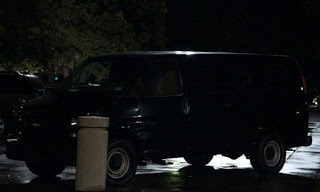 It’s called SAVAGES – at least, that’s the title so far (it could still change) – it pits our Mancunian heroine against a mysterious black van, which travels at night and abducts individuals at random, who knows for what heinous purpose, and again, as I’ve mentioned previously, it’s due for publication next spring.
It’s called SAVAGES – at least, that’s the title so far (it could still change) – it pits our Mancunian heroine against a mysterious black van, which travels at night and abducts individuals at random, who knows for what heinous purpose, and again, as I’ve mentioned previously, it’s due for publication next spring.Now, I’m guessing that one or two people are probably wondering if, because I’ve moved to a different publisher, SAVAGES might be the last we see of Lucy Clayburn? And are maybe asking themselves if KISS OF DEATH , published last August, was the last they’ll see of DS Mark Heckenburg?
No, basically.
I’ve agreed with Orion that I can continue to write for my pre-existing characters under their banner but must add the caveat that the first book they’re looking for will be an original, free-standing thriller, so though you’ll be seeing Heck and Lucy again, it won’t be straight away.
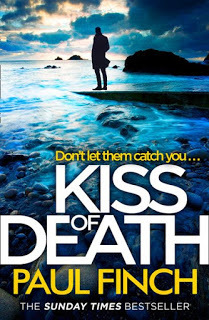 I realise this is not ideal for everyone.
KISS OF DEATH
ended on something of a cliff-hanger, and I’ve received quite a few letters and notes begging me to get on with the sequel. All I can say is that said sequel is already planned in detail, and will appear in due course – but patience will need to be a virtue.
I realise this is not ideal for everyone.
KISS OF DEATH
ended on something of a cliff-hanger, and I’ve received quite a few letters and notes begging me to get on with the sequel. All I can say is that said sequel is already planned in detail, and will appear in due course – but patience will need to be a virtue.Lure of the silver screen On top of that, there’s an even better reason why we need to keep the Lucy Clayburn ship afloat, which is that I’ve now signed a contract with The Shingle Media and Bierton Productions for a screen adaptation of the first three Lucy novels ( STRANGERS , SHADOWS and SAVAGES).
Whether for film or television remains to be seen, but how cool is this development?
Of course, it’s only an option at this stage, which means there are still lots of hoops for us all to jump through, but while there’s been interest before from the visual media in both Heck and Lucy, this is the first time that someone has actually come forward and slapped some money on the table.
I can’t say much more about it than that, except that it all feels very positive and exciting. Already, only a couple of days after the ink has dried on the forms, people have been bugging me about who’s going to play the leads.
Even though I’m always saying that this will never be down to me, and that even if it were, it’s far too early to be thinking about stuff like that, I always give my opinion anyway. I think it was Mark Billingham who, quoting personal experience, told me that if you name an actor you’d love to see play your lead-character often enough, word might reach said actor and that might actually make it happen.
 So, I’ll say it again. There aren’t many actors I feel would make a better stab at Lucy Clayburn than Michelle Keegan. She started in the soap world, but she’s now become a very fine and respected performer in mainstream television. Plus … she’s from Manchester, as is Lucy, she’s aged in her early 30s, as is Lucy, she’s got a tough, streetwise aura, as has Lucy, and yes, hell, let’s admit it, she’s gorgeous … as is Lucy.
So, I’ll say it again. There aren’t many actors I feel would make a better stab at Lucy Clayburn than Michelle Keegan. She started in the soap world, but she’s now become a very fine and respected performer in mainstream television. Plus … she’s from Manchester, as is Lucy, she’s aged in her early 30s, as is Lucy, she’s got a tough, streetwise aura, as has Lucy, and yes, hell, let’s admit it, she’s gorgeous … as is Lucy. In response to who I’d have playing her villainous father, Frank McCracken, I couldn’t think of a better ‘likeable rogue’ character actor than Rufus Sewell. Again, he’s the right age, he’s got the right look, and he certainly has the acting chops.
In response to who I’d have playing her villainous father, Frank McCracken, I couldn’t think of a better ‘likeable rogue’ character actor than Rufus Sewell. Again, he’s the right age, he’s got the right look, and he certainly has the acting chops.But, and I can’t reiterate this strongly enough, I have no official role at all when it comes to casting (assuming we even reach that stage). And why would I have? It’s a 100% certainty that a professional casting director would be vastly better informed than me as to who is available, who is affordable and who has the necessary star-quality to take these roles forward and make any Lucy Clayburn adaptation into a seriously successful piece of film or TV.
But yes, I agree … it’s still fun to talk about it.
THRILLERS, CHILLERS, SHOCKERS AND KILLERS …
An ongoing series of reviews of dark fiction (crime, thriller, horror and sci-fi) – both old and new – that I have recently read and enjoyed. I’ll endeavour to keep the SPOILERS to a minimum; there will certainly be no given-away denouements or exposed twists-in-the-tail, but by the definition of the word ‘review’, I’m going to be talking about these books in more than just thumbnail detail, extolling the aspects that I particularly enjoyed … so I guess if you’d rather not know anything at all about these pieces of work in advance of reading them yourself, then these particular posts will not be your thing.
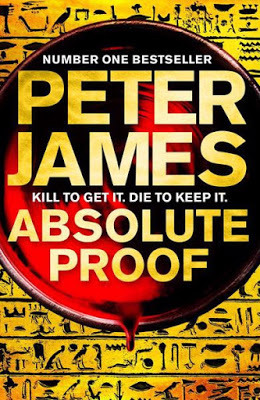 ABSOLUTE PROOF
ABSOLUTE PROOF
by Peter James (2018)
Ross Hunter only learned about the accident that claimed his brother, Ricky’s life when he was working out in the gym several miles away and was suddenly beset with a bizarre vision, which he could never afterwards explain in any rational way.
This doesn’t exactly persuade him that there’s an afterlife, but it certainly leaves him thinking.
After this, the tragedies in Hunter’s life start to come thick and fast. A few years later, while working as a freelance reporter in Afghanistan, his party are ambushed by the Taliban, and though Hunter survives, he is the only one who does, which leaves him doubly mentally scarred by the experience. On top of that, when he returns home, he discovers his wife, Imogen, in bed with someone else.
Years pass, and though Hunter forgave Imogen’s infidelity, the trust they once shared is no longer quite there, even though she’s now pregnant again. His career, however, is going from strength to strength. Now widely respected as an investigative journalist, he chases only the biggest stories and gets fantastic spreads in the broadsheets. This is the reason why he is one day approached by ex-RAF officer and retired History of Art professor, Harry Cook, who offers him the scoop of a lifetime.
In short, Cook tells Hunter that he’s recently been given absolute proof of God’s existence, and that he needs a well-regarded journo to help him tell the story. He reinforces this remarkable claim by adding that he also has a message for Hunter from his deceased brother.
Hunter and Cook meet, and Hunter is startled at some of the personal information the old man imparts to him. This makes him take the stranger much more seriously, though even Hunter, with all that he’s been through, is stunned when Cook presents him with a manuscript, which he says was dictated to him by God during a séance, and which he says contains sets of three coordinates, each one relating to an item or place of incalculable religious significance, but all of which, when finally brought together, will be hugely beneficial to mankind.
The first of these – and this apparently will be the least difficult to locate – is the Holy Grail itself. When Hunter recovers from the shock of hearing this, he learns that the second is a personal but non-specified item connected to Jesus Christ, and that the third will have great relevance to the actual Second Coming. If it wasn’t for Cook’s revelations about Ricky, Hunter would likely as not disbelieve him, but his strange experiences have perhaps primed him to undertake this most momentous of investigations. Even then, Cook is unsure whether or not Hunter is the man for the job, and so at this early stage will only direct him to the possible resting place of the Grail. The rest will follow if this first part of the quest is successful. Before departing, however, he gives Hunter a stark warning that, as their ultimate goal is to bring belief back to mankind, and save all our souls, the power of Lucifer will be unleashed in many forms, no matter how foul, to try and intercept them.
Hunter still isn’t sure if he buys all this – and Imogen certainly doesn’t – but he commences his enquiry anyway, more in hope than optimism. He doesn’t stay tight-lipped about it either, and though, initially, there is bemusement and scepticism – radio presenter Sally Hughes is certainly interested, but Bishop Benedict Carmichael considers the whole thing too risky and attempts to dissuade Hunter from continuing – some powers follow his progress for entirely covetous reasons.
Dr Ainsley Bloor, the CEO of pharmaceutical giant, Kerr Kluge, a committed and aggressive atheist – a guy so committed to this cause, in fact, that he is literally using monkeys and typewriters to try and prove that pure chance was the origin of all things rather than Intelligent Design – is keen to get hold of whatever religious items Hunter can locate to try and make use of them in his development and sale of new medicines. Then there is Wesley Wenceslas, a British-based multi-millionaire evangelist and full-time conman, who would also love to have possession of such holy relics.
Neither of these very dangerous and determined men, among various others – fanatics drawn from all the world’s major religions! – will easily be dissuaded from attempting to possess whatever Hunter uncovers. As such, the first person to die, and only after considerable torture, is Harry Cook, with a high possibility that others will follow in short order.
The stage is truly set for a deadly, continent-hopping adventure, which, in due course, may even take Ross Hunter beyond the realms of this mortal world …
It’s a good thing it was Peter James who undertook to write this book, and not someone of lesser quality. Because when you think about it, a quest to prove the existence of God would likely be the greatest, most challenging mission in history, its outcome of interest to every single man and woman on Earth because there is probably no-one living today who hasn’t at one time or other pondered the existence of an overarching deity, or who hasn’t hoped and prayed that the human experience isn’t solely about our time on Earth.
The question is ... did Peter James succeed? In Absolute Proof , did he do justice to this phenomenal concept?
My personal view is that he did. Not just because this is the most massive novel he’s ever written, in both size and concept, (though it is, clocking in at nearly 600 pages!), or because he suddenly veers away from his more familiar territory of murder mysteries set on England’s South Coast (though he does, venturing clear across the globe), or even because it’s one of his best-written pieces to date (and when you consider that it’s Peter James we’re talking about here, that’s really saying something), but because I found the experience of reading it deeply emotionally affecting.
Ross Hunter is a bit of a neutral character by normal James standards. He’s obviously good at his job, but he’s not much of a fighter: he’s terrified during his sojourn to Afghanistan, he readily forgives his wife’s faithlessness and wordlessly tolerates a nagging fear that the child she is carrying is not his. He’s tough, though, and durable, and prepared to go to great lengths to reach his goal – and that’s the crux of it. Because Hunter, even though he’s no super cool hero, commences this journey on all our behalf, and what a journey it proves to be, taking him across the UK, to North Africa and eventually to America, throwing all kinds of obstacles into his route – both physical ones and spiritual ones – and yet increasingly he feels, as do we, that he’s on the trail of something truly amazing.
Though Absolute Proof is a big, big book, it’s a very smooth read, and I found myself accelerating through it, enjoying every page at the same time as yearning to reach a profound resolution.
Was my soul uplifted?
As I say, it’s an emotionally charged narrative – especially for those who actively seek answers of this sort – and yes, I want to know if God is out there as much as the next man, and as this book gets closer to answering that question than any other work of fiction I’ve ever encountered, I wasn’t exactly discouraged.
I should add that it’s not all completely plausible. The notion that one man could make so much ground so quickly when pursuing the most complex questions of all time stretches credulity a little, though to be fair, he does apparently get help from high places. But to make an issue of this would be to miss the point. The real story in Absolute Proof – as it can only ever be in a quest for God – centres around faith. Both believers and non-believers possess it (the former in His presence, the latter in His absence), and yet both sides struggle with these prescribed positions, because no-one can be certain that they are right, and probably never will be until the day of their death, which is why the search for absolute, undeniable proof is the ultimate human goal.
Inevitably, not all reviewers have approved, some suggesting that Hunter should be much more sceptical in his enquiry, despite his apparent religious experience concerning the death of his brother, some objecting to James focussing mostly on the Christian tradition, some grumbling that they bought Absolute Proof expecting a thriller and found themselves with an Indian Jones-type fantasy. But for me, none of these criticisms carry real weight.
First of all, Ross Hunter is not a zealot; he’s a hard-headed journalist looking for a great story, and so his motives are, initially at least, entirely selfish. It’s only as the immense reality of what he’s doing washes over him that he’s drawn further and further into the complexity of religious belief. No controversy there, I feel.
With regard to the mainly Christian angle, I can only argue that an author must be true to his or herself. Most of us in the West are probably more influenced by Christianity than any other faith (and if anyone tries to deny that, I’ll just ask them what they'll be doing on December 25 this year!), so I don’t think it’s especially outrageous that Absolute Proof relies mainly on the Christian tradition. In any case, the book’s far more inclusive than that may suggest, the theories and philosophies woven into the plot ranging far and wide across the belief systems of the world, strongly implying that all groups pray to the same God, if in different ways (though don’t think that means this book is a sermon; far from it – Absolute Proof abounds with false prophets, the author deeply mistrustful of those who aggressively and mendaciously promote their own holiness).
So ... how does it stand as a novel?
The subtext is all there, but do the characters work? Is it well-written? Is it a rattling good story? It’s packaged as a thriller, so does it thrill? Is it explosive, suspenseful, exciting?
In answer to the first question, Absolute Proof is a Peter James archetype, even if contains very different subject matter from his norm. It’s highly accessible, the flawless, non-flowery prose moving the plot at pace, the very short chapters – some no more than a page themselves – keeping the reader hooked throughout. The author’s easy, reader-friendly style belies the narrative’s great length, so at no stage did I feel tired or bog-eyed, and in fact I was surprised when I found that I’d reached the end, it was that swift a read.
The plethora of colourful characters, many of whom I haven’t had the time to mention here, helped with this.
While the aptly-named Hunter is well-cast as the inquisitive everyman searching for his own salvation, other characters are also representatives. To start with, at either end of the spectrum there are dangerous individuals – like Bloor and Wenceslas – who in a bid to use faith as a means of domination have completely lost their humanity. The pair of them are perhaps overly flamboyant villains, certainly by Peter James’ normal very realistic standards, but they serve a key purpose.
In the middle ground, things are different. There is good and evil there too, but it’s by degrees, the vast majority of the middle-grounders at worst frail, frightened and confused. Egyptian sidekick Medhat El-Hadidy seems like a good man but doesn’t offer help when Hunter needs it most. Wife Imogen is untrustworthy from the outset, but that’s because she's self-centred, which is a very human failing. Bishop Carmichael would love to see evidence that God exists but fears the chaos that might ensue.
And then, in sharp contrast, we have the mysterious Michael Henry Delaney, one of the most memorable figures in all of Peter James’ writing. What a character this is, so well-written that his presence and personality literally exude from the pages. I won’t say more about him than that. You’ve simply got to track him down for yourself.
Absolute Proof is a big change from Peter James’ regular crime-fighting chronicles, but it’s not a nod to his occasional supernatural work either. Readers have likened it to Dan Brown and James Rollins, and yes, it’s that kind of international mystery-thriller, painted on a sweeping canvas and with cosmic undertones. If that’s not your thing, and you try to avoid philosophical or religious thinking – though I say it again, this book does NOT preach – then it won’t be for you. But if you’ve got even half an open mind on these celestial matters, I reckon you’ll find this novel an absolute must.
I’m eagerly anticipating some kind of film or TV adaptation of Absolute Proof at some point, though knowing how long this usually takes, I’m now going to do my usual thing, by sticking my personal oar in on the subject of who should play the leads (just a bit of fun, of course):
Ross Hunter – Oliver Jackson-CohenImogen Hunter – Lucy GriffithsDr Harry Cook – Terence Stamp Dr Ainsley Bloor – Ben DanielsPastor Wesley Wenceslas – Michael SheenSally Hughes – Florence PughMichael Henry Delaney – John O’Hurley
Published on November 15, 2018 00:26
October 28, 2018
How scary can you go on this special night?

This next week is traditionally the scariest in our calendar. It’s Halloween, when all kinds of evil, supernatural forces are unleashed on the Earth.
So, that’s going to be today’s theme. We’re talking spoooooky. At least, that’s the plan.
First, I’ll be delving into my own material, of course – what else, this is my blog? I thought it might be fun to see if my cop writing has ever leaned towards the ghostlier end of the chiller spectrum. You wouldn’t expect it to, but you might be surprised. I’ll also be reviewing and discussing what I consider to be the best supernatural thriller that I’ve read for quite a long time, Sarah Waters’ stunning THE LITTLE STRANGER.
If you’re only here for the Sarah Waters review, you’ll find it towards the lower end of today’s post, as always. Scoot on down there right now, if you wish. However, if you’ve got a few spare moments, you might want to stick around while I navel-gaze for a bit on my own horror output, and join me while I wonder if I continued working through those darker-than-dark themes after I shifted into the world of hardboiled cop thrillers.
Cops n Horrors
People who know me are aware that I commenced my professional career penning scripts for ITV’s long-running police drama, The Bill . So, it wouldn’t really be true to say that I started out as a horror writer.
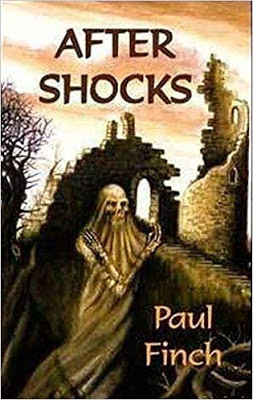 However, even if I say so myself, in the years that followed
The Bill
, I had quite a bit of success writing horror stories and novellas. This was during the 1990s, the 2000s and well into the 2010s. My inaugural collection of short stories,
After Shocks
, won the British Fantasy Award in 2002 for Best Collection. I won it again, for Best Novella (with
Kid
) in 2007, and later that same year, I won the International Horror Guild Award for Best Medium-Length Story with my Green Man-inspired folk-tale,
The Old North Road
.
However, even if I say so myself, in the years that followed
The Bill
, I had quite a bit of success writing horror stories and novellas. This was during the 1990s, the 2000s and well into the 2010s. My inaugural collection of short stories,
After Shocks
, won the British Fantasy Award in 2002 for Best Collection. I won it again, for Best Novella (with
Kid
) in 2007, and later that same year, I won the International Horror Guild Award for Best Medium-Length Story with my Green Man-inspired folk-tale,
The Old North Road
.I still love horror stories, both as a reader and a writer, and I scribble them out whenever I can. Regular followers of this blog will know that I try to post a brand-new festive ghost story on here each Christmas. But inevitably, since I’ve begun writing crime and thriller novels, there hasn’t been as much time for this. Note that it’s not because my interest has changed. In truth, I regard it all as dark fiction, seeing the two sub-genres - thriller and horror - as twisted horns on the same jet-black goat.
But inevitably, as thriller novels have become my bread and butter, that is the area in which I am now primarily focussed. It doesn’t mean, though, that even in this capacity, I haven’t strayed a little bit into the realms of supernatural horror – or something close to that.
No, I’m not going to pretend that my Mark Heckenburg and Lucy Clayburn books are horror novels masquerading as cop thrillers. They are cop thrillers through and through. But on occasion, mysterious and eerie things have happened in them.
Someone asked me the other day: ‘Have you ever put ghosts into your cop novels?’
The answer is a firm NO. Both Heck and Lucy live in the real world. The laws of physics apply, and that’s all there is to it. But I did realise after I’d been pressed on the matter, that I have, on occasion, gone all out to create weird and disturbing scenarios in which I lay on the ghost movie atmosphere as thickly as I can get away with.
Here are two excepts you may enjoy, which sort of – I hope – prove that point.
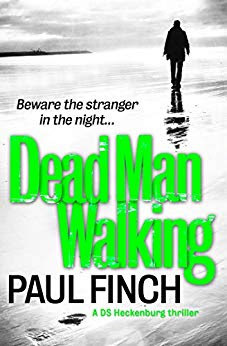 The first comes from the Mark Heckenburg novel,
DEAD MAN WALKING
, which is set in the high Lake District during a bitter and foggy November and sees Heck in pursuit of a deranged mutilation-murderer, the epicentre of whose series appears to be the scattered communities around the isolated Witchcradle Tarn:
The first comes from the Mark Heckenburg novel,
DEAD MAN WALKING
, which is set in the high Lake District during a bitter and foggy November and sees Heck in pursuit of a deranged mutilation-murderer, the epicentre of whose series appears to be the scattered communities around the isolated Witchcradle Tarn:In good weather, this was a stunningly beautiful spot. Fellstead Corrie was a natural amphitheatre in the hillside, its gentle slopes thick with bracken, gorse and springy heather, and ascending on all sides to high, ice-carved ridges. The farmhouse itself stood close to a bubbling pool at the foot of a cataract, which poured from the dizzying heights of High White Stones like a helter-skelter. At its rear there was a network of allotments, greenhouses (mostly dingy with mould and filled with brambles), decrepit barns and sheds which all belonged to Annie, and swathes of overgrown pasture for which there were now no animals to graze upon. The building, which was early eighteenth-century in origin, was large and sprawling, comprising various wings and gables, and built from solid Lakeland stone with a roof of Westmorland slate. Spruced up, it would be magnificent, and in a location like this it would make a superb country house or holiday inn. But in its current state of semi-dereliction, it was an eyesore. Both the walls and roof were crabbed with lichen, the rotted iron gutters stuffed with mosses and bird’s nests.
But of course, none of this dilapidation was visible at present. With the basket over her left wrist and the shotgun cradled under her right arm, Hazel felt her way across the rickety bridge. Fellstead Beck gurgled past underneath, having circled around the farm from the waterfall plunge-pool. A few dozen yards to her right somewhere, it dropped down a narrow gully into the lower valley, eventually at some point – Hazel wasn’t sure exactly where – flowing into the tarn. On the other side of the bridge, beyond a pair of moss-clad gateposts, she entered the farmyard proper, her feet clipping on aged paving stones as she approached the darkened structure just vaguely visible in the fog. When she halted again, the only sound was the distant rushing of water. Meanwhile, not a single light shone from the eerie edifice. In the icy murk, it resembled an abandoned Viking long-hall; the remnant of some Nordic nightmare rather than a family home. Disconcertingly, the darkness beyond its windows seemed even darker than the darkness outside. Annie Beckwith had no electricity, no gas … but surely she would keep a fire in her living room? Didn’t she even have candles? Hazel checked her phone again. It was now after seven-forty. Too early even for Annie Beckwith to go to bed. She approached the front door. If the old lady was sleeping, Hazel didn’t like the idea of disturbing her. But she’d not come all this way to turn back without at least trying to make contact. She knocked several times on the warped, scabby wood. There was no thunderous echo inside; the door was too thick and heavy. Likewise, there was no reply. Hazel tried again – the same. She fumbled for the handle, a corroded iron ring, which, when she twisted it, turned easily. There was a clunk as the latch was disengaged on the other side, and the door creaked open an inch. To open it the rest of the way, she had to put her shoulder against it, grating it inward over the stone floor. This was also a tad discomforting. It wasn’t common practise for folk in this part of the world to keep their doors permanently locked, but surely a lone OAP like Annie would do so at night, especially living all the way out here? ‘Hello!’ Hazel called into the blackness. Again, there was no response. She sidled through, unbidden, and was hit with an eye-watering stench, the combined aromas of grime, mildew and decay. Hazel shone her torch around the room, which was so cluttered with broken and dingy furniture that it was more like a lock-up crammed with rubbish than an actual living space. Dust furred everything, so that colours – the fabrics in the upholstery and lampshades and the many drapes and curtains – were indiscernible, each item a uniform grey-brown. And yet, evidence of the fine old farmhouse this had once been was still there. The fireplace was a broad stone hearth, elaborately carved around its edges with vines and animals, though currently filled with cinders, burnt fragments of feathers and what looked like chicken bones. The mantel above was a huge affair, again constructed from Lakeland stone and heavily corniced, and yet dangling with tendrils of wax from the multiple melted candles on top of it. A mirror was placed above the mantel, so old and tarnished that only cloudy vagueness was reflected there. Ancient sepia photographs hung in cracked, lopsided frames, the faces they depicted lost beneath films of dirt. These added to the house’s melancholy air, but also created the eerie sensation that eyes were upon her. Hazel turned sharply a couple of times, imagining there was someone hidden in a corner whom she hadn’t previously noticed, perhaps peering out through one of those veils of dust-web, eyes bloodshot, yellow peg teeth fixed in a limpid, deranged grin. ‘For God’s sake, woman, what’s the matter with you?’ she said to herself in a tight voice. Her and her bloody imagination. ‘Annie?’ she called out. ‘Annie, it’s Hazel Carter! You know, from The Witch’s Kettle down in Cragwood Keld!’ There was no answer, but her voice echoed in various parts of the house. Immediately on her left, an arched doorway led into a passage that Hazel thought connected with the kitchen and dining room, but the blackness down there was so thick it was almost tangible. She ignored it, moving into the centre of the lounge, only to freeze at a skittering, rustling sound. She turned, just as a whip-like tail vanished beneath the web-shrouded hulk of an age-old Welsh dresser. Hazel had to fight down a pang of revulsion. The place was clearly unfit for human habitation as it was, but if it was crawling with rats as well … A furry, grey body scuttled along the mantle, casting a huge, amorphous shadow as she followed it with her torch. Stubs of candles went flying to the floor, their ceramic holders shattering. The rat leapt after them and moved in a blur of speed down the passage towards the kitchen. There was no question, Hazel decided – they had to get the social services onto this. Annie would hate them for it, but what choice did they have? But this was assuming Annie was still alive. At least there was no sign of forced entry, or that there’d been any kind of struggle in here. Not, if Hazel was totally honest, that it would be easy to tell. She glanced at the brown-stained ceiling, realising with a sense of deep oppression that she had yet to check the upstairs. So unwilling that it was difficult to set her legs in motion, she advanced across the room to a square entry in the facing wall, which led to other rooms as well as the foot of the main stair. She approached it and gazed up. Even without fog, the darkness at the top was impermeable. It seemed to absorb the glow of her torch rather than retreat from it. Hazel hesitated before placing the basket of food on a side-table and, with shotgun levelled in one hand and torch extended in the other, slowly ascended. The hair was stiff on her scalp. It was actually a terrible thing she was doing here; she’d entered someone’s home uninvited, and was now processing from one area to the next with a loaded firearm. But she couldn’t leave. She’d called out and no one had responded, and with the house unlocked, implying someone was at home, she knew there was some kind of problem here. The temptation to call again was strong, but now some basic instinct advised her that stealth was a better option. Hazel reached the top of the staircase. The landing was all cobwebs, bare floorboards and plaster walls, the plaster so damp and dirty that it was falling away in chunks, revealing bone-like lathes underneath. Various doorways opened off it. The doorway to the room that Hazel thought Annie might use as a bedroom was at the end of a short passage on the left. When she directed her torch in that direction, the door was partly open, more blackness lurking on the other side. Someone could easily be waiting in there, watching her, and she wouldn’t see them from here.Despite this, Hazel trod slowly forward, only halting when she was right in front of it. Even close up, the room was hidden from view. There was insufficient space between the door and its jamb for her torch to illuminate anything beyond. But now there was something else too – a faint but rather fetid smell, like open drains. Hazel knew she was going to have to say something. It wasn’t the done thing to barge unannounced into someone’s private room, especially with a gun, not even if you were concerned for their wellbeing. Steeling herself in the face of an urge to hurry back downstairs and leave the building, she spoke loudly and clearly. ‘Annie? Are you all right in there? It’s Hazel Carter … you know, from The Witch’s Kettle down in Cragwood Keld.’ Again there was no response, but the silence was beyond creepy. It was intense, weird; a listening silence. Despite every molecule in her body telling her to flee this odious place, Hazel propelled herself forward, pushing against the door, and as it swung open, entered with torch in one hand and shotgun balanced over the top of it. What she saw in there had her blinking with shock. And then screeching with horror ...
***
Did I hit the Halloween(ish) spot with that? I don’t know. Only you readers can provide an answer.
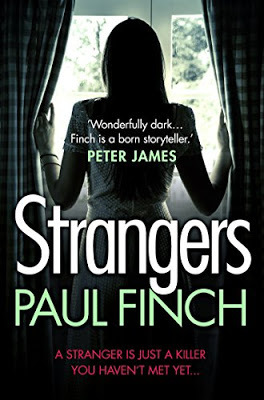 Here’s another example. This one also has an autumnal setting, but comes from the first Lucy Clayburn novel,
STRANGERS
, which sees a young policewoman go undercover as a good-time girl on the back-streets of Manchester at a time when one of the more deranged of the city’s prostitutes is brutally and sexually murdering her male clients.
Here’s another example. This one also has an autumnal setting, but comes from the first Lucy Clayburn novel,
STRANGERS
, which sees a young policewoman go undercover as a good-time girl on the back-streets of Manchester at a time when one of the more deranged of the city’s prostitutes is brutally and sexually murdering her male clients.Nehwal said nothing but waited outside the Lexus, while Lucy stripped off her raincoat and then wrestled her way into the much heavier parka. Once it was on, she zipped it and then tugged up its stovepipe hood, so that her head and face were almost completely covered. She jumped out and they approached the Fiesta side-by-side, though Lucy’s stilettos were hardly the ideal footwear on the softish clay surface, which broke and shifted under their pinpoint heels. They halted by the vehicle’s front-offside corner. In the weak, brownish glow of the interior light, the figure in the front passenger seat was covered by a sheet. That sheet was dingy and blotched with crimson. Nehwal dug a pair of disposable latex gloves from her back pocket, and pulled them on. Then she moved forward to the open passenger window, and reached through, catching the edge of the sheet between two fingertips and trying to pull it. Initially, the sheet resisted but then, slowly, it began to slide free, rancid fold after rancid fold passing down over the inert shape beneath, until it dropped into the footwell. Involuntarily, despite their near half-century of combined experience, the two policewomen grunted with shock. It was an elderly man – quite elderly in fact, maybe somewhere in his seventies – though actual identification would not be easy. His face hadn’t exactly been obliterated, but it was so puffed and bruised and cut, and so much blood had streaked down over it from his dented cranium, that it would have been difficult even for a relative to recognise him. Whoever he was, his trousers had been pushed down to his ankles and his grimy shirt torn open into two flaps; the women didn’t need to look too hard at the gory mess exposed between his thighs to guess at the cause of death. ‘God almighty,’ Lucy breathed. ‘There’s a spool of crime-scene tape in the boot of my car,’ Nehwal said dispassionately, taking her phone from the frontal pouch of her sweat-shirt. ‘We want a perimeter ASAP.’ Lucy made to move but then stopped. ‘Ma’am … what about that idiot we saw running?’ ‘He’s well gone by now, but we need to trace him.’ Nehwal tapped in a number. ‘A male suspect after all, ma’am?’ ‘Unlikely. Unless he had his own clever reasons for pointing us in the right direction.’ ‘A dogger then? Looking for some fun.’ ‘Probably. Doesn’t know how lucky he is he didn’t get it, does he? But he’s a witness … so we need him. Blast it … can’t get a signal.’ ‘Lowest part of town. Reception’s always poor down here. Ma’am … this body looks very fresh.’ Though it broke all the rules, Lucy couldn’t resist placing a knuckle against the corpse’s neck. The banging of her heart steadily increased. ‘He’s still warm.’ Before Nehwal could respond, there was a clatter of woodwork from inside the pump-house. They swung around together, gazing at the gloomy structure. Instinctively, Nehwal pocketed the phone so that both her hands were free. They waited, their smoky breath furling around them. Aside from a renewed popping and fizzing of distant fireworks, there was silence. Nehwal switched her torch on, its cone of light embossing the mossy, red-brick exterior of the old industrial outbuilding, yet intensifying the blackness behind its apertures. Lucy couldn’t help glancing back at the mutilated form slumped in the car. An OAP yes, but the seventh in line, and the others hadn’t been even close to that age. One of them had weighed twenty-five stone, for God’s sake! Two of them got chopped together at the same time! Just how physically powerful was this killer? What kind of chance would they realistically stand in a full-on confrontation, even the pair of them together? ‘Go round the back,’ Nehwal said quietly. ‘Cover the rear exit.’ Lucy nodded and made to move, only for Nehwal to grip her wrist. ‘Go armed.’ ‘Ma’am, I’ve been plain clothes all day, I’ve got no …’ ‘Find something.’ Lucy was initially bewildered by this, but then spotted the way Nehwal was wielding the torch – now like a baton rather than a flashlight. She leaned down and picked up a broken half-brick, before proceeding warily around the exterior, stepping with difficulty through clumps of desiccated weeds and thorns. At the rear, she halted in front of a single narrow doorway, the door itself broken off and lying to one side. Various stagnant odours leaked through the gap: oil, mildew, rotted rags. She listened again. Something creaked inside, very faintly – but that could have been Nehwal progressing in from the front. Unable to believe she was doing this while wearing a skirt, heels and a heavy old coat that wasn’t hers, and with a jagged lump of brick in her hand, Lucy edged forward into the darkness – and almost immediately came to another bare brick wall. From here, she could go either left or right. Theoretically she should have held this point, to ensure no one slipped past. But there was no conceivable way she could allow her boss, who was no more than five-five and in her early fifties, to enter the building alone. Heart thumping, Lucy went left, turning a corner into open space. Nothing stirred in the inky blackness in front of her. Instinctively, she reached for the phone in her pocket, to switch its light on, only to remember that it was in the pocket of the other coat. Not that she was completely blinded; after so long at the bottom of Dedman Delph, her eyes were readjusting quickly. She spied a row of broken windows further to her left, all covered in wire netting. It gave sufficient illumination to show a floor strewn with boxes and piles of old newspapers, and what looked like masses of wood and timber piled against the walls. Still there was no movement, neither from Nehwal nor anyone hiding out in here. Even so, Lucy only shuffled forward with caution. ‘Ma’am?’ There was no reply. Until a fierce red light seared through the windows, a loud series of rat-a-tat bangs accompanying it. More fireworks … but even so Lucy froze. In that fleeting instant, she’d seen a figure standing in a corner. Indistinct but tall – taller than she was – and wearing dark clothing, including some kind of hat pulled partly down over its face. It stood very still between an old wardrobe and an upright roll of carpet. Lucy pivoted slowly towards it. As the firework flashes diminished again, only its outline remained visible – its outline and its face, which, though it was partially concealed, glinted palely, and, she now saw, was garish in the extreme; grotesquely made-up with bright slashes of what in proper lighting would no doubt be lurid colour. An icy barb went through her as she realised that the figure was wearing a mask. It could even be a clown mask. And yet still it didn’t move. Its build was difficult to distinguish, but there was something slightly “off” about it, she now thought: it seemed to sag a little. Injured maybe? Tired? Or playacting? Lucy hadn’t glimpsed any kind of weapon, neither a blunt instrument nor a blade, but the hunk of brick in her hand suddenly felt ungainly and inadequate. She faced the figure full on. There was about six yards between them. At any second, she expected it to lurch forward in a blur of speed, maybe silently, maybe screaming. She lofted the brick as though to throw it. ‘Listen …’ She spoke quietly, calmly. ‘I am a police officer, and I am armed … and you are going to have to show me both your hands.’ The figure made no move to comply. ‘I will tell you one more time …’ ‘Relax,’ a voice interrupted. Lucy jumped as the room filled with brilliant white torchlight. Nehwal stepped in through a connecting door, which in the dimness Lucy hadn’t previously noticed. The DSU’s beam focused itself on the shape in the corner. It wasn’t a living person at all, but a mannequin, an effigy suspended between two corroded bolts in the wall by loops of string tied under its armpits, which explained the odd posture. It was made from an old dark suit and a tatty brown sweater. Its head was a crumpled football, with a plastic mask attached to the front, the latter not depicting the face of a clown but the face of a grinning male with a sharp moustache and pointed beard. The broad-brimmed Guy Fawkes hat looked like a fancy dress shop reject …
THRILLERS, CHILLERS, SHOCKERS AND KILLERS …
An ongoing series of reviews of dark fiction (crime, thriller, horror and sci-fi) – both old and new – that I have recently read and enjoyed. I’ll endeavour to keep the SPOILERS to a minimum; there will certainly be no given-away denouements or exposed twists-in-the-tail, but by the definition of the word ‘review’, I’m going to be talking about these books in more than just thumbnail detail, extolling the aspects that I particularly enjoyed … so I guess if you’d rather not know anything at all about these pieces of work in advance of reading them yourself, then these particular posts will not be your thing.
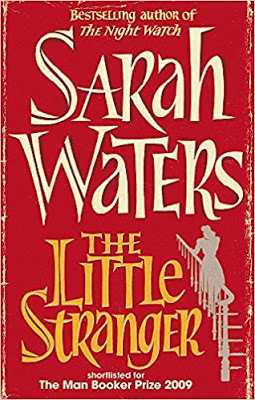 THE LITTLE STRANGER
by Sarah Waters (2009)
THE LITTLE STRANGER
by Sarah Waters (2009)
Rural Warwickshire, the late 1940s. A country doctor called Faraday attends Hundreds Hall, a historic local estate, which he has fond memories of as a child. His mother worked there for a time, as a domestic, and Faraday is still moved by memories of an Empire Day party there back in 1919, when his younger self was so entranced by the 18th century grandeur of the place that he performed a minor act of vandalism, breaking off an ornamental acorn to keep as a memento.
However, things have now changed dramatically. Faraday is shocked to see how badly the house has declined and how overgrown and unkempt its extensive gardens have become, but he keeps this to himself for the time being. He has been called in to treat a maid who has taken a strange dislike to the building and is feigning illness, but he later strikes up a relationship with the widowed aristocratic owner of the property, Mrs Ayres, and her grown-up children, the shabby, eccentric but not unattractive Caroline, and the crippled ex-fighter pilot, Roderick (or Roddie).
A burgeoning friendship follows, as Faraday uses new methods to successfully treat Roddie’s long-lasting war-wounds, but he is unimpressed by the family’s management of the estate, which, even though his own origins are humble, he considers a grand property and a great landmark in the district. In time he learns that the cause of this lies not so much with Roddie’s ineptitude – though that is also a problem – but with the family’s rapidly dwindling finances. A new era is dawning, complete with a determined and belligerent Labour Government, and what remains of the English rural gentry must diversify into successful business ventures in order to generate new income, or it will simply die out. The ageing Mrs Ayres, ‘a true Edwardian at heart’, regards all this with a fatalistic gloom, as though resigned to her fate, Caroline feels the solution is to sell things off (various family heirlooms and considerable portions of the estate have already gone under the hammer), while Roddie becomes ever more cynical and stressed.
Faraday, a relative newcomer, continues to observe these unfolding problems rather than participate in their attempted resolution, but he is present when Caroline’s loveable Labrador, Gyp, unaccountably attacks and mauls a visiting child, and in response to strident demands from the authorities – and in a truly heartbreaking scene – assists in putting the animal down.
The tragedy brings Faraday and Caroline closer together, though romance still feels elusive, but Roddie responds by sinking into a trough of drink and despondency. Faraday suspects this is due to self-loathing stemming from the young man’s inability to reverse the estate’s failing fortunes, only for Roddie to then insist that some malign entity invaded his bedroom on the night of the dog-attack and that, if he allows it to, it will switch its hostility to his mother and sister. The rest of the family are bewildered, but then burn marks are discovered on the walls and ceiling of Roddie’s bedroom, and one night, Caroline detects a smell of smoke and finds the entire room ablaze.
Roddie, so drunk that he didn’t even notice, continues to rant that a mysterious, malevolent being regularly visits their home, and in due course, again with Faraday’s help, is committed to an asylum, where he quickly makes himself at home because he can no longer stand the thought of residing at Hundreds.
Caroline and her mother are left so distraught that they struggle to maintain interest in the state of their house and are unconcerned by how the rest of the county views them – both of which were formerly big issues – so Faraday becomes more and more involved, particularly in regard to Caroline, whom he increasingly suspects he has fallen in love with. Caroline responds in kind, though is less enthusiastic overall, at times seeming confused about her feelings rather than enamoured with the new man in her life.
Meanwhile, the haunting – if that is what it is – appears to intensify. Weird, juvenile writing is discovered on the walls, the maids are summoned by bells rung from the abandoned nursery, phone-calls are received in the early hours of the morning – apparently from no-one, and, most chillingly of all, a weird, malformed voice is heard burbling on the other end of a long-defunct communications tube that still runs through the heart of the house.
Faraday is aggressively dismissive, mocking Caroline’s notion that some kind of curse or taint is affecting the family’s fortunes, and openly worried by Mrs Ayres’ belief that the ghost of her long-dead first daughter, Susan (or Suki), has returned to her family home, which he suspects is a sign of mental disintegration. Things almost come to a head when the elderly matriarch has a particularly terrifying experience in the nursery – a hair-raising scene by almost any standards – and is physically injured in her attempts to escape.
Faraday is frustrated, considering much of this a distraction from his new purpose in life, which is to marry Caroline – who is still only vaguely agreeable to his proposal – and take charge of the crumbling estate in order to rescue it.
But even Faraday cannot ignore the next ghostly event. No-one can. Mrs Ayres, who never really recovered from her ordeal in the nursery, and who has now relapsed into a distant, dreamy state, repeats her conviction that the ghost is Suki, who may be unaware that her visits are causing damage, but who is essentially a good spirit, seeking only the love and companionship of her lost mother.
Mrs Ayres could not be more wrong …
Let’s get to it directly. The Little Stranger is one of the best ghost stories I’ve ever read. But it’s actually a lot more than that. No-one could seriously expect a stylish literary writer like Sarah Waters to pen a supernatural novel with no more intent than to frighten her readers.
When you pick up The Little Stranger – though you will be frightened trust me – you’ll also find yourself immersed in the decaying world of the landed gentry as the second half of the 20th century dawns. This isn’t just to be found in the Ayres family, who for all their wartime service are so incapable of living well in the ‘post feudal’ era of the new modern age that we suspect they must perish, but in the nouveau riche Baker-Hydes, who have the money but not the manners, and in Doctor Faraday, the educated commoner from rustic stock, who, though he initially likes the Ayres, gradually finds his power and influence over them growing, and starts to enjoy it. Throughout, the narrative is dominated by the imposing structure of Hundreds Hall, which initially appears to us in happier times as a grand ‘wedding cake’ of a country mansion surrounded by acres of manicured parkland, but later as a gloomy, dilapidated edifice accessible only through a dank, dreary wood. If that isn’t a metaphor for the collapse of the privileged class in postwar England, then I don’t know what is.
First, though, let’s talk about the actual ghost story.
The ability to inflict a genuine chill on your readers is a rare one. Not every horror or thriller writer possesses it, so I took real pleasure in discovering that Sarah Waters, who hasn’t strayed often into this kind of darkness before, does.
Though the author has a much bigger job on here than merely telling a spooky yarn, none of it would have worked if the ghostly elements in The Little Stranger hadn’t been frightening. Thankfully, in seeking to achieve that effect, she emulates one of literature’s great mistresses of the ghost story, Shirley Jackson, by opting for the ‘less is more’ approach.
When eeriness first arises in Hundreds Hall, it is very subtle, very slight, barely detectable even – especially as all the characters have so many more important issues to content with, but one by one, as they fall victim to it, their unease spreads to the reader.
Questions abound, however.
Is there really a supernatural presence in Hundreds Hall? If so, why is it only manifesting now? Even when an explanation of sorts – the ghost of deceased daughter, Suki – is provided by the dazed and confused Mrs Ayres, the question remains: Why is it so malicious?
Even then, for the longest time, this mystery seems almost inconsequential. The deterioration of the family and their property is a much more serious problem. Faraday’s attempted wooing of the stand-offish Caroline occupies centre-stage, and rightly so; she is the only one who can get things back on track, but only, he suspects, if she will accept his courtship, because she too is scatty in many ways. Even after Roddie’s breakdown, which he squarely lays at the door of an evil spirit, it seems more likely to us – because we witness no supernatural occurrences – that the son of the house has finally succumbed to the combined horrors of his wartime ordeal and his abject failure to restore the family’s pride.
After this, of course, things change, genuine haunted house type phenomena occurring more frequently. The curious writing on the wall is reminiscent of the real-life Borley Rectory, which only burned down nine years prior to the commencement of this story. The ringing of the servants’ bells when there is nobody there may take us back to the opening scenes of A Christmas Carol , but there is no good humour to be had here, because the terrible voice on the communications tube, and the growing conviction that a baleful intelligence is coming and going as it wishes, soon takes us into full-on psycho-supernatural territory, reminding us of classic chillers like Shirley Jackson’s The Haunting of Hill House , Henry James’ The Turn of the Screw and Richard Matheson’s Hell House . It’s certainly the case that by the last quarter of The Little Stranger , you wouldn’t want to be marooned in Hundreds Hall, a gaunt, dreadful relic of the past, seemingly cut off from modern civilisation. When the ‘Little Stranger’ actually appears, it’s a ghastly and harrowing moment, which leaves everyone sickened with fear.
Everyone except Faraday, that is. Which brings me neatly to the characters, and the main two protagonists, Faraday himself and Caroline Ayres.
While Faraday is our central character, he’s not exactly the hero of the piece. If anything, he is more the yardstick by which the decline of the Ayres family and the dereliction of their once magnificent family home are measured. He was the one who attended Hundreds for that wonderful Empire Day celebration so many years prior to the main narrative. He is the only non-Ayres personality who falls in love with the estate – so much so that he even takes a bit of it away with him (which upsets his mother because, though he’s clearly enamoured by the place, such a deed implies covetousness rather than deference).
All that complexity aside, Faraday is a fascinating and multi-layered character. As a doctor, you’d think him a pillar of the community; a well-spoken, well-regarded chap in whom anyone could confide. But the class factor comes into play here too. Faraday, who is not the Ayres’ first choice doctor, attempts to ape the breeding of his hosts, but innately lacks it. He is also an intemperate man; he carries grudges and when he doesn’t get his own way, resorts to private but heavy drinking. He’s an efficient and reliable doctor, but he is also a hardcore rationalist, and this – a deliberate ploy by the author – becomes tiresome as the tale moves on, the entire family soon living in fear of a supernatural adversary, but Faraday continually and testily dismissing the whole thing as nonsense, finding vapid explanations for some of the most mysterious happenings.
He also lacks self-awareness, blissfully unaware that such an attitude is an implied criticism of the family, at the same time as clumsily courting Caroline Ayres, in his own mind very successfully, though to the readers it’s an evident disaster. When on occasion, his frequent presence at Hundreds Hall is queried, he fails to understand why the family might deem him intrusive.
In contrast, Caroline Ayres, is a more traditional but perhaps more-flawed-than-usual heroine. She is all that remains of the great family, but there is no glamour to her, and little in the way of wisdom or spirit. But she is determined and brave, and even when almost everything else has gone, her common sense remains. Towards the end of the book, Caroline, worn almost to the bone, is literally the last bastion of the Ayres family name. It’s quite a responsibility if you care about these things, as we readers have come to at this stage.
She also goes on a similar if opposite journey to Faraday. Even though her growing fear that something evil is dogging them takes much longer to manifest that it does with her mother and brother, she becomes – in a great twist of irony – progressively more realistic than her suitor. He may mock her eventual conviction that they are somehow cursed, but Caroline handles her problems by whittling down her hopes and expectations, and planning a more frugal future, while Faraday’s ambitions grow steadily more preposterous.
The Little Stranger is an amazing piece of writing, and it’s no surprise to me that it was short-listed for the Booker Prize. It’s hard to classify, for sure. I only tend to cover what I call ‘dark fiction’ on this blog, but it fulfils every aspect of that, even if it is many more things besides.
You just have to read it. Whether you’re a ghost story fan, or not, you won’t be disappointed.
I normally sign off on my book reviews with some fantasy casting, selecting the key characters and telling the world – which obviously will pay scrupulous attention – who I’d choose to play them onscreen. But, as I write, a movie version of The Little Stranger is already doing the rounds on the cinema, so any thoughts from me on the matter would be even more irrelevant than they usually are.
Published on October 28, 2018 02:45
October 8, 2018
Catch yourself a bunch of killers - for 99p

We’re talking evil killers this week (for a change, I hear you all say).
But no, seriously … today’s blog is going to focus on heinous murderers and their gruesome deeds. That’s partly because it’s the main theme of the latest Heck novel, KISS OF DEATH, which I have some news about that you may not want to miss. It’s also because, name by name, I’ll be bringing you details of the very worst offenders on the actual ‘Most Wanted’ list that features in the new novel. And lastly, it’s because I’ll also be offering a detailed review and discussion of Chris Petit’s brutal and disturbing wartime crime thriller (which is also packed with fiendish killers), THE BUTCHERS OF BERLIN.
If your main interest is the Chris Petit review, don’t worry about it – you’ll find it, as usual, at the lower end of today’s blogpost. Just hasten on down there and get stuck in. If you’re also interested in the Heck news though, then stick around for a bit.
Get it cheap
The first and most important thing to say today is that KISS OF DEATH has done very nicely indeed since its launch in August. As I write these words, it resides in the Top 50 on the Kindle paid-for chart (is No. 1 in ‘Vigilante Justice’ - I know, I didn’t think any such thing existed either), and can boast a 5-star strike rate of 86% thus far. That means I’ve got an awful lot of satisfied customers already, which I’m very grateful for. But of course, I’m even more grateful for those of you who’ve bought the book, even if you haven’t yet reviewed it. For those of you still considering, be advised that it’s now available on Kindle for 99p, and will remain so until the end of this month (October, 2018).
So, if you weren’t sure before, maybe that’ll tip the balance. Get it while it’s cheap.
Worst of the worst
One of the key plot-lines in KISS OF DEATH , meanwhile, is the development of ‘Operation Sledgehammer’, which concerns the creation of a British ‘Most Wanted’ list, comprising the 20 most dangerous British criminals still on the loose and believed to be dwelling somewhere in the UK. The team of which DS Mark ‘Heck’ Heckenburg is an integral part, the Serial Crimes Unit, who are basically facing the axe thanks to rampant police cuts, are charged with bringing every name on that list to justice in as short a time as possible.
It’s a work of fiction, of course, so this involved me having to come up with my own list of deadly felons. That isn’t quite as straightforward as it sounds, but I won’t pretend that it wasn’t a lot of fun doing it - in a strange, dark and twisted kind of way.
Here, for want of a better term, are the ‘stars’ of that list, the sort of individuals who even Heck and all his cronies would be stiffly challenged by. And remember, in KISS OF DEATH, they have to collar ALL of them - no excuses - or it could be their jobs:
 Eddie Creeley: A Humberside underworld enforcer who diversified into armed robbery, and
Eddie Creeley: A Humberside underworld enforcer who diversified into armed robbery, and proceeded to hit a number of banks and security vans. In all cases, Creeley’s crimes were noteworthy for the extreme violence he used against bank staff, witnesses etc. In one case, the wife of a bank manager was held hostage and injected with battery acid, which inevitably killed her, while two security guards were beaten and injected with drain cleaner, one dying, the other suffering severe brain damage.
Leonard Spate: A part-time taxi driver in Workington, who raped and beat a woman to death after picking her up at a local nightclub. Arrested on suspicion, he escaped from custody before he could be charged, violently beating a young policewoman in the process. He later raped and strangled a prostitute, after holding her hostage in her own home, and then burned down the house afterwards, which also claimed the lives of her two children, who were sleeping there at the time.
Terry Godley: A lifelong violent criminal, who, while serving time for earlier offences, was classified ‘one of the most dangerous individuals in the UK prison system’. Godley hadn’t been out of jail long when he carried out an armed car-jacking in Nottingham. There were two teenage boys in the vehicle at the time. Both were later found dead, having been made to kneel before being shot through the back of the head, execution style.
 Henry Alfonso: Otherwise known as ‘the Creeper’, Alfonso was a prolific burglar from Canning Town, London, who always went about his business wearing a ski-mask and carrying a butcher’s knife. Though he often stole, his main purpose was to commit rape. Targeting student premises and women living alone, all of which he had noted and watched carefully beforehand, he was active for several years before he was identified, hitting as many as 50 targets, maybe many more.
Henry Alfonso: Otherwise known as ‘the Creeper’, Alfonso was a prolific burglar from Canning Town, London, who always went about his business wearing a ski-mask and carrying a butcher’s knife. Though he often stole, his main purpose was to commit rape. Targeting student premises and women living alone, all of which he had noted and watched carefully beforehand, he was active for several years before he was identified, hitting as many as 50 targets, maybe many more. Patrick Hallahan: A bodybuilder turned heroin addict, whose craving for smack led him into ever more violent crimes, which he often carried out in a semi-crazed state. Such was his condition, when, armed with a pistol and a shotgun, he held up a McDonald’s restaurant in Slough. It was a weekend lunchtime, so the diner was crowded with families. Fearing for their children, two men tackled him. Hallahan responded by shooting and killing both, and then killing a member of staff before fleeing.
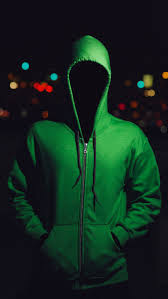 Christopher Brenner: The self-titled ‘Priest of Pain’, Brenner - a former soldier and nurse - was, by his own admission, a sado-masochist, who several times was reported to the police for assaulting and brutalising sex-workers. He eventually went on the run when a severely emaciated woman escaped from the cellar of his Luton house. Responding police found two others chained down there. All had been repeatedly raped, tortured and starved to the point of near-death.
Christopher Brenner: The self-titled ‘Priest of Pain’, Brenner - a former soldier and nurse - was, by his own admission, a sado-masochist, who several times was reported to the police for assaulting and brutalising sex-workers. He eventually went on the run when a severely emaciated woman escaped from the cellar of his Luton house. Responding police found two others chained down there. All had been repeatedly raped, tortured and starved to the point of near-death.John Stroud: A one-time runner for the Birmingham mob, who later turned enforcer, Stroud was sentenced to 15 years for his part in the botched assassination of a crusading newspaper reporter, but released after serving just over half of his sentence. No longer wanted by his former firm, he took it out on the two uniformed police officers who’d originally arrested him, ambushing them in their patrol car after calling in a fake accident, and shooting both of them dead.
Malcolm Kaye: The only real serial killer on the list, Kaye was already a prolific sex offender when he was charged with strangling four prostitutes in Liverpool, having struck all of them with a hammer first, and attempting to murder a fifth by battering her with a pipe. Suspected of an earlier attack in which a Liverpool housewife was strangled in her own home, he was being escorted from prison to a police station for further interview, when he escaped from custody and went on the run.
A motley crew, to be sure. Maybe too much even for Heck to bite off and chew. You think so? Well, sorry to be boring, but there’s only one way you’re going to find out. As I said earlier, this is a good time to snaffle a copy of KISS OF DEATH . It’s only 99p on Kindle at the moment, but the deal will only last until the end of this month.
THRILLERS, CHILLERS, SHOCKERS AND KILLERS …
An ongoing series of reviews of dark fiction (crime, thriller, horror and sci-fi) – both old and new – that I have recently read and enjoyed. I’ll endeavour to keep the SPOILERS to a minimum; there will certainly be no given-away denouements or exposed twists-in-the-tail, but by the definition of the word ‘review’, I’m going to be talking about these books in more than just thumbnail detail, extolling the aspects that I particularly enjoyed … so I guess if you’d rather not know anything at all about these pieces of work in advance of reading them yourself, then these particular posts will not be your thing.
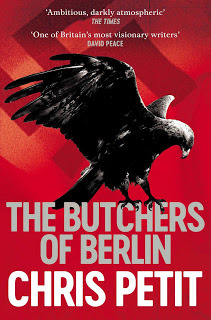 THE BUTCHERS OF BERLIN by Chris Petit
(2016)
THE BUTCHERS OF BERLIN by Chris Petit
(2016)
August Schlegel is a young detective with the Berlin Criminal Police. But this is no ordinary time to be a copper. It’s 1943, and the tide of the war is turning against Nazi Germany. The capital city is now regularly bombed, there is nothing but bad news from the front, and the government is virtually in hiding. The population meanwhile, attempts to lead as normal an existence as possible, but is hungry, weary and increasingly lawless.
Schlegel, himself, is a poor specimen of a police officer. Half English on his aristocratic mother’s side, he’s still a loyal German, but earlier in the war, rather foolishly, he was lured into joining the Einsatzkruppen, a mobile police battalion whose job was follow the army advancing into Russia, under the impression that he’d be rounding up partisans. Instead, he found himself participating in the firing squad massacres of civilians, mainly Jews. So horrendous did Schlegel find this work that he suffered a severe nervous breakdown, his hair turning white overnight. Sent home to recuperate, he was placed on ‘light duties’ in the form of attachment to a low-priority financial crimes unit.
Now, however, somewhat inexplicably, he is summoned by Homicide boss, Stoffel, to a murder/suicide. It’s a curious case, an elderly Jewish war-hero, Metzler, killing his building’s block warden by shooting, and then taking his own life. Stoffel explains that Schlegel has got the job simply because he was in the police station at the time, but that doesn’t explain why the case is being investigated at all. Metzler, the perpetrator, is dead already, and in any case, there are now daily round-ups, those few Jews remaining in Berlin being systematically deported to the east; why bother trying to prove that a Jew was responsible, because it won’t matter either way? Police Chief Nebe will shed no light on it and is vexed when questioned. Even more mysterious, is the arrival of the black-uniformed Eiko Morgen, a member of the SS judiciary, who declares that he’s now Schlegel’s partner in the investigation but declines to explain why or under whose authority.
No sooner has this unlikely duo embarked on their enquiry than further murders follow, both men and women slain, and these killings are infinitely more grotesque, the bodies found flayed, dismembered, and sometimes with money stuffed into their orifices. The convoluted enquiry, which is much distracted by daily events in a near-anarchic city where everyone is corrupt and no-one trustworthy, eventually leads to a hideous old slaughterhouse, where an oddball collection of workers is quick to blame the crimes on a gang of Jewish butchers, who were seeking to sew discord in the city but who now can’t be traced as they’ve all been deported. At the same time, just in case this dead-end doesn’t put paid to the enquiry, Stoffel pulls in a half-witted criminal who is willing to plead guilty to all the crimes, and many more, on the condition that he’ll be sent to a hospital rather than the guillotine.
Morgen, for one, is unconvinced, certain that the suspect is too dim to have carried out so many killings successfully and feeling that he’s been framed for the sake of convenience. When more murders follow, Nebe’s solution is simply to cover them up, Morgen and Schlegel feeling more like undertakers than detectives, but nevertheless continuing to investigate, their suspicions crystallising around a possible smuggling/counterfeiting ring and leading them back, almost inevitably, to that dingy slaughterhouse.
While all this is going on, in a parallel thread, we follow the fortunes of two young German women. Lore and Sybil are not just Jews, but lesbian lovers, which also makes them persona non grata in the eyes of the Nazis. If that isn’t enough, Sybil is a witness to the Metzler shooting, but daren’t come forward because she’s only surviving in Berlin by the skin of her teeth as it is. The duo moves about continually, just below the notice of the authorities, but are in danger all the time and suffer constant harassment and abuse. In due course, they are separated, and Sybil finds herself at the mercy of ruthless Gestapo chief, Gersten, who adds her to his cadre of so-called ‘catchers’, a group of alluring Jewish women – headed up by the ultra cold-hearted Stella Kübler, (‘Blonde Poison’ as her paymasters call her, and as they called her in real-life, because she was an actual person!), who are allowed to live in comfort and safety so long as they inform on their own people.
In a world where only the callous and vicious seem to prosper, Gersten is one of the worst people Sybil has ever met. But she isn’t alone in that assessment. Gersten’s name increasingly crops up in Schlegel and Morgen’s enquiry, neither of the investigators liking him, though both are wary of the power he wields.
Meanwhile, the murder victims pile up, the bombs continue to fall, and all around them the madness of a declining, collapsing society rages on. The mystery deepens steadily, Schlegel increasingly convinced that whatever conspiracy lies at the heart of it will only be exposed under the costliest circumstances. And at this stage, he doesn’t know the half of it …
The first thing that struck me about The Butchers of Berlin was how harrowing (and presumably how realistic) a portrayal it is of a city teetering on the edge of damnation.
It’s the very height of World War II, but the war itself seems a long way away; German troops are fighting, but still on distant battlefields, there are only two bombing raids (though both are colossally destructive), and there is little discussion about military tactics or the fortunes of the nation, other than a resigned acknowledgement that the armies of National Socialism are finally in retreat. But the consequences of Hitler’s insane policies have bent a once cultured German society out of all shape and recognition. Little has been done to improve the city’s industrial infrastructure since the cash-strapped days of the Weimer Republic (and the bombing has flattened much of that – so, queue some very neat evocation of German cinematic expressionism by Chris Petit, who is also a renowned film-maker!). Wounded and deranged men lurk everywhere. Rationing and shortages have cut deeply into the heart of normal life. Most folk are impoverished, the black market is flourishing, crime rates have soared, and there is violence and rowdiness on the rubble-strewn streets – not everyone, it seems, is cowed by the Nazis. Meanwhile, everyday morality has virtually disappeared. The criminal police are incompetent, uninterested and most of the time drunk. There is widespread prostitution and depravity, racketeering and dishonesty are commonplace, the all-licensed Hitler Youth are running wild (behaving in lunatic and degenerate fashion), and when someone disappears it is simply accepted that they’ve been ‘sent to a camp’, with no-one especially concerned about where or why.
And then of course, there are the pogroms.
Those few remaining Jews who don’t wish to be rounded up and deported indulge in all kinds of chicanery, bribery, concealment and impersonation to remain at liberty, and even then, must tough it out in ways that only a few years earlier they’d have found intolerable. This is nowhere better exemplified than in the traumatised characters of Sybil and Lore, who have come to accept rape and blackmail as a daily occurrence and are more than willing to participate in pornography so long as it buys them a meal. Respectability as a concept no longer has meaning. Instead, survival is all. Even the upper class, as represented by Schlegel’s mother and her friends are faking it, partying, gossiping and affecting a façade of mischievous superiority, while at the same time, lying, cheating and playing constant games of one-upmanship simply to maintain a semblance of the lifestyle they once knew.
Berlin in 1943 is truly a city of ruins. A socio-political Hellscape where the population live like rats in anticipation of the approaching Apocalypse.
Against this Dantean backdrop, August Schlegel is almost an incidental character, partly because Chris Petit consciously imbues him with few redeeming features. He’s not an evil man – that’s about the best you can say for him, but he’s weak and tired and torn by his conscience. He’s also, for much of the narrative, a passenger, confused by the unfolding mystery as he travels on the coat-tails of Eiko Morgen, who is probably the first SS character I’ve encountered in fiction to elicit some degree of sympathy, though this isn’t easily won.
Morgen initially appears as a sinister hardcase, both intellectually and physically; he’s secretive, he’s cold, he’s far from friendly, and though he becomes an ally of Schlegel’s, he never really amounts to more than that – he’s certainly not what you’d call a companion. But it’s often a relief to see him, because whenever Morgen is present, the forces of darkness gathering around our main hero appear to retreat a little. Even so, because we never really know who Morgen works for – it could be Heinrich Himmler himself! – we’re never sure that Schegel should fully trust him, even though we’re glad he’s there.
But this is par for the course in a book where almost everyone is flawed, or at least compromised. We already know about Schlegel’s history as an Einsatzkommando, which, even though he was fooled into it and even though he is tortured by regret, is a ghastly blot on his soul. At least Schlegel has a conscience, though. In contrast, fellow cops Nebe and Stoffel are pathetic examples of public servants who after years of genuine service have now opted for the easier course, towing the party line, subverting the law, framing the innocent, and passing the buck at every opportunity. Even the Jews themselves display vengeful and villainous traits, Metzler shooting one of his persecutors through the eye, Stella Kübler, the senior Jew-catcher, much more then just a femme fatale, a literal black widow who revels in her status as a sexually empowered predator.
Then we have the actual villains, of course, such as Gersten and his lackeys, who are every bit as evil as you’d expect. The Gestapo chief epitomises that weird contradiction of Nazi Germany, wherein apparently civilised but in fact deeply maladjusted individuals used newly acquired power, which they’d never really earned, to pretend they were still pillars of their community while at the same time behaving like raving, demented beasts.
By comparison, heroines Lore and Sybil are almost impossibly innocent, the former tragically overconfident that they will somehow make it through this maelstrom, the latter more easily frightened and thus more circumspect about their chances. I don’t want to say too much more about the female leads, because that would give away an unconscionable amount of story-line. Suffice to say that, despite Schlegel’s best efforts, they are torn from pillar to post, and that much of the terror and suspense, which ramps up dramatically in the second half of the book, comes at the expense of Sybil in particular, whose attempts to preserve her own life are increasingly desperate and miserable.
It’s a grim fact of The Butchers of Berlin that the brualisation of human beings, both in mind and body, is never stinted on – and that doesn’t just end with the mutilation victims.
Not everyone has taken to this, some reviewers commenting that it isn’t so much a wartime thriller as a horror novel, others calling it insensitive to the real atrocities perpetrated by the Nazis. My response to this would be that if you’re writing seriously about this time and place, then sugar-coating any aspect of it would be doing a disservice to history. If you don’t think it should be written about at all, that’s a different argument, but we’ve seen action-adventures set during wartime, as well as serious dramas, we’ve seen romances, comedies, musicals – is it really so outrageous to set a murder-mystery in the same milieu? And if it is, does that mean we shouldn’t set fiction and/or drama in Northern Ireland during the Troubles or in Eastern Europe during the Cold War, or even during the plague years of the Middle Ages. All these disasters are part of real human experience which we can’t simply ignore, so the argument doesn’t hold water for me.
Whatever your view on that, I thoroughly enjoyed The Butchers of Berlin , and have no hesitation recommending it to all crime and thriller fans (and yes, probably to horror fans too). It’s about as dark a novel as I’ve ever read. But it’s not just a gore-fest. It’s wonderfully written, very tense and very compelling. It’s also an intellectual exercise. It’ll demand a lot of you if you’re going to fathom the mystery out, so you’ve got to pay attention to every detail, no matter how apparently minor. Do that, though, and you’ll be very amply rewarded – so long as you’ve got the belly for it.
I’ve no idea whether The Butchers of Berlin is under any kind of film of TV option, but as usual on this blog, I’m now going to have a bit of fun by recommending the cast I would appoint should any such wondrous adaptation come about.
Schlegel – Bill MoseleyMorgen – Jared HarrisSybil – Nina DobrevGersten – Andrew ScottNebe – Philip JacksonStoffel – Craig FaribrassStella Kübler – Carice Van HoutenHeinrich Himmler – Tim RothJoseph Goebbels – Danny Webb
Published on October 08, 2018 09:01
September 24, 2018
Brutal tale of blood, fire and Viking wrath

Some exciting movie news this week concerning my short horror novel of 2001, CAPE WRATH, in which a warlike Viking spirit brings savage Norse rituals to the modern age. The one project of mine that has probably attracted more interest from film-makers than any other, it’s now been re-optioned again, and the road to pre-production this time looks as if it may be a quick and relatively untroubled one.
In addition, today, and (slightly) in keeping with CAPE WRATH, which has a kind of folk-horror vibe, I’ll be reviewing and discussing Lindsey Barraclough’s amazingly atmospheric tale of rural terror, LONG LANKIN.
Okay … LONG LANKIN is steeped in the sun-soaked glories of a blissful English summer, and it’s now officially autumn, so how, you’re wondering, can it be an appropriate post for this time of year? Well hell, I enjoyed the book so much that I didn’t want to wait a whole eight months to talk about it. It’s that simple. You’ll just have to imagine that the leaves haven’t started shrivelling and falling and that it hasn’t suddenly turned damp, cool and misty.
If you’re only here for the LONG LANKIN review, you’ll find it, as usual, at the lower end of today’s blogpost. So be my guest and get on down there right away. However, if you’ve got a few minutes of your tea-break left, perhaps you’ll be interested to learn a little more about the new developments with …
Cape Wrath – the movie
Some readers of this column will be very familiar with my novel, CAPE WRATH , and some won’t. Others will know the name simply in reference to the northernmost point of mainland Britain, a place of granite headlands and roaring surf.
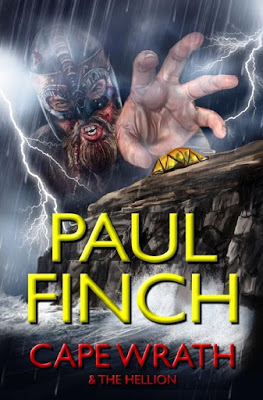 Well, the location is certainly relevant – because that is where the vast bulk of the novel takes place. If you’ve ever visited it, you’ll consider it well named. Even by the standards of Northern Scotland, it’s a dramatic and picturesque place.
Well, the location is certainly relevant – because that is where the vast bulk of the novel takes place. If you’ve ever visited it, you’ll consider it well named. Even by the standards of Northern Scotland, it’s a dramatic and picturesque place.Back in 2001, when I first came up with the idea, I couldn’t think of anywhere more suitable to set my proposed story about an archaeological dig that goes very, very wrong. I’ll try not to give away too many SPOILERS, but CAPE WRATH tells the tale of a university archaeology team, who head north from England to the rugged isle of Craeghatir (pronounced Crag-a-tar!), which lies several miles beyond Cape Wrath. As you’d imagine, it’s initially a story of wild winds and heaving seas, but the island itself is ringed with crags, which shelter its inland area, a pristine paradise of deep glens, rushing burns and, unlike most islands in this far corner of Scotland, dense pinewood. It is also wreathed in superstition.
Somewhere here, according to a recently translated rune-stone, is the last resting place of Ivar the Boneless, possibly the most infamous Viking adventurer of them all.
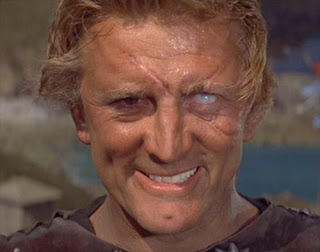 Though almost forgotten today, Ivar, a real personality of the ninth century, who lived, breathed and slew all over Britain and Ireland, was renowned for his prowess in battle and his pitiless cruelty (and for being memorably portrayed by Kirk Douglas in the 1958 movie,
The Vikings
, above).
Though almost forgotten today, Ivar, a real personality of the ninth century, who lived, breathed and slew all over Britain and Ireland, was renowned for his prowess in battle and his pitiless cruelty (and for being memorably portrayed by Kirk Douglas in the 1958 movie,
The Vikings
, above). His obsessive loyalty to the Norse Gods, and his relentless quest to avenge his father, Ragnar Lodbrok (who was thrown by the English into a pit of vipers) drove him and his so-called ‘Great Army’ through numerous Christian realms, raping, pillaging, burning and killing in various elaborate and grotesque ways. According to written records, the Viking Blood Eagle – a sacrifice to Odin which involved the victim’s lungs being torn out while he still lived – was only enacted a handful of times, and yet nearly all those occasions are associated with Ivar the Boneless.
Though his exploits in life are well documented, what became of him in death is unknown. Most scholars agree that he died in his bed, far more peacefully than the majority of those he vanquished, but his burial place is lost to us. At least, it was until I wrote CAPE WRATH .
In CAPE WRATH , he was entombed by his brother, Halfdan, on Craeghatir, where he remained undiscovered until Professor Jo Mercy and her team arrived. If they could find the tomb and then open it, what treasures would lie within? Ivar was no mere raider; he laid waste kingdoms across the entire western world of the Dark Ages, or so the legends tells, gathering a fabulous trove.
What story would his mouldering bones tell? All kinds of myths about Ivar abound. That he was seven feet tall. That he was half man / half bear. That he was born a cripple, and somehow overcame this purely through his aggressive nature. Now the truth would at last be out.
 But would something else come out with it?
But would something else come out with it?Why did Halfdan refuse to cremate his brother, as other heroic Viking leaders were in that age?
Why did he bury him without any fanfare?
Why did he choose this most isolated place?
Why have strange and terrible things happened to everyone else who has ever come here?
And why do Professor Mercy’s rival academics fear that opening this ancient tomb could be a very serious mistake?
Okay, no more plot details. I’m afraid it’s the usual thing. If you want to know more, you have to buy the book. Or alternatively, hang around until the film is made.
That said ... I don’t want to over-egg the ‘movie development’ pudding.
Like many writers, lots of my work has been optioned for movie and TV development in the past, and very little of it has ever, in the end, seen the light of day. CAPE WRATH , itself, was short-listed for the prestigious Bram Stoker Award in 2002, which drew it to the attention of a much wider audience than the norm, and saw it optioned for film development almost straight away. It remained under option, on and off, for roughly the next nine years, during which time I must have produced at least ten drafts of the script.
Each time, it felt as if we were getting a little bit closer; at one point we were less than a month from pre-production – I remember walking around Soho in a daze of excitement that day – but ultimately, events conspired to prevent it from reaching principle photography.
I’m not complaining, by the way. This is par for the course when you’re a professional writer, and let’s be honest, if nothing else, it’s better that your work attracts the attention of film and TV-makers even temporarily than it remains unnoticed by anyone.
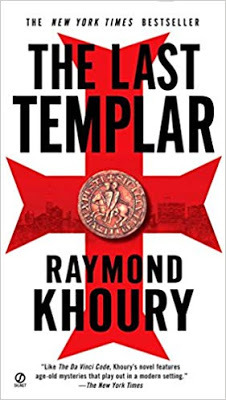 This new interest this month, however, comes from Shock Tactics Films Ltd, and from top screenwriter and novelist, Raymond Khoury, who is probably best known for his best-selling Knight Templar books. Raymond was a fan of
CAPE WRATH
for some time and has long been keen to write a script. A couple of friends have asked me about this – how it feels, handing my novel over for another writer to make his own interpretation. My position is simple. I’m very busy at the moment with my Heck and Lucy Clayburn novels, and anyway, I’ve already read Raymond’s script, which is absolutely superb. So why object?
This new interest this month, however, comes from Shock Tactics Films Ltd, and from top screenwriter and novelist, Raymond Khoury, who is probably best known for his best-selling Knight Templar books. Raymond was a fan of
CAPE WRATH
for some time and has long been keen to write a script. A couple of friends have asked me about this – how it feels, handing my novel over for another writer to make his own interpretation. My position is simple. I’m very busy at the moment with my Heck and Lucy Clayburn novels, and anyway, I’ve already read Raymond’s script, which is absolutely superb. So why object?A deal was thus struck, and CAPE WRATH is back under option. Will it be Development Hell or Development Heaven? You never know with these things, but it’s always a lot more exciting when a project is going somewhere than when it’s sitting on your back shelf, gathering dust.
Keep watching this space, and I’ll fill you in on all the details as they arrive.
THRILLERS, CHILLERS, SHOCKERS AND KILLERS …
An ongoing series of reviews of dark fiction (crime, thriller, horror and sci-fi) – both old and new – that I have recently read and enjoyed. I’ll endeavour to keep the SPOILERS to a minimum; there will certainly be no given-away denouements or exposed twists-in-the-tail, but by the definition of the word ‘review’, I’m going to be talking about these books in more than just thumbnail detail, extolling the aspects that I particularly enjoyed … so I guess if you’d rather not know anything at all about these pieces of work in advance of reading them yourself, then these particular posts will not be your thing.
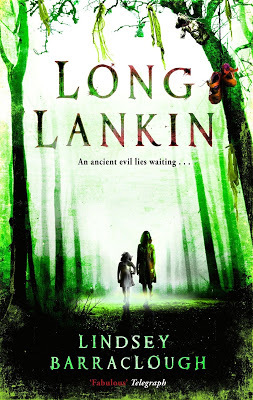 LONG LANKIN
by Lindsey Barraclough (2012)
LONG LANKIN
by Lindsey Barraclough (2012)
It is 1958, and Limehouse resident, Harry Drumm, decides that he can no longer look after his two daughters. His wife has been confined to an asylum thanks to an ever worsening mental condition, and he is struggling to hold down a job. Hoping, for the time being at least, that his girls will have a better life in the countryside, he sends them to live with their great Aunt Ida, who occupies Guerdon Hall, a moated manor house in the Essex village of Bryers Guerdon.
The children, 14-year old Cora, and her 10-year-younger sister, Mimi, are already disoriented when they arrive in the the remote spot, and this isn’t helped by the state of the Hall, which is a rotted, Gothic pile encircled by overgrown marshland, by the village itself, which is very poor, and especially by Aunt Ida, who is cold, mean-spirited, unflinchingly strict and seemingly determined to send them back to London at the first opportunity. On the few occasions she deigns to explain this, she simply says that Bryers Guerdon is no place for youngsters and promises to write to their father, demanding that he take them back.
This is fine by Cora and Mimi, who find the house dreary, damp and stuffy because all its windows are nailed shut, and filled with frightening paintings which take on new dimensions of terror at night. However, Harry does not come back to retrieve his daughters, and the lonely duo are forced to adapt to life in this mysterious village, making friends with two brothers, Roger and Peter Jotman, who come from a rumbustious but friendly household, and advise her that their aunt has a bad reputation locally. Rumours hold that she is a witch and that she murdered members of her own family, which is why she rarely leaves her home except for necessities, and hardly ever interacts with any of her neighbours.
To fill the long, hot days of summer holiday that lie ahead, the youngsters opt to investigate these rumours for themselves, exploring the village and its surrounding localities, and finally coming to All Hallows church, a shunned, semi-abandoned edifice in the woods, its grounds overhung by the ‘Gypsy Tree,’ where dolls and shoes hang from the branches, and accessible only by a locked lychgate, carved over the top of which are the words, Cave Bestiam, which they soon learn are Latin for the ominous phrase, ‘Beware the Beast’.
The more the children put themselves around and the more people they get to know, the more discomforted Cora becomes. Aunt Ida still hasn’t accepted them, and constantly scolds her for meddling in things that don’t concern her, but in addition to this, there are odd, unexplained events. Both girls feel as if some strange, frightening presence is drawing ever closer, while at the same time they hear whispered voices at night, seemingly trying to warn them, and even spot what look like the ghosts of children in the derelict churchyard.
Piece by piece, through a succession of interviews with garrulous local folk, and their examination of old documents and relics from a troubled past – in which Cora and Ida’s family in particular, the Guerdons, were helplessly entrapped – the story emerges that an age-old curse has awakened; something ancient and evil, which lurks in the encircling marshes, and over the the centuries has stolen away numerous of the Guerdon children. At one time, his name was Cain Lankin. He was a real person who lived hereabouts, albeit hideous to look upon and whose deeds were horrific, consorting with witches not the least of them. Inevitably, centuries later, decayed and foul, as carnivorous as ever, and known by the final name they gave him, ‘Long Lankin’ because he barely even fitted into the gibbet cage, he is now more terrible than ever, and he drools with hunger for four-year-old Mimi …
As some may already know, the novel, Long Lankin , is based on an Old English ballad of approximately the same name (though there are various names, it has to be said: Long Lankyn, Lammikin, Balankin, etc), the original author of which is unnamed and the date of composition, though unknown, thought to date back to Elizabethan times at least. It tells the story of a wealthy woman and her baby who are murdered by a malign being, which emerges from the marshy woodland surrounding their country home and is admitted to the residence by an untrustworthy female servant. One version of it is fully quoted at the start of the book, the sinister opening verse reading as follows:
Says milord to milady, as he mounted his horse:“Beware of Long Lankin that lives in the moss.”Says milord to milady, as he went on his way:“Beware of Long Lankin that lives in the hay.”
In some versions of the song, particularly the older ones, Lankin is a mason who has not been paid for work he performed on the property and is seeking to recompense himself with aristocratic blood. But in others, he is a bogeyman or monster – a Grendel-like figure, though a more modern, internet-age analogy might be with Slenderman – who is evil merely for the sake of it and sustains himself on the life-force of infant children.
Suffice to say that in the novel, Long Lankin , Lindsey Barraclough opts for the second of these explanations, casting Lankin as a dangerous, malevolent villain of supernatural origin. Though she details where he comes from, giving him a near-human backstory, it is flavoured with witchcraft and village superstition. And indeed, rural folklore is very much to the fore in this tale.
As I write, there is something of a renaissance in folk-themed horror stories, wherein the focus lies with mysterious rituals and customs, eerie fables, scary myths and half-told tales that may possess a kernel of unedifying truth. This is an area where I personally have an interest, much of my own written horror leaning towards the mythologies of old Britain, so as Long Lankin satisfies almost all of these criteria, it was hugely attractive to me from the outset.
That said, I initially hesitated because it is marked as a YA novel. It’s not for children by any means, but it is certainly aimed at a slightly younger readership than me. But in the end, I dived in, and I wasn’t at all disappointed. There isn’t much in the way of sex and violence, as you’d expect, but this is one exquisitely creepy tale, its setting beautifully realised.
It’s not just rural England in the 1950s, we’re in the marshlands of eastern Essex, at the height of a hot, sleepy summer, but Great Britain is not a happy land. The destructive impact of two world wars can be felt everywhere: back in smoky London, where city girls Cora and Mimi Drumm hail from, and out here in the swampy greenwood, where villages are poverty-stricken, roads impassable, cottages run down, and most of the adult population tired and cranky. There is also a prominent sense of loss. Many local men died in the wars that have only recently passed, and there is scarcely a family of any class that hasn’t been bereaved to a greater or lesser extent. For a so-called YA novel, this is a painful and grown-up portrayal of a society that has triumphed over Hitler, but as would always be the case after such massive conflict, has paid a terrible price.
Of course, all this embitterment contrasts neatly with the book’s younger cast, who, in the way of children the world over, breeze their way through the summer holidays, oblivious to adult woes, playing and generally having fun (until the nightmare figure of Lankin arrives, of course). This enables Barraclough to indulge in some outstanding character work.
In Cora, Roger, Mimi and Peter, but in the older two children particularly, she creates a bunch of believable, happy-go-lucky youngsters, who, despite the hardships and privations of their everyday lives, are inquisitive, excitable and eager to ramble around the sun-drenched countryside, never letting anything so mundane as low-quality food, hand-me-down clothes, a clip round the ear or even a spooky old graveyard get them down. But these aren’t just the scampering, barefoot urchins of Enid Blyton. There’s a work ethic among these post-war brats, and a sense of duty: they do as they’re told, helping their parents out where they can and taking responsibility for their younger siblings because they live in a real but damaged world, which they know must be rebuilt. At the same time, each one is clearly an individual, with habits and traits specifically designed for them by the different lifestyles they up until now have led; Roger carefree for example, Cora sadder and more serious.
It’s the same with the adults. They are colourful but often multi-layered: Mrs Jotman, the ever-tired country housewife, who nevertheless is more of a mum to Cora and Mimi than their own mother has ever been; Harry Drumm, the Jack-the-lad Eastender, a chirpy character who, despite endless promises, never seems able to live up to his kids’ expectations; Gussie, the mad old cat-lady with her stumpy teeth and foul-smelling home, and a deep knowledge of rural lore forced upon her by terrible experiences during her girlhood; Mr Thorston, the scholarly, university-educated cottager who had so much to offer the world and gave it up so that he could look after his ailing wife; and Ida Eastfield, the stern auntie figure, but also the most complex person in this tale, and the one around whom most pathos is woven – because though she is unfriendly to the children and loses her temper easily, deep down this is through fear and guilt rather than dislike, and because she knows what lurks beyond the manor moat, her own tragic history intricately entwined with it, the horror of which is more than she can stand.
Which brings us at last to Cain Lankin, also a tragic figure, an outcast, a leper, a person so reviled in his day that his apparent death went unlamented. Yes, all the best monsters are able to touch some nerve inside us, to make us feel sorry for them, even if in this case it is only brief. Cain Lankin, we feel, was destined to do evil from his earliest days, and when he appears to us now in the 20th century, he’s adopted that mantle to its fullest extent. Whatever cruelties he and his lady-friend suffered, he has now repaid them a hundred times more often than necessary, and he continues to do so with obsessive, vampire-like relish.
Inevitably, it is Lankin who provides some of the most frightening moments in this book. And, YA or not, they are genuinely hair-raising. There is more than a touch of MR James when his hideous, emaciated form comes creeping in the night, crawling through the undergrowth on all-fours as he closes silently on his unsuspecting prey. But to say any more about that would be the ultimate spoiler.
If I have any criticism at all, it’s that I’m not massively sold on the novel’s division into three separate and regularly changing, POVs – Cora’s, Roger’s and Ida’s. I’m not sure it adds anything to the narrative, which proceeds at its own stately pace and is all the more compelling because of it, layer upon layer of mystery being added as the story unfolds. But ultimately, it doesn’t spoil anything either, so I’m not really complaining.
The main thing is – don’t be put off by Long Lankin’s YA status. This is an effective and atmospheric horror novel, not exactly pacy, but richly evocative of rural England in the old days, with its long, hot summers, its village spells, its carven lychgates and its ancient, ancestral curses.
If that’s the stuff you’re looking for, you won’t be disappointed.
Usually, as you probably know by now, I like to complete my book reviews with a bit of fantasy casting, should the project ever make it to the screen. On this occasion, though, I’m going to pass for two reasons. Firstly, Long Lankin is constructed around its child cast, and I don’t know enough about the current best child actors, so it would be a pointless effort. Secondly, because it has already been optioned for development by a British company … so, here’s hoping for a TV production as good (and as scary) as the source material.
(The image at the top of today’s column comes from the 2007 Viking movie, Pathfinder).
Published on September 24, 2018 12:39
September 6, 2018
Creating Heck - where did he come from?
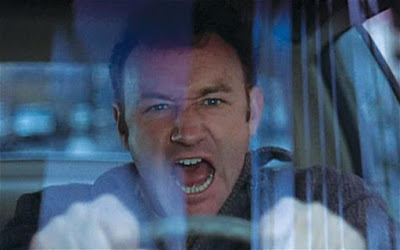
I’m still on the ‘how did it all happen’ trail this week. I’ll be focussing again on KISS OF DEATH, my 7th DS Heckenburg novel, which today completes its first month of publication, during which time it has accrued some truly fabulous reviews (many thanks to all those who’ve had their say), and we’ll be zoning in specifically on Heck, examining the various cinematic influences that lie behind him.
Also on the subject of dark, scary thrillers, I’ll be reviewing and discussing Joe R. Lansdale’s seriously frightening crime novel, THE NIGHTRUNNERS, in what I hope is my usual forensic detail. If you’re only here for the Lansdale review, no worries – you’ll find it, as always, at the lower end of today’s blogpost. There’s nothing to stop you zooming straight on down there. But if you’ve got a bit more time on your hands, perhaps you’ll be interested in reading about …
Heck’s origins
Readers often ask me which other crime authors are my benchmarks?
Which of those writers who focus on the seamy side of life are the ones who’ve most influenced me in the writing of my own novels? I’d imagine that lots of guys and girls in my situation get asked similar questions, and like me, will respond by reeling off lists of the most impressive names in the business – because we’ve all read widely in the field, and we’d be lying if we didn’t admit that we’ve all probably taken something from every great crime novel that’s gone before us, not to mention the masterclass cop characters we’ve so easily been able to picture thanks to how well realised they were on the written page.
 But one question I’m rarely asked – and something I’d like to deal with today – is are there any film or TV cop characters who’ve been a stimulus for me, particularly with regard to DS Mark ‘Heck’ Heckenburg (currently adorning the bookshelves in
KISS OF DEATH
)?
But one question I’m rarely asked – and something I’d like to deal with today – is are there any film or TV cop characters who’ve been a stimulus for me, particularly with regard to DS Mark ‘Heck’ Heckenburg (currently adorning the bookshelves in
KISS OF DEATH
)? In response, I think it’s true to say that there are probably four celluloid cops (or cop situations) that have had this kind of direct impact on me; two films and two TV shows.
That might be an embarrassing thing for some writers to admit, because we are supposed to be literary types who, deep down, should only be affected by genuine greatness, though I’d contend that greatness can be found on the screen as well as in book-form.
Anyway, here we go. The two cop movies and two cop TV shoes that most made an impression on me and were most instrumental in the development of my character, Heck, are, in chronological order: Bullitt , The French Connection , The Sweeney and The Shield .
Aside from the fact that these are all essentially slick, quick, tough-talking action thrillers, set in contemporary times and an unforgiving urban setting, in actual fact they could not be more different from each other, and they’ve had very different effects on my work.
First, the movies …
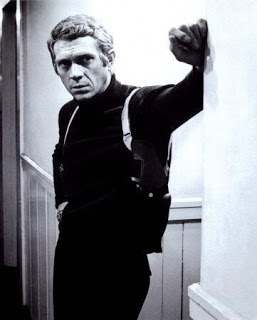 BULLITT (1968), directed by Peter Yates, starred Steve McQueen as Frank Bullitt, a San Francisco police inspector in charge of a Mafia super-grass who is shot and critically wounded shortly before he’s due to give evidence. Bullitt needs to track the killers and whoever gave them their orders, but increasingly upsets his superiors as the enquiry threatens to lead him into ever higher places in the city’s administration.
BULLITT (1968), directed by Peter Yates, starred Steve McQueen as Frank Bullitt, a San Francisco police inspector in charge of a Mafia super-grass who is shot and critically wounded shortly before he’s due to give evidence. Bullitt needs to track the killers and whoever gave them their orders, but increasingly upsets his superiors as the enquiry threatens to lead him into ever higher places in the city’s administration.One of the first ever cop thrillers to examine the often real connections between organised crime and the establishment, Bullitt is high on action but low on violence, casting a sexy and athletic film star in a very cerebral role, which sees him working his way through a highly complex investigation by following his instincts rather than his orders. Readers of the Heck books will probably not need an explanation from me as to what kind of influence this exerted. While the outsider cop is a regular fixture in crime fiction – and Heck is no different, loving his ‘roving commission’ – he often develops theories based on his own analysis of crime scenes and crime situations which his bosses can’t buy into. Much of the drama and tension in the Heck books stems from the balancing act he must perform between following a system he often suspects is bent or incompetent, or both, and following his own gut.
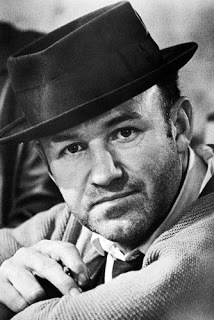 THE FRENCH CONNECTION (1971), directed by William Friedkin, cast Gene Hackman as Jimmy ‘Popeye’ Doyle, a real-life New York narcotics cop, whose vindictive pursuit of a local mobster leads him to break open one of the biggest heroin importation rings in US history.
THE FRENCH CONNECTION (1971), directed by William Friedkin, cast Gene Hackman as Jimmy ‘Popeye’ Doyle, a real-life New York narcotics cop, whose vindictive pursuit of a local mobster leads him to break open one of the biggest heroin importation rings in US history. The reason why this one was influential may not be immediately obvious. While Frank Bullitt was a handsome hero, Popeye Doyle is a slob and a boor, and unpopular with his colleagues, and that is not the way I’ve envisaged Heck. Heck is usually affable and has one or two friends on the force, even if not necessarily among the brass. But he and Doyle share a dogged nature; it’s that instinct thing again, that old-fashioned police hunch business. In The French Connection, Popeye only gets to the real bad guys after a prolonged and convoluted enquiry, which many of his fellow officers oppose because they simply don’t trust him. And that’s been the story of Heck’s life in all seven novels so far. Neither he nor Doyle have an unfailing faith in their own judgement, but they’re both of them stubborn and bullish enough to keep advancing along an increasingly difficult track despite growing evidence that it’s likely to be a dead-end.
And now the TV shows …
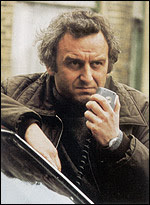 THE SWEENEY (1975/78), made by Thames Television, starred John Thaw as Jack Regan, a northern copper displaced to London, and now a DI in Scotland Yard’s elite Flying Squad, a unit who exist solely to tackle the city’s gangs of armed robbers.
THE SWEENEY (1975/78), made by Thames Television, starred John Thaw as Jack Regan, a northern copper displaced to London, and now a DI in Scotland Yard’s elite Flying Squad, a unit who exist solely to tackle the city’s gangs of armed robbers.The situation was the bigger deal for me here, rather than the actual character. While I certainly took some influences for Heck from John Thaw’s electrifying portrayal of Regan – I referenced it directly in KISS OF DEATH, the exiled northerner, lonely and cut off from his family, perennially unlucky in love – ultimately, I was more interested in his relationship with the underworld. By its nature, the real-life Flying Squad had to wheel and deal to get results; it was interested in big fish, not little ones. Therefore, unofficial alliances were made. They relied heavily on informers, against whose own criminal activities they often turned a blind eye. To some, this was common sense policing; to others it was corruption. The Flying Squad of the 1970s did eventually come unstuck when it got embroiled in some seriously questionable practises, and this also happens in the TV series. But in the Heck books, which are set in the here and now, we never take it that far. Nevertheless, Heck refuses to play by the rules; he knows every trick in the book, which may include strong-arming criminals and even blackmailing them. At the same time, he makes allegiances with lesser villains in order to pull in the more dangerous ones. Heck is not corrupt, but in the heavily bureaucratic world of 21st century policing, all this would be complete anathema. So, even though Heck’s methods gain him extraordinary results, as Regan’s did back in the 1970s, we always get the feeling that, at any moment, his time could be up.
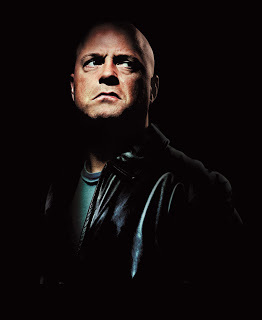 THE SHIELD, (2002/08), will almost certainly be my most controversial selection. A popular but divisive US cop show from Fox, it told the tale of South-Central Los Angeles’ infamous Strike Team, a group of undercover detectives, led by Sergeant Vic Mackey (a bravura performance by Michael Chiklis!), who would literally stop at nothing in their war against the local street-gangs.
THE SHIELD, (2002/08), will almost certainly be my most controversial selection. A popular but divisive US cop show from Fox, it told the tale of South-Central Los Angeles’ infamous Strike Team, a group of undercover detectives, led by Sergeant Vic Mackey (a bravura performance by Michael Chiklis!), who would literally stop at nothing in their war against the local street-gangs.Based on the real-life Rampart unit, who in the 1990s were the centre of a huge misconduct scandal, Strike Team members are openly portrayed as corrupt, killing some of their targets, framing and stealing from others, robbing criminal strongholds and even, on one occasion, murdering a fellow police officer who’s grown suspicious about them. However, such was the skill with which the show was written, directed and performed, that you endlessly rooted for these maverick antiheroes, even though you knew it would at some point come crashing down in flames – as indeed it did. I should say straight away that there is no aspect of Vic Mackey in Mark Heckenburg. Mackey is ruthless, violent and sadistic. Oh, he is charismatic, and he has his caring side with his family, but when he’s on the job, he’s an out-and-out hoodlum. But what I inherited from The Shield was not the character but the milieu.
The borough of Farmington is a fictional corner of LA, where every kind of crime and vice is rampant. Psychos, weirdos and creeps populate every street; there are serial killers, gangbangers, child-molesters and pimps. Drugs and disease are everywhere; there is horrendous squalor. And yet there is colour to all this. In the fashion of James Bond or even Batman, The Shield features some of the most wonderfully deadly and deranged villains I’ve ever seen on television: the Jesus lookalike who collects people’s feet (whether they’re alive or dead); the handsome, intelligent Texan who relentlessly murders needy women; the scar-faced gangster who burns his rivals at the stake. It’s perhaps no coincidence that in the Heck books, we try to offer a cross-section of villainy, but that it’s always (or so we hope) memorable and outlandish. The inspiration for that could lie with Bond and Batman, but it’s mostly the case, I think, that it lies with The Shield.
THRILLERS, CHILLERS, SHOCKERS AND KILLERS …
An ongoing series of reviews of dark fiction (crime, thriller, horror and sci-fi) – both old and new – that I have recently read and enjoyed. I’ll endeavour to keep the SPOILERS to a minimum; there will certainly be no given-away denouements or exposed twists-in-the-tail, but by the definition of the word ‘review’, I’m going to be talking about these books in more than just thumbnail detail, extolling the aspects that I particularly enjoyed … so I guess if you’d rather not know anything at all about these pieces of work in advance of reading them yourself, then these particular posts will not be your thing.
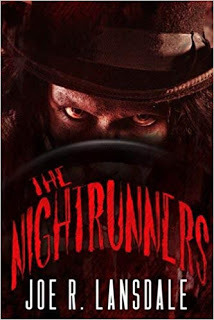 THE NIGHTRUNNERS
THE NIGHTRUNNERS by Joe R. Lansdale (1987)
It’s Galveston, Texas, in the mid-1980s, and modern-minded, well-heeled couple, Becky and Montgomery Jones, should be living the dream. Professional academics, they both have good quality of life, a steady income, are a well-matched, physically handsome pair and, as lovebirds since their college days, they care for each other deeply. It should be a match made in Heaven, but in actual fact their blissful life has been ruined by a dreadful incident approximately four months prior to this narrative, when their house was broken into while Monty was away, and Becky savagely raped by a former student of hers, Clyde Edson, who wasn’t just a juvenile delinquent but a fledgling serial killer already known locally as the ‘Rapist Ripper’.
Edson was later apprehended and committed suicide while remanded in jail, but of course Becky’s recovery from such an ordeal was never going to rely solely on the hand of justice. The deep psychological wounds have destroyed her pleasant suburban existence. She now lives in fear of the night, endures harrowing nightmares and bizarre premonitions, is completely unable to enjoy sex, and has ambivalent feelings about her husband because of his previous political stance; before this event, Montgomery Jones was a liberal through and through – he believed in tackling the causes of crime rather than cracking down on it, he looked to rehabilitation rather than punishment, he didn’t regard Galveston’s underage hoodlums as thugs and predators so much as disadvantaged kids who need a helping hand rather than a good smack around the head.
All of this has changed now, of course – except that it’s too late.
Even though Monty wasn’t present at the time of the rape and could have done nothing to prevent it, he now regards his former ‘enlightened’ attitude as a kind of moral cowardice, and is inwardly repelled by his previous pretence of intellectual superiority when in reality he suspects that he has always been unnerved by the prospect of taking a tough stand. He particularly agonises about an incident from his childhood, when he was too frightened to intervene as a local bully force-fed his kid-brother a dog turd. What’s even worse from Monty’s point of view is that he suspects Becky thinks this about him too, even if she won’t say it. Just being in his wife’s melancholy presence now unmans him.
It looks as if their relationship, once so strong, has fatally fractured … until late that October, when in a desperate effort to patch things up, Monty takes Becky out to a friend’s cabin, so they can get some peace and quiet. It’s an idyllic, pine-clad location in the East Texas wilderness, and the crisp autumn weather is beautiful. For the first time in a while, the couple begin to relax again in each other’s company, even though there is still much lost ground to make up.
However, this hesitation to resume their former status is actually the least of their problems.
Because unbeknown to the Joneses, several members of Clyde Edson’s gang – all of them complicit in the Rapist Ripper murders – eluded capture, including his psychopathic second-in-command, Brian Blackwood, and their reign of Hell is far from over.
Blackwood still remains in awe of his deceased ex-leader, viewing him as a kind of Nietzchean superman – primarily because he never let human sentiment hamper him when he was out to get whatever he wanted. Despite this, Blackwood has no initial motivation to go back and finish off Becky Jones, their last victim … until, one feverish midnight, when he receives a nightmarish visitation from his former friend, now reduced to the status of demonic ventriloquist dummy seated on the knee of the satanic ‘God of the Razor’, an horrific being who literally wears a coat made from flayed human flesh and shoes made out of guillotined human heads (and who will go on to appear several times more in Lansdale’s work).
Whether this is a genuine supernatural event or simply a figment of Blackwood’s deranged mind is basically irrelevant, as Edson demands a continuation of their previous crime: a full-scale attack on Becky Jones, culminating – after the gang have sexually defiled her for as long as they care to – in the removal of her heart. If anyone gets in the way, like her husband of course, he/they can also be dispatched.
Impressed by this, and by the promise of dominion in a hellish afterlife – and if ever his enthusiasm for this flags, egged on aggressively by Edson’s damned soul, which now seems to possess him – Blackwood gets the gang back together and they go on the prowl in their distinctive black ’66 Chevy, seeking out the Joneses and slaughtering anyone who even threatens to hinder their progress. They are so bent on this mission, and so ruthless with anyone who might have information for them (strewing carnage every which way), that it isn’t long before they learn about the isolated cabin where the injured couple are trying to recuperate …
It probably isn’t going too far to say that The Nightrunners put Texas writer Joe R. Lansdale on the map. This is a very early novel of his, originally written in 1982 as Night of the Goblins , but since then he’s become a literary landmark in his own right in the overlapping fields of horror, crime, Rural Noir, Southern Gothic etc.
It isn’t a particularly long novel, and nor is it likely to educate or edify you if you’re looking for something highbrow. In truth, this is a long way from Lansdale’s best work; he himself has repeatedly reminded folk that it’s an early effort and has voiced surprise that it continues to draw positive reviews. But what I will say is that, even now, three decades after first publication, it’s one headlong thrust of a narrative and a hell of a page-turner.
It’s also brutal and nasty … and I mean excessively so. Okay, there thankfully isn’t much here in the way of torture-porn. But this is visceral violent crime fiction at its most unforgiving.
The antagonists are beyond the pale in terms of amoral, purposeless depravity, and their main targets almost impossibly innocent and genteel. Other tougher, worldlier characters are introduced on the side of right – streetwise cop, Ted Olsen, and gang-members with a conscience, Jimmy and Angela – but from the very beginning you just know that this southern-fried fury ride is only going to end in one final and massive confrontation between the civilisation-softened Joneses and the walking bunch of disenfranchised aberrations which is all that remains of Clyde Edson’s murder gang.
It’s a dark and horrible atmosphere; I’ll make no bones about that. Even early in the book, when it’s mainly about the Joneses trying to restore their equilibrium in a place that seems beyond danger, the reader’s sense of growing dread is palpable – Blackwood and his boys have commenced the hunt for their prey equipped with nothing more than animal cunning and naked bloodlust, but draw steadily nearer to them with the turn of each page.
I don’t want to say too much more, certainly not about the explosive finale, which you obviously won’t need me to tell you is not going to end well for any members of our ensemble cast, either the good or the evil. But suffice to say that it hasn’t been likened to the ultra-violent British movie, Straw Dogs , for nothing.
The message of The Nightrunners isn’t an especially complex one. Lansdale isn’t setting out to explore a moral conundrum here. Quite the opposite, in fact. Montgomery Jones’ earlier self – the guy who tried to rationalise the cause and effect of societal breakdown in modern-day America – is soon jettisoned in favour of the raw, frightened and somewhat more dangerous animal he becomes later in the book; and though there are hints that some of these problems are the result of small-town boredom (kids like Jimmy with nothing to do but hang around pool rooms all day) and failure to compromise by those who are supposedly older and wiser (Angela’s mother kicking her out for having pre-marital sex, and thus driving her daughter into the enclave of the gang), the real corruption here is attributed fairly and squarely to an unknowable supernatural force, the Razor God, and though this may be a metaphor for insanity, it is clearly a power beyond Blackwood’s ability to resist and one for which no-one involved can really carry the blame.
The Nightrunners won’t be to everyone’s taste – but it cuts to the quick. With the best intentions in the world, we probably like to believe that violence is not and can never be the only answer to our problems … but, like it or not, there are always going to be occasions when it’s an option, and perhaps, if we are being pushed hard enough at the time, an option we’ll even find desirable.
As usual, here are my thoughts re. casting should The Nightrunners ever get the film or TV treatment. Purely for the fun of it, here are my personal picks for the leading roles:
Becky Jones – Ashley GreeneMontgomery Jones – Jimmi SimpsonBrian Blackwood – Chandler CanterburyClyde Edson – Cameron Bright
Published on September 06, 2018 02:22
August 22, 2018
Several months in the life of a crime novel

I’m going to be talking about my writing process today, specifically in reference to my next Lucy Clayburn thriller, (working title SAVAGES), the first draft of which I only finished a few days ago, explaining exactly what it involved, and how it was transformed in relatively short order from basic idea to detailed outline to book.
In addition today, I’ll be considering someone else’s book. A crime thriller yet again, just to keep with the theme: David Morrell’s marvellous MURDER AS A FINE ART, which I’ll be reviewing and discussing in my usual close-quarter detail. If you’re only here for the David Morrell chat, you can find it, as usual at the lower end of today’s blog, so shoot on down there right away.
But if you’ve got a few spare minutes, hang around and we’ll look at SAVAGES, from its inception to its near-completion.
Several months in the life of a crime novel
It’s been said to me a few times that I should write a blog about writing a book. When I reply, ‘What exactly do you mean?’, they say, ‘The mechanics of it. The complexities. What it involves day-to-day.’
Now, it seems an interesting idea on the surface, but the main problem with this is that lots of writers have done it and still do. We all like talking about ourselves, don’t we; that unique thing we do, the particular disciplines we consider we’ve mastered in order to do it? But, in this case wouldn’t there be a danger that I was just retreading familiar ground, or worse still, massaging my teacherly ego at the expense of writing something a lot more ground-breaking?
Well … on the assumption that you probably wouldn’t be here, reading this blog, if you weren’t at least a little bit interested in books and their development, what I thought might be an exercise of wider interest – rather than just me talking in general, airy terms about the novel-writing process – might be to focus on one novel of mine in particular, SAVAGES, the first draft of which I’ve only just sent to my publishers, and assessing the last few months, literally last March to a couple of days ago, and the warts-and-all method that transformed it from a pile of disorderly short-hand notes into a coherent narrative (at least, I hope it’s coherent), which tells the story of DC Lucy Clayburn’s latest nerve-shattering (again, I hope it’s nerve-shattering) investigation.
Seed
I should point out that the March-to-August period is the time when I was actually writing the book. It didn’t start then. The seed of the idea was planted much earlier than that, last winter.
But SAVAGES is an unusual case in point, because initially it wasn’t my intention to write it at all.
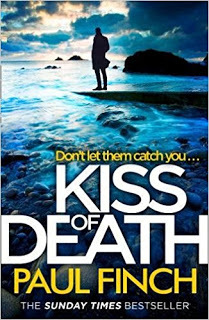 The last Heck novel of mine,
KISS OF DEATH
, which was published on August 9 this year, has been, I’m very happy to say, garnering some great reviews (check these out, on
JEN MED'S BOOK REVIEWS
,
FOR WINTER NIGHTS
,
HOOKED FROM PAGE ONE
,
THE WRITING GARNET
and BOOKISH JOTTINGS, among many others), with much commentary centred around its explosive ending. This is obviously pleasing to me, but it was all part of a plan.
The last Heck novel of mine,
KISS OF DEATH
, which was published on August 9 this year, has been, I’m very happy to say, garnering some great reviews (check these out, on
JEN MED'S BOOK REVIEWS
,
FOR WINTER NIGHTS
,
HOOKED FROM PAGE ONE
,
THE WRITING GARNET
and BOOKISH JOTTINGS, among many others), with much commentary centred around its explosive ending. This is obviously pleasing to me, but it was all part of a plan.From the outset, it was my intention that KISS OF DEATH , though a free-standing novel, would rise to a shocking climax, which would lead directly to a follow-up book. Now, I have to be careful what I say, here, because nothing is ever set in stone in the world of publishing, and though that follow-up book has been outlined in detail, there was no guarantee – until my publishers gave me the green light – that it would be written. You see, if I’d moved straight onto that one, it would have interrupted my usual publication pattern of Heckenburg novels and Clayburn novels alternating with each other.
It would have meant that number three in the Lucy Clayburn saga would have been delayed. I didn’t initially think this a big issue, but my publishers were very keen to keep the Lucy story going - which is completely sensible because this was what my readers would have expected.

 In addition, since then, there’s been increasing TV interest in the character (for those keen to know more, the names mentioned for potential stars of any such adaptation include Michelle Keegan, left, Eleanor Tomlinson and Lenora Crichlow, right – but it’s too early yet, to take all that seriously), so it would have been sheer folly to just put Lucy on the back-burner.
In addition, since then, there’s been increasing TV interest in the character (for those keen to know more, the names mentioned for potential stars of any such adaptation include Michelle Keegan, left, Eleanor Tomlinson and Lenora Crichlow, right – but it’s too early yet, to take all that seriously), so it would have been sheer folly to just put Lucy on the back-burner.An executive decision was therefore made to maintain the current pattern of publication, not rush into a sequel to KISS OF DEATH and proceed, as originally planned, with the Lucy Clayburn books. Thus, Lucy Clayburn 3 was given the go-ahead before I’d even contemplated a premise for it.
At the time, it seemed like a bit of a test. I already had a Heck story planned out to the nth degree, which I’d wanted to write straight away. But now I had to put that on the shelf until I’d come up with a completely new idea.
All authors have different views as to what constitutes the most challenging part of the writing process, but I think there’d be universal agreement that hatching a premise which doesn’t just grab you but grabs your publisher as well, can be a tall order. In this case, not really having done any prep thinking, it was a taller order than usual.
However, I do have four telephone directory-thick files of ideas (hard copy files, not electronic ones), which I’ve compiled over the years, and which comprise nothing but premises for books, films, stories etc. These often stem from my own experiences as a copper, or from true stories that were told to me by fellow coppers, or things I heard about while working as a journalist. In some cases, they’re nothing more than a few lines, often scribbled unintelligibly because the idea hit me while I was sitting in front of the telly one night with only a pad and pencil to hand. But it was one of these that now struck me for the next Lucy book.
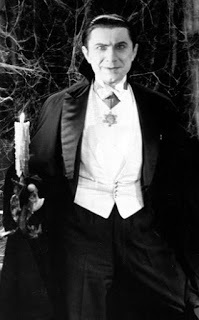 I’m not going to reveal any details yet, but suffice to say that it snagged my attention, because while very grounded in a grim and horrific practise that is all too familiar in the UK today (so, there’d be a real ‘broken Britain’ feel about it, which, to an extent is the Lucy Clayburn stock-in-trade), I also saw the potential for some Gothic horror elements.
I’m not going to reveal any details yet, but suffice to say that it snagged my attention, because while very grounded in a grim and horrific practise that is all too familiar in the UK today (so, there’d be a real ‘broken Britain’ feel about it, which, to an extent is the Lucy Clayburn stock-in-trade), I also saw the potential for some Gothic horror elements.Now, don’t get me wrong. That doesn’t mean you’re going to find Dracula or Frankenstein in the next Lucy Clayburn novel, or in fact anything supernatural at all. But so lurid is the nature of the crime that almost immediately I conceived of a lead villainous character who could easily have been played by Vincent Price or Boris Karloff, with all the attendant insanity and ghoulishness that would inevitably involve.
The more I pondered this idea, the more my enthusiasm for it grew. Primarily because it would be so different.
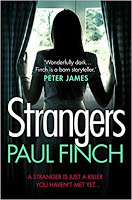 In the first Lucy Clayburn book,
STRANGERS
, it was all about the sleaze, the young policewoman going undercover as a Manchester prostitute to catch a serial killer of men. In the second one,
SHADOWS
, the focus was on Brit Grit, Lucy joining the Manchester Robbery Squad in pursuit of a ruthless gang of blaggers called the Red-Headed League for the crimson ski masks they always wore. So the next gook, now tentatively titled SAVAGES, would be about … the Gothic?
In the first Lucy Clayburn book,
STRANGERS
, it was all about the sleaze, the young policewoman going undercover as a Manchester prostitute to catch a serial killer of men. In the second one,
SHADOWS
, the focus was on Brit Grit, Lucy joining the Manchester Robbery Squad in pursuit of a ruthless gang of blaggers called the Red-Headed League for the crimson ski masks they always wore. So the next gook, now tentatively titled SAVAGES, would be about … the Gothic?
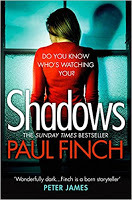
Well, that would work for me. Of course, it’s never as simple as just that. You’ve then got to evolve your premise into an actual story, which you can extend to book-length without padding it unnecessarily and in which you can maintain the pace and the mystery until the very last page.
(I’m not complaining, by the way – I’m really not. None of this is truly difficult. Slaving all day on the coal face is difficult. Loading wagons with scrap-iron is difficult. Working A&E surrounded by desperately ill and injured patients is difficult. Walking a beat in the depths of the inner city is difficult. Compared to all that, what I do is a doddle. But I at least must make it sound like I was being pushed to the limits, otherwise there’ll be nothing to keep you here).
Storyline
Once the idea is in, my usual method is to storyline, which involves creating what I call a chapter-by-chapter. I literally write the story out in skeletal form and then break it up into chapters, no more than a paragraph each, every one of which must not just move the plot along, but which must inform character and/or subtext, entertain the reader (because if it’s boring, what use is it?), and ultimately end on a cliff-hanger (thus providing the hook for the next chapter).
Quite often this is a stage in the process where I personally come unstuck. I can waste days trying to storyline my books, staring at an empty screen, prowling my house, walking the dogs, everything remaining a blank. It can even become a distraction from normal life. I find that I can’t sit in front of the telly, or go to the cinema, or even settle down at night with someone else’s book, without my thoughts straying constantly to that empty space where my own story ought now to be unfolding.
 One solution I have is to go for dinner with my wife, Cathy, where we literally bounce ideas back and forth while we’re eating. Bewilderingly, this often works. Several times I’ve made breakthroughs over a good spaghetti. Though I think Cathy is starting to suspect that this is no more than an excuse for me to continue my lifestyle as a bon vivant.
One solution I have is to go for dinner with my wife, Cathy, where we literally bounce ideas back and forth while we’re eating. Bewilderingly, this often works. Several times I’ve made breakthroughs over a good spaghetti. Though I think Cathy is starting to suspect that this is no more than an excuse for me to continue my lifestyle as a bon vivant.Joking aside, some ideas never evolve into full and effective storylines. For whatever reason, it just doesn’t work. You feel that you’re bending or twisting the concept into something else, you feel that it’s too contrived, or that it just doesn’t make sense. Those ideas don’t go in the bin – nothing goes in the bin! – but back into the file, while you look for something else.
On this occasion, thankfully, after a few days during which I felt I’d achieved nothing, everything suddenly – as it’s occasionally wont to – fell into place. Yet again, I was walking the pooches on the old pit brow, when, one by one, my ducks lined up. I remember running back home, Buck and Buddy, my two springers, gambolling confusedly after me, wondering what the excitement was about. Once I’d got the bones of the plot down on paper, it was a huge relief. But the next thing was to start getting properly into its guts, to literally make it live and breathe.
Before I can write a book, I have to know who it’s going to be about, and that often involves knocking out some character notes. With the exception of my leads, who in the Heck and Lucy books, already exist, I needed to know as much as possible about the new key personalities. This involves sketching them out in rough at first, but then going back to them one by one, enlarging their backgrounds and indulging myself in detailed physical descriptions. This also can be a lengthy process – it certainly was on this occasion, because by the time I’d secured myself a workable storyline and had individualised all those people I’d be writing about, we were several weeks into the schedule.
The job had commenced in March, and I had a deadline of mid-July, but we were now into May, and I still hadn’t commenced writing the book yet, which was scheduled to run to 46 chapters!
At which point, other things began to intrude.
Writing it
At this stage, KISS OF DEATH was still some distance off publication, but the marketing machine was rolling, so I was having to blog and tweet about it a lot. I was also writing articles for my publicity people and for other bloggers. On top of that, I was receiving structural edits, copy-edits and the like for KISS OF DEATH , which had to be dealt with immediately, but which could still be quite time-consuming.
It’s mostly my own fault, this, because I can’t be asked to check my own novel for any reason without giving it a thorough proof-read at the same time. I’ve never believed you can do enough proof-reading. I’m one of those who, if I was as empowered as Stephen King or JK Rowling, would probably tinker for ever and my books would never see the light of day. Thankfully, these edit requests all came with their own deadlines attached, so I had to send them back at some point. It was essential stuff, but weeks of my SAVAGES schedule had been eaten up.
 Our beautiful summer of 2018 (at least, the summer that was beautiful until August 1) was now dawning, and I still hadn’t got very far into the book. I cracked on, but our scorching June and July presented distractions of an entirely new kind, a kind we don’t get in the UK very often: sitting in your office, writing, trying to work hard, but with your attention continually drawn to the outside world, where the sky is blue, the woods green, and the sun beating down. Call me indisciplined, but all I wanted to do was go outside and bask in it.
Our beautiful summer of 2018 (at least, the summer that was beautiful until August 1) was now dawning, and I still hadn’t got very far into the book. I cracked on, but our scorching June and July presented distractions of an entirely new kind, a kind we don’t get in the UK very often: sitting in your office, writing, trying to work hard, but with your attention continually drawn to the outside world, where the sky is blue, the woods green, and the sun beating down. Call me indisciplined, but all I wanted to do was go outside and bask in it.It wasn’t a complete bummer, because as some regular readers of this column will know, I often like to dictate my first draft into a Dictaphone while wandering the woods and fields with my dogs. It all needs to be typed up afterwards, but even this wasn’t too much of a big deal, as I moved my work-station out onto the terrace at the back of the house, and was thus able to gain some benefit from the gorgeous weather.
 But the fact remained that I was still way behind. As my July deadline approached, I had 50,000 words to go and was getting what I think of as the heebie-jeebies, in other words finding myself wracked with nerves about missing my target. Even procrastinating on social media became less and less of an option, because I felt guiltier and guiltier every time I did it (though that didn’t stop me).
But the fact remained that I was still way behind. As my July deadline approached, I had 50,000 words to go and was getting what I think of as the heebie-jeebies, in other words finding myself wracked with nerves about missing my target. Even procrastinating on social media became less and less of an option, because I felt guiltier and guiltier every time I did it (though that didn’t stop me).It was time for drastic measures. I started skipping over bits of the narrative that would need extra research, not to mention bits that required deeper and more focussed concentration – action sequences, for example, or descriptive work – with the intention of coming back to them later (that’s right, leaving glaring gaps behind, where the very stuff that sells the book needed to be!). It was anything just to reach that finishing line. I also started making subtle enquiries about how essential my July deadline was, which I HATED doing – because I’ve always prided myself on meeting deadlines. Much to my relief, though, without any fuss at all – a big thumbs-up to my publishers at Avon here! – the deadine was moved back to August 18. Now, on the surface, this may seem as if it gave me lots of extra time, but with half a book still to go, I had no choice but to work at a rate of one chapter a day, (including Saturdays and Sundays), which was proving onerous.
(Now, again you may be tempted here to start chiding me here, telling me that this is my job and it’s the life I chose. And you’d be absolutely right. I reiterate again, I’m NOT complaining, just explaining how the process unfolds and tick-boxing the snags and hold-ups that can emerge).
Most writers, I suspect, would say that the final run-in towards deadline is the most trying time. Because that’s when the real doubts set in. For example, this is a complex mystery I’m writing here, so is there sufficient clarity for readers to be able to follow? Are these arguments persuasive enough? Is the writing actually any good? Is it not possible that I’ve rushed it and, as such, botched what could have been so much better?
This the point where physical ailments can result, which I won’t go into, but suffice to say that the integrity of your own mind and body might become a distraction all of its own.
Editing, cutting, editing, cutting, editing, cutting …
I’ve regularly said that finishing the first draft is akin to breaking the back of the overall job. That once you’ve got the book down on paper, even if you know you’re going to have to go through it again with a fine-tooth comb, you can adopt a more relaxed approach. Often this is true. I even have mood music that I play to ease me through it. But on this occasion, things were different. I’d completed my first draft in early August, with about a week to go.
But as I’ve already mentioned, KISS OF DEATH was published on August 9 with some considerable fanfare, so there was a bit of a circus to deal with at the same time. On top of that, I had to go back through the copy and fill in those yawning gaps that had been increasingly bugging me. As if this didn’t complicate things enough, my son, Harry, was living back at home, completing his thesis for his Master’s, which meant there were two of us in the house who were highly stressed. So, you can imagine what the atmosphere was like.
When all this was done, I embarked on what I call my ‘character draft’, which is usually quick, but which needs careful attention. It involves my going through the whole narrative again, but this time focussing on each individual character, checking that their voice remains consistent, that they never do or say anything that contradicts anything they’ve done or said earlier, and that their dates and times line up, because you chop and change things constantly while you’re writing (one famous author who I won’t name, once wrote an entire novel, which was a sequel to the one before, in which he featured a central character who he’d forgotten had been killed in the first book). Trust me, this particular part of the job is more challenging than it sounds. When films and TV shows are in production, they have special continuity editors to perform this role. We novelists don’t; at this stage, it’s purely down to us.
 When this was done, I embarked on my ‘cutting draft’, which is often the most horrible of all, because I always write more than I need. I won’t give you the actual figures, but with only half a week remaining on the schedule, I needed to reduce my final word-count by 30,000. Now, on the face of it, that may sound very ambitious (not to mention torturous). But in actual fact, it’s never quite as hard as that. Nothing’s ever been written that couldn’t be cut. In the trade we call it ‘trimming the fat’, and when you’ve got some experience and you’re professional enough to know that it’s essential, you’ll do it relatively painlessly. It’s only when you’ve removed the fat and you’ve still got 15,000 words to go, that you need to start trimming the meat – and that becomes a problem. It really is a gritted teeth job, especially when time is not on your side.
When this was done, I embarked on my ‘cutting draft’, which is often the most horrible of all, because I always write more than I need. I won’t give you the actual figures, but with only half a week remaining on the schedule, I needed to reduce my final word-count by 30,000. Now, on the face of it, that may sound very ambitious (not to mention torturous). But in actual fact, it’s never quite as hard as that. Nothing’s ever been written that couldn’t be cut. In the trade we call it ‘trimming the fat’, and when you’ve got some experience and you’re professional enough to know that it’s essential, you’ll do it relatively painlessly. It’s only when you’ve removed the fat and you’ve still got 15,000 words to go, that you need to start trimming the meat – and that becomes a problem. It really is a gritted teeth job, especially when time is not on your side.Once that was done, and the tears had dried, I had a couple of days left in which to commence my final read-though, which is always done out loud – either onto tape and then played back, or to an audience (whether willing or unwilling – you’ll need to ask my family about that!), just to check for unintentional repetition, clunky structuring, imbalanced syntax etc.
When that was over the job was finally done, and with a touch of a button, delivered … just after 10.30pm on the night of August 18, (with an hour and a half left on the watch).
Then it was time to rest.
Until I get the structural edit back from my publishers in a couple of weeks, which sometimes involves an extensive rewrite, and then the line-edit, which usually involves more intricate changes, then the copy-edit, which involves more, and last of all the final proof-read, which is the bit where you go through the whole manuscript again one last time, even though you’re bog-eyed with it and tormented by the knowledge that if you miss anything this time, that’s it … it’s too late.
But you know, at the risk of talking in clichés, it’s worth it. Because during that relatively short space of time, which admittedly, while it was going on, felt like the abyss of human experience, a novel has appeared out of nowhere. What previously existed only in your mind has miraculously shaped itself in front of you, and is printed, bound, usually with a beautiful cover, and just waiting to be shipped to the shops.
There’s no job I’ve ever done that’s more satisfying.
THRILLERS, CHILLERS, SHOCKERS AND KILLERS …
An ongoing series of reviews of dark fiction (crime, thriller, horror and sci-fi) – both old and new – that I have recently read and enjoyed. I’ll endeavour to keep the SPOILERS to a minimum; there will certainly be no given-away denouements or exposed twists-in-the-tail, but by the definition of the word ‘review’, I’m going to be talking about these books in more than just thumbnail detail, extolling the aspects that I particularly enjoyed … so I guess if you’d rather not know anything at all about these pieces of work in advance of reading them yourself, then these particular posts will not be your thing.
 MURDER AS A FINE ART
MURDER AS A FINE ART by David Morrell (2013)
Mention serial murder in Victorian London and most people think Jack the Ripper stalking drunken prostitutes through the fog-shrouded rookeries of the old East End. But in actual fact, Saucy Jack wasn’t the first knife-wielding maniac to terrorise the dismal backstreets of 19th century London. Some 77 years earlier, in 1811, the Ratcliffe Highway Murders shocked the capital and most of England with their brutality, a deranged assailant using the weeks leading up to Christmas to break into two Wapping homes situated one mile apart and slaughtering the families inside, seven people in total, with a mallet and a blade.
However, unlike the Ripper slayings, the Ratcliffe Highway atrocities were solved – at least to a degree, when a disturbed seaman called John Williams, arrested on suspicion, hanged himself in his prison cell before he could stand trial. This was not a satisfactory outcome for everyone; no case had been proved against Williams, but with his death and burial (at a crossroads, with a stake hammered through his heart – as if the case wasn’t ghoulish enough!) the murders stopped. In a world not yet used to titillating ‘true crime’ stories, the sensation lingered only a little while, and in due course the Ratcliffe Highway case was forgotten.
By almost everyone, that is, except the essayist and free-thinker, Thomas De Quincey, whose treatise on the experience of taking opium, Confessions of an English Opium-Eater (1822), had already caused outrage. When his book, On Murder Considered as One of the Fine Arts (1827), expressed fascination with the Ratcliffe Highway killings and described the killer as an artist among his kind, the result for De Quincey was infamy, even though his book had never been intended as a work of admiration for John Williams, but in a pre-Freudian age, was a concerted and intelligent attempt to understand the motivations behind serial murder in an era when such a crime was virtually unknown.
So much is fact, but now we move squarely into the realms of fiction, thriller author David Morrell picking up De Quincy’s discarded pen and continuing the tale in a dramatic ‘what if’ scenario.
When the novel starts, it’s 1854 and the Ratcliffe Highway Murders are part of history, most Londoners having forgotten about them … until the series suddenly recommences (or a least a series that is very similar), an entire family, including a baby and their servants, hammered and knifed to death in their home just off the Ratcliffe Highway.
In 1811, there was no official police force to investigate the slayings, but by 1854 things have changed. The Metropolitan Police are now an extensive, able-bodied operation. Not that they don’t face some drawbacks. For example, their fledgling detective division is still in its infancy. Hard-bitten Irishman, Detective Inspector Sean Ryan, is one of the city’s few reliable investigators, but he is hampered daily by his ethnicity, the Irish being associated with agitators during this period, and by the newness of his role – in the Dickensian age, police officers were supposed to be a highly visible presence, uniformed and available to assist the public at any time, whereas plain clothes officers resembled the hated secret police of Paris.
Despite all this, Ryan investigates the case in company with trusty PC Becker, a young officer who quickly recognises how effective an organised homicide division can be. It isn’t long before they learn about the original murders, and how this case appears to be a copycat. And if that’s the case, they realise, it won’t be long before there is another similar crime.
The job becomes trickier still when word leaks to the press, and the citizens of London, a city that is already a powder keg of revolutionary ferment, are badly alarmed.
Under orders from the fearsome Lord Palmerston to resolve this issue immediately, Ryan thinks that he may have got his man when Thomas De Quincey’s original On Murder Considered as One of the Fine Arts is drawn to his attention. It is written in such detail that its author might well have been present at the original murders, and as he is still only 69, that does not seem like too much of a stretch. Back in 1811, De Quincey was a robust fellow in his 20s.
However, when Ryan and Becker confront De Quincey, he has withered into a small, frail man, still of great intellect but deeply addicted to opium, which he takes in the form of laudunum. If this isn’t enough to dismiss De Quincey from the enquiry, his daughter, the independent-minded and very attractive Emily, makes a fierce defence of her father, deriding those who mistook his intellectual assessment of the original crimes for an appreciation of them, and advises them that De Quincey’s knowledge of these matters – which derives from psychological evaluation of the crimes, in an age when psychology as a science did not even exist – could be invaluable to the investigators. This helps persuade them that De Quincey might be of use, and the Opium-Eater himself, though he struggles with many demons – his endless, futile quest to find his lost love, Ann, his awful days as a vagrant, and his unyielding addiction – is keen to join the enquiry, not least because he feels a degree of responsibility: whoever the killer is, he quite clearly has studied De Quincey’s book.
Ryan and Becker are not keen to have a civilian on the case, but increasingly it feels as if they’re working against the odds. The London population is ready to take the law into its own hands, especially when further horrific slayings recreate the original murders, and in fact go further, adding more and more victims to the tally.
Lord Palmerston, fearing insurrection, is ever more determined that the killer must be brought to book immediately, but allows himself to be persuaded by his cold, handsome and incredibly brutal chief of staff, Colonel Robert Brookline, that Thomas de Quincey should not be assisting the police but should in fact be a suspect. If the Opium-Eater is to help Ryan and Becker apprehend the all-new Ratcliffe Highway Murderer, he’s going to have to do it incognito, from among the ranks of the ragged and homeless.
Meanwhile, the winter deepens, the fog thickens, and the madman continues to prowl …
In short, this is a splendid piece of work by US author, David Morrell. It’s a little Sherlockian in tone, an advanced civilian thinker assisting a brave but non-too-intellectual police force in their quest to capture an ingenious killer, helped along the way by a spirited underling (in this case the feisty Emily, as opposed to stolid old Watson). But that’s all part of its appeal.
We are firmly in a world of Dickensian-age melodrama, sulphurous fog swirling around the top-hats and greatcoats, horse-drawn carriages rattling over cobblestones, the brash cries of Cockney costermongers interspersed with drunken guffaws from the taverns and gin houses. And yet again, this is all part of the charm of Murder as a Fine Art . The author puts us firmly in that time and that place, but instead of simply evoking the spirit of Charles Dickens, to whom the average person owes so much of their knowledge about this milieu, taking us much, much further.
It might only have been a century and a half ago, but it’s a society that is now completely alien to us. For example, in London in 1854, prison governors are fully entitled to run their penitentiaries like private fiefs, where all manner of pointless torture and suffering can be imposed on the inmates. At the same time, the London mob is still a thing to be feared; even the police must tread warily when a medieval-type hue and cry is raised and the angry citizens light their torches and roam the benighted streets. At the same time, the population is still reeling from the arrival of staggering new innovations like telegraph, the railways and even indoor toilets, ‘necessaries’ as they are amusingly referred to.
This is all fascinating and convincing stuff, and it paints a vivid backdrop – even if it is often tinged a murky-grey thanks to the all-pervading Thames fog. But there is much fun to be had from the central characters too.
It’s no surprise to me that Thomas and Emily De Quincey have since gone on to star in two other books from David Morrell, Inspector of the Dead and Ruler of the Night . They make a fascinating crime-fighting duo, not least because their mere presence in this situation throws up all kinds of interesting conflicts.
De Quincey was a divisive figure in real life, and he’s a divisive figure here, even his police allies viewing him as a weakling and degenerate. The character himself loathes his near-complete dependency on his ‘medicine’, as he calls it. None of this helps, of course, when he causes the police to doubt him even more by recommending that they seek the murderer through an aberration of his mind rather than by following conventional clues.
Needless to say, he is staunchly defended by his daughter, Emily, who has been dismissed by one or two reviewers as a clichéd Victorian heroine, a fearless free-thinker in an age when adult women were expected to be goddesses of the hearth. But I don’t agree with that; Emily is not a particularly forthright or rebellious girl. She chooses to wear a less restrictive kind of dress rather than the hoops and whorls favoured by other ladies, but that’s merely for reasons of practicality. She puts forward forceful opinions and intriguing ideas, but rarely is pushy or aggressive. For me, this is a neat balancing act by David Morrell. Emily De Quincey is not some feminist of the 21st century transposed anachronistically into the 19th; it’s just that this is an age when prudery is on a high, and though she finds she must buck this trend a little to make progress, that’s all it is – a little.
Ryan and Becker are a bit more typical of their type, the former a hardcase street-ruffian, whose plain clothes persona is a bit too effective for his own good – not many believe he’s a copper when they first meet him, especially when they learn that he is Irish – and there isn’t a beating he can’t and doesn’t take, while Becker, a younger man, is a square-jawed idealist, who believes in policework and detective work in particular, and because he’s a stickler for results is completely open-minded about taking help from civilians (even females and drug addicts!).
Though it feels an unlikely alliance, they soon become an awesome foursome in terms of investigation teams, each member bringing different, well-developed talents into play. And this is a very good thing, because it isn’t just a crazed killer they find themselves having to deal with. It soon transpires that law-and-order as a concept has many dangerous foes concealed in the drifting blanking of fog, just waiting for the moment to strike. But to say any more about that would be too much of a spoiler.
Ultimately, Murder as a Fine Art is a fun romp set in an eccentric, grotesque and yet marvelous era, which it recreates in near-forensic detail. In terms of historical thrillers overall, it may be treading a well-worn path; it doesn’t add anything massively new to the genre – apart from its fascinating use of a controversial real-life personality (who wasn’t known for his detective skills) – but it’s hugely intriguing and entertaining, its driving narrative interweaving action with mystery to produce an absorbing page turner.
I’ve no clue whether or not Murder as a Fine Art is under option for film or TV development, but in an age when we’ve seen all types of horror/thriller concepts from the Gothic days dusted off and given a brand-new spin, it certainly should be. In case it ever is, here, as usual, are my personal cast-list suggestions:
Thomas De Quincey – Derek JacobiEmily De Quincey – Olivia CookeDI Sean Ryan – Jamie DormanPC Joseph Becker – Gethin AnthonyLord Henry Palmerston – Jim BroadbentCol. Robert Brookline – Mark StrongComm. Richard Mayne – Linus RoacheDr John Snow – Richard E. GrantMargaret Jewell – Julie Walters
Published on August 22, 2018 04:33
August 1, 2018
When Heck does it the devil-may-care way

The publication of KISS OF DEATH, my 7th Heck novel, is now only days away. For the uninitiated, it comes out on August 9th, and I can promise my regular readers, and even those who aren’t regular but are perhaps thinking about dipping in, that it contains its usual full-on quota of intrigue, suspense, terror (at times), its trademark irreverent approach to policing, yet more tense, emotional entanglements between Heck and the women in his life, and of course … action.
And indeed, it’s ACTION that is basically in the frame today. In particular, the really dangerous things that Heck occasionally does in order to snag the bad guys. In fact, today I’ve opted to compile a list of HECK’S TOP TEN MOST HAIR-RAISING MOMENTS – so, hopefully we can have some fun with that.
On a not dissimilar subject – raw, pulse-pounding action – I’ll also be reviewing and discussing James Carlos Blake’s remarkable thriller of the Mexican borderland, THE RULES OF WOLFE . If you’re only here for that review, no problem. You can scoot straight on down today’s blog-post; as usual, you’ll find it at the lower end. But if you’ve got a couple of minutes to spare, let’s spend them by looking at a few of my favourite action sequences in the Heck novels …
Action … action … action …
The truth is that I was inspired to do this by the recent promotional material I’ve seen coming out in advance of the new summer blockbuster, Mission Impossible – Fallout , Tom Cruise’s Ethan Hunt character performing some of the most astonishing feats of daring ever committed to celluloid.
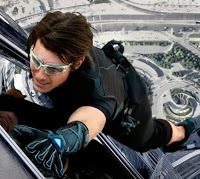 But I don’t think we can realistically compare notes with the Mission Impossible movies. Ethan Hunt is a continent-hopping espionage guy, who is hugely well trained, resourced and equipped, with the highest of hi-tech teams at his back, whose job is to take on massive, villainous organisations with plans for world domination (or destruction). In contrast, Heck is merely a copper, often going at it solo because his gaffers don’t support him. But while it wouldn’t be true to say that he regularly butts heads with comic-strip super-villains of the type that Hunt and his team encounter, his opponents are usually the worst of the worst in British terms.
But I don’t think we can realistically compare notes with the Mission Impossible movies. Ethan Hunt is a continent-hopping espionage guy, who is hugely well trained, resourced and equipped, with the highest of hi-tech teams at his back, whose job is to take on massive, villainous organisations with plans for world domination (or destruction). In contrast, Heck is merely a copper, often going at it solo because his gaffers don’t support him. But while it wouldn’t be true to say that he regularly butts heads with comic-strip super-villains of the type that Hunt and his team encounter, his opponents are usually the worst of the worst in British terms. This has still meant that there’s always been lots of scope for brutal, visceral action in the Heck novels. And though I’ve been honoured with some exceptional quotes from some truly great writers for the forthcoming
KISS OF DEATH
(you’ll notice that I’ve used a couple of them in this blog today), one of those most relevant to today’s post is this one from the highly influential crime magazine,
Shots
, which says:
This has still meant that there’s always been lots of scope for brutal, visceral action in the Heck novels. And though I’ve been honoured with some exceptional quotes from some truly great writers for the forthcoming
KISS OF DEATH
(you’ll notice that I’ve used a couple of them in this blog today), one of those most relevant to today’s post is this one from the highly influential crime magazine,
Shots
, which says:The action sequences have about them a sweaty and chaotic intensity that adds to their realism!
That pleased me no end. Sweaty and crazy intensity is exactly what I look for in my action scenes. And so, without further preamble, here they are in no particular order. The ten moments in the Heck novels to date, during which our much-battered hero most puts his own life on the line to get the job done:
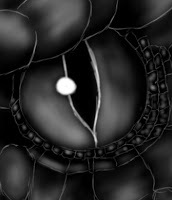 1) In
HUNTED
, there is a violent armed robbery perpetrated by a South London gang called the Snake Eyes, which the police intercept. Heck pursues the gang-leader on foot, only for his quarry to steal a heavy goods vehicle loaded with crates of beer. Heck leaps onto the back as the lorry speeds away, while his partner, DC Gail Honeyford, gives chase in a police car. The explosive pursuit takes them from Catford, all the way across Southeast London to the Blackwall Tunnel, during the course of which Heck is hurled about amid deluging beer and broken glass …
1) In
HUNTED
, there is a violent armed robbery perpetrated by a South London gang called the Snake Eyes, which the police intercept. Heck pursues the gang-leader on foot, only for his quarry to steal a heavy goods vehicle loaded with crates of beer. Heck leaps onto the back as the lorry speeds away, while his partner, DC Gail Honeyford, gives chase in a police car. The explosive pursuit takes them from Catford, all the way across Southeast London to the Blackwall Tunnel, during the course of which Heck is hurled about amid deluging beer and broken glass …2) In ASHES TO ASHES , Heck goes undercover as a hobo in a Peckham apartment building, to try and lay hands on torturer-for-hire, John Sagan, and as such, forces entry to the madman’s third-floor apartment, only to find that the target has escaped from the window by a knotted rope, leaving said rope hanging about five feet away. Because Sagan is already fleeing across the rooftops below and may shortly disappear into the maze of backstreets, Heck has no choice but to dive from the open window, catch hold of the rope – which he just about manages to – and scramble down in immediate pursuit …
3) In THE KILLING CLUB , Heck finds himself on the run from a band of international mercenaries, who must kill him because he’s in possession of damning evidence against them. The chase leads him up the coast of Northeast England, through a vicious gun-fight and into Dunstanburgh Castle, where he scales the inside of a ruined tower, and then sees him drive across the causeway to Holy Island while the evening tide floods in, onto a derelict jetty where he attempts an improvised explosion, and finally out into the North Sea on a small speedboat, in the death-grip of a scarred and deranged assassin …
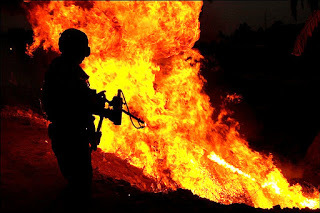 4) In
ASHES TO ASHES
, Heck and a key witness find themselves pursued around the rubble-strewn interior of an abandoned cinema by a gangland contract killer called the Incinerator because he always uses a flamethrower to reduce his targets to cinders. The place is so long empty that all its exits are blockaded, and the duo are thus chased through a hellish labyrinth, with a fiery death only yards behind them. Heck eventually chooses the deadliest escape route possible, edging ten yards along a brick ledge about seven inches wide, approx 80 ft above the alley below, in the midst of pouring rain …
4) In
ASHES TO ASHES
, Heck and a key witness find themselves pursued around the rubble-strewn interior of an abandoned cinema by a gangland contract killer called the Incinerator because he always uses a flamethrower to reduce his targets to cinders. The place is so long empty that all its exits are blockaded, and the duo are thus chased through a hellish labyrinth, with a fiery death only yards behind them. Heck eventually chooses the deadliest escape route possible, edging ten yards along a brick ledge about seven inches wide, approx 80 ft above the alley below, in the midst of pouring rain … 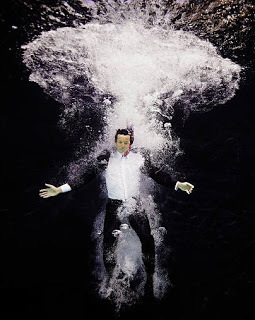 5) In
DEAD MAN WALKING
, which is set high up in the Lake District mountains, Heck gets involved in a wild chase across the fells with an armed serial killer, the pair of them riding on quad bikes. Heck is subsequently shepherded towards a towering cliff edge, below which lies a pitch-black tarn. He knows that his only chance of survival is to sail as far out over the surface as possible, so to hit the deepest water that he can find, and so floors the accelerator. All he must do then, as he quite literally flies through the air, is survive the inevitable 100 ft plunge …
5) In
DEAD MAN WALKING
, which is set high up in the Lake District mountains, Heck gets involved in a wild chase across the fells with an armed serial killer, the pair of them riding on quad bikes. Heck is subsequently shepherded towards a towering cliff edge, below which lies a pitch-black tarn. He knows that his only chance of survival is to sail as far out over the surface as possible, so to hit the deepest water that he can find, and so floors the accelerator. All he must do then, as he quite literally flies through the air, is survive the inevitable 100 ft plunge …6) In STALKERS , Heck and a female soldier are trapped by a military sniper on a wooden deck at the base of the south tower to a derelict sea-fort in the outer reaches of the Thames estuary. Knowing that they will imminently be shot, Heck realises that they must swim several hundred yards to the next tower along. This will be with the outgoing tide, so it won’t be hugely strenuous, but the trouble is the tide is so strong that if they miss the next tower, it could push them out to sea, with no hope of reaching shore. They chance it anyway, while a special forces rifleman takes repeated pot-shots at them …
7) In ASHES TO ASHES , Heck is back in his hometown of Bradburn, where he is confronted by a bunch of Russian gangsters who are determined to abduct him for the purpose of gruesome torture. Heck beats a fighting retreat along various industrial alleyways, running across a busy railway junction, with locomotives flashing back and forth, and finally seeking to force entry to a derelict nightclub by scaling down an exterior dumb-waiter and winding his way snake-like along a skin-tight ventilation pipe. The Russians, increasingly frustrated that he’s proving elusive, are soon raging with psychopathic anger …
8) In DEAD MAN WALKING , Heck and Gemma Piper, neither of whom are armed, find themselves pursued by a gun-toting maniac across the isolated Witch Cradle Tarn in motorboats. Shot at repeatedly, and with no other avenue of escape, they have no option but to chance the Cragwood Race, a whitewater rafting route, which tumbles down into Great Langdale far below between sheer cliff faces and over multiple sets of rapids. Needless to say, the insane killer comes on apace, still shooting at them, ready to follow them all the way down to the bottom of the roaring, rock-filled torrent …
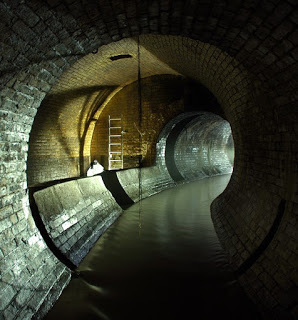 9) In
SACRIFICE
, Heck is targeted by two hitmen armed with automatic weapons. They ambush his vehicle, but by a ruse he eludes them through the backstreets, finally forcing entry to a disused London underground station. The killers give chase, and Heck leads them a terrifying dance through the forgotten bowels of the metropolis, in pitch darkness, smothered in cobwebs and filth, scrambling along pipes and culverts, through more derelict stations, over catwalks spanning drops into abyssal depths, always going deeper. But his machine-gun wielding foes are hyper-fit, and never far behind …
9) In
SACRIFICE
, Heck is targeted by two hitmen armed with automatic weapons. They ambush his vehicle, but by a ruse he eludes them through the backstreets, finally forcing entry to a disused London underground station. The killers give chase, and Heck leads them a terrifying dance through the forgotten bowels of the metropolis, in pitch darkness, smothered in cobwebs and filth, scrambling along pipes and culverts, through more derelict stations, over catwalks spanning drops into abyssal depths, always going deeper. But his machine-gun wielding foes are hyper-fit, and never far behind … 10) In
DEAD MAN WALKING
, Heck must
10) In
DEAD MAN WALKING
, Heck must shepherd a bunch of frightened fugitives across a via ferrata, a spindly walkway made from little more than steel cable, which spans numerous canyons and gorges, high in the Lake District peaks. The problem is that thick fog has come down, rendering them almost completely blind, while the via ferrata is officially out of use, rotted and broken in many places, and a lunatic is close behind, who is armed and plans to kill all of them. Heck has seen the horrors this crazed killer can wreak on his victims. It’s a no-brainer. They must chance the high-wire walk …
Are there any such scenes in KISS OF DEATH , you may ask yourself. Well, sorry folks, but there’s only one way you’re going to find out …
THRILLERS, CHILLERS, SHOCKERS AND KILLERS …
An ongoing series of reviews of dark fiction (crime, thriller, horror and sci-fi) – both old and new – that I have recently read and enjoyed. I’ll endeavour to keep the SPOILERS to a minimum; there will certainly be no given-away denouements or exposed twists-in-the-tail, but by the definition of the word ‘review’, I’m going to be talking about these books in more than just thumbnail detail, extolling the aspects that I particularly enjoyed … so I guess if you’d rather not know anything at all about these pieces of work in advance of reading them yourself, then these particular posts will not be your thing.
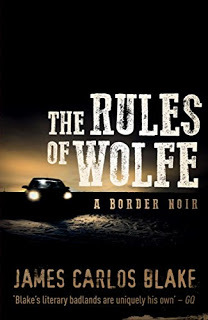 THE RULES OF WOLFE
THE RULES OF WOLFE
by James Carlos Blake (2013)
One of the deadliest of the Mexican crime syndicates is the Sinaloa Cartel. Though their home-base is located on Mexico’s west coast, the power they wield is felt nationwide, a grip of fear which is enhanced by the influence they exert over government offices, both local and national, and multiple police departments.
Fall out with the Sinas, and you’re in big trouble. Controlled by two uber-ruthless brothers, La Navaja and his younger lieutenant, El Segundo, both of whom rose to prominence on a tide of extreme violence, the Sinas are renowned for the horrific punishments they will visit on anyone who displeases them. From decapitation, to burning, to being drowned in barrels of rum, even the slightest infraction against their rock-solid rules can invoke the most draconian reprisals.
So, it probably isn’t a good time for young Eddie Porter, aka Eddie Gato Wolfe, a handsome young syndicate soldier of Mexican/American descent, to be assigned guard duty at one of the Sinas’ pleasure ranches in the desert. If it isn’t bad enough that it’s out in the middle of nowhere, there are yet more of those damn rules: the guards are occasionally allowed to visit the local villages and let their hair down, but when they’re on duty, which is the bulk of their time, there is a strict no-drinking and no-whoring order.
Eddie almost goes crazy as he stands and watches while flotillas of Sinaloan underbosses and their sexy consorts come and go, carousing all night and indulging in swimming pool parties that turn into orgies. He is particularly agonised when he sets eyes on the beautiful Miranda, who seems aloof from the other girls, and on the few occasions when he makes eye-contact with her, proves to be friendlier than most. This is not a good thing, because Eddie, an inveterate womaniser back home, simply can’t resist a lovely young girl. In due course, he contrives to introduce himself to Miranda. He’s an arch-seducer, but though he doesn’t expect that she’ll be an easy catch, she falls into his arms with remarkable speed – because gorgeous though she is, Miranda has led a life of abuse and exploitation, and desperately seeks affection.
The star-crossed duo sense that they’ll soon mean more to each other than a quick lay, but their first tryst ends in disaster when it is interrupted by El Segundo himself, who regards Miranda as his personal property.
In the ensuing fight – because Eddie has no choice but to fight – the Sinaloan No. 2 is killed.
Knowing there will only be one outcome from this, and that it won’t be over quickly, Eddie and Miranda flee the ranch, and head across the sun-scorched badlands of the Sonora desert, optimistically thinking that they just might make it to the Arizona border before their offence is discovered. Needless to say, they are wrong, and pretty soon the full wrath of the Sinas is unleashed in pursuit, including the lethal bounty-hunter, El Martillo, and his sidekick, El Pico, a top-notch tracker and incurable bar-room philosopher.
The odds are stacked against Eddie and Miranda, who from the get-go travel with a fatalistic air, as if it will only be a matter of time before they are snared. However, they do have one advantage. Eddie is related to the Wolfe clan, a smaller crime syndicate, whose main gig is weapons-smuggling, and who are transnational in nature, which means they contain both Mexican and American personnel, and their activities straddle the Border. As soon as Wolfe clan matriarch, centenarian Aunt Catalina, hears about Eddie’s plight, she sends two of her favourite nephews, Rudy and Frank, to assist. They might be less professional than El Martillo and El Pico, but they too are good at what they do.
The Sinas have their rules, and perhaps the most famous is that when someone defies you, he/she dies. But the Wolfes have strict rules too, not least that when one of theirs is in trouble, they bring him safely home …
There is no doubt that the Mexican crime cartels are among the most frightening in the modern world. With their immensely long reach, and a willingness to use unprecedented levels of grotesque violence – not just to enforce their will on rival mobsters, but to terrorise the civilian population as well – they are a crime author’s dream.
It may be a tad insensitive to put it in those terms, but they really are. As monstrous opponents go in crime fiction, the Mexican cartels are a genuinely terrifying presence even on the written page. But I don’t think I’ve ever seen them as deadly as they are here in The Rules of Wolfe .
And it is this which provides the concrete base for this searingly intense piece of border noir.
You can’t help feeling for young heroes, Eddie and Miranda. Though they’ve undoubtedly been naïve idiots by inviting this disaster into their lives, they are up against monumental opposition. Not just because the Sinas are so powerful, but because they also must escape across Mexico’s sun-baked badlands, and then make it over the border, which in itself is a huge thing. The hardships that befall them know no end: dust storms, heat, thirst, highway robbers, corrupt cops.
Despite all this, they manage to maintain their good humour and their love for each other, and such is the skill of James Carlos Blake’s writing that they don’t to this unconvincingly. They get battered and hurt, they’re constantly frightened. Miranda transforms from seductive beauty into exhausted roadside wastrel. Eddie goes from cocky young buck to responsible (but somewhat grizzled) adult, as he isn’t just physically injured, but tortured by the knowledge that he’s been the instigator of this terror. And yet still they press on, looking out for each other, sharing a quick kiss on those few occasions when they get the chance. This stoical determination to spend the rest of their lives together is genuinely heart-wrenching, too – because all the way through you have an overarching suspicion that it’s unlikely to happen.
In comparison, on the US side of the border, trouble-shooting cousins, Frank and Rudy, are less colourfully drawn, but if this is a weakness, it’s only a minor one. In essence, they too are syndicate operatives, but though they regularly do business with Mexican mobsters, their trade is in guns rather than drugs or people. However, in the fashion of the Old West, because Frank and Rudy, and all the rest of the Wolfes, can trace their roots back to a hard-bitten Tex/Mex family who were here in the bad old days, they are no strangers to lawlessness when it suits them. They keep it low key, but they have their own rules and their own family loyalties – as embodied by Wolfe clan matriarch, Aunt Catalina, who is vividly portrayed by Blake despite making only a couple of appearances. Even so, it’s a big thing to challenge the Sinas. They go about it in workmanlike fashion, dealing professionally with each situation (some of which are pretty visceral, so be warned!), and you certainly get the feeling that if anyone can help Eddie and Miranda, it’s going to be Frank and Rudy – but you can’t imagine that even these two will emerge from this conflict unscathed.
And it’s in this driving, ferocious narrative where the book really comes alive.
Blake rattles the action scenes at us like machine-gun bullets, working each violent encounter tirelessly to create non-stop tension and fear. And even when Eddie and Miranda aren’t involved in blazing gun-battles, when they’re waiting in cantina car parks, for example, or moving in slow, heavy traffic, there is an atmosphere of fast-encroaching evil, a sense that even if the nice-looking family in the next car could be sadistic killers just awaiting their moment. But there is also a darker depth to this book, a strand of undercutting despair, because this kind of thing is all-too-real in modern day Mexico, and this is reflected in the deep seriousness with which Blake treats his subject-matter (Kirkus didn’t refer to him as ‘the poet of the damned, who writes like an angel’ for nothing). The killers are depicted through a near-true crime lens, the manner in which they soullessly go about their terrible business – dismembering and beheading with neither deranged glee nor gut-thumping horror, but emotionlessly, doing what they do simply because they’ve following orders and can’t conceive of anything else – more than hints at real life atrocities.
On which subject, Blake also handles the crossing of the US/Mexican border with real expertise, painting a harrowing picture of the dangers that migrants routinely face, primarily from the criminal classes who encircle this sort of activity like sharks, but also from unsympathetic officialdom. It’s a sobering lesson in this era when so many of us are casually annoyed by the sight of migrants attempting to force illegal entry into other countries without any real clue what they might be fleeing.
I really enjoyed The Rules of Wolfe . I’ve seen it mentioned alongside such classics of the dope wars as Don Winslow’s The Power of the Dog and The Cartel , and while I wouldn’t perhaps go that far, because yes, this is at heart a rollicking action-thriller, it also has those other dimensions of cruelty and darkness which put it up there among the very meanest of its kind.
As always, I’m now going to attempt to put together my own cast on the off-chance The Rules of Wolfe makes it to the screen (and it’s really got to in this age of no-holds-barred TV; I, for one, would bring new meaning to the term binge-watch, if it did). I doubt anyone will listen to my views on this, of course, but I’m going for it anyway, because it’s fun. Here are my picks:
Eddie Gato Wolfe – Diego LunaMiranda – Ana de ArmasRudy – David GiuntioliFrank – David DeSantosAunt Cat – Lois SmithLa Navaja – Demian BichirEl Martillo – Danny TrejoEl Pico – Carlos Espeljel
Published on August 01, 2018 01:00
July 4, 2018
Darkness holds sway in glorious Cornwall

I’m concentrating on Cornwall this week, and not just because that’s where I wish I was as the glorious summer of 2018 gets ever hotter and sunnier, but because the new Heck novel, KISS OF DEATH – out next month – is partially set there, and also because, as I promised back on May 16, this year I’m going to be proposing some portmanteau horror movies based on horror anthology books that I like, and this sun-kissed week (with even Heck heading down to the Summer Land) it seems appropriate to look at TERROR TALES OF CORNWALL.
On the subject of summer-time chills I’m also going to be reviewing and discussing Jason Arnopp’s innovative horror novel, THE LAST DAYS OF JACK SPARKS . If that’s the only reason you’re here, fair enough – you’ll find that review, as usual, at the lower end of today’s blogpost. But if you’ve got a bit more time to spare, we can chat about that other stuff.
Cornwall
At the time of this writing we are supposedly in the midst of the hottest British summer since 1976. Now, I was there in ’76 and I remember it well. So, I understand just how high the bar of this comparison is set.
In 1976, we had unbroken, scorching sunshine from early May all the way through to mid September. Thus far in 2018, we’ve had nearly-unbroken scorching sunshine from early May until now, early July. Who knows what the rest of the summer will bring, but if you can get over the usual, predictable annoyance of threatened hosepipe bans, stand-pipes and the rest (after the endless months of rain and snow that we’ve just gone through!), then it’s all looking pretty promising.
 At times like this, we inevitably start thinking about going away on holiday. And if you’re on holiday in the UK at present then you’re a very lucky person, particularly those of you who’ve headed down to England’s southwest tip.
At times like this, we inevitably start thinking about going away on holiday. And if you’re on holiday in the UK at present then you’re a very lucky person, particularly those of you who’ve headed down to England’s southwest tip.Mythologised as ‘the Summer Land’, regularly the warmest part of the UK and easily one of the most beautifully kept, it’s little wonder that Cornwall is still regarded as our quintessential holiday idyll. With its miles and miles of unspoiled white sand beaches, its rocky coves and rolling, cerulean seas, and inland its sweeping emerald moors broken only by the occasional wild pony, granite outcrop or derelict tin mine, it’s surely one of the ultimate summertime experiences in mainland Britain. Okay, there are some heavenly places in my homeland, but I know of nowhere else I’d rather be when the sun is beating down and the ocean running high and blue than Cornwall.
But it’s a place of mystery and magic too, and no little menace. Check out this part of the back-cover blurb for TERROR TALES OF CORNWALL , which I edited back in 2017:
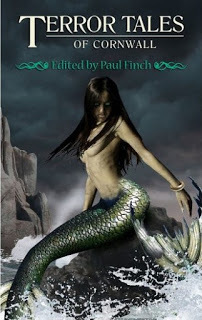 Cornwall, England’s most scenic county: windswept moors, rugged cliffs and wild, foaming seas. But smugglers and wreckers once haunted its hidden coves, mermaid myths abound, pixie lore lingers, henges signal a pagan past, and fanged beasts stalk the ancient, overgrown lanes …
Cornwall, England’s most scenic county: windswept moors, rugged cliffs and wild, foaming seas. But smugglers and wreckers once haunted its hidden coves, mermaid myths abound, pixie lore lingers, henges signal a pagan past, and fanged beasts stalk the ancient, overgrown lanes …The picture-postcard quaintness only helps in this regard, providing the cosy prism through which some truly fiendish tales can safely be assessed. It shouldn’t surprise us that one of the great godmothers of British scary fiction, Daphne due Maurier, chose her beloved Cornwall as the location for two of her spookiest stories, Rebecca(1938) and The Birds (1952).
Other writers of golden age horror clearly felt about the county the same way. Cases in point: The Smell of Evil by Charles Birkin, The Roll-Call of the Reef by Arthur Quiller-Couch and The Bodmin Terror by R. Chetwynd-Hayes, while Peter Tremayne went all monstery on us in The Morgow Rises, and Chill Company was an entire smorgasbord of eerie Cornish tales supplied by supernatural/romance author, Mary Williams.
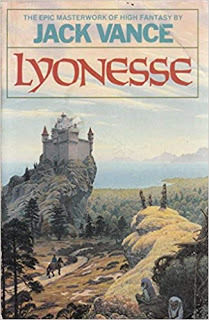 Even in the gentler climes of high fantasy, Cornwall has figured prominently. Jack Vance’s wondrous Lyonesse trilogy gorgeously and perfectly invokes the Cornish atmosphere with its minutely-detailed imagining of a now-lost continent located just beyond the tip of Land’s End, wherein faeries and ogres abound, evil wizards plot, and knights ride off on deadly quests.
Even in the gentler climes of high fantasy, Cornwall has figured prominently. Jack Vance’s wondrous Lyonesse trilogy gorgeously and perfectly invokes the Cornish atmosphere with its minutely-detailed imagining of a now-lost continent located just beyond the tip of Land’s End, wherein faeries and ogres abound, evil wizards plot, and knights ride off on deadly quests.On the subject of heroes on deadly missions, I now come neatly round to Heck and his latest escapade, KISS OF DEATH (published on August 9), which, among sundry other locations in the UK, takes him – yes, you’ve guessed it – to Cornwall.
I’d be lying if I said that it hadn’t always been an aim of mine to at some point get Heck down to the southwest peninsula, preferably at the height of a glorious English summer. He spends so much of his time working through the desolate inner city ruins of Broken Britain, usually in the most miserable weather, that it only seemed fair to give him a holiday eventually.
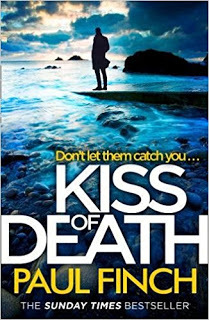 Not that this is actually much of a holiday.
Not that this is actually much of a holiday. I’ll be honest; KISS OF DEATH is only partly set in Cornwall. Before he gets there, he visits all his usual haunts: motorway underpasses where murder has been done, dingy ghettos where street-gangs and drug-dealers run unchecked, and derelict basements in forgotten parts of town now turned to the foulest purposes possible.
But yes, he also heads down to Cornwall, and in that regard, I found myself in a world of descriptive writing very different to the norm. Here are a couple of snippets:
… the whole of the West Country was famous for its pastoral ambience and picturesque villages where placid ways of life ambled on regardless of other events in the world. Even now, processing slowly into its heart via the clogged artery that was the M4, he was encircled by acres of verdant countryside, which, drenched gold in the August sun, and dotted with harvesters and hay bales, seemed almost quintessentially English.
 The village was every bit as quaint as he’d expected, mainly comprising whitewashed cottages with pan-tiled roofs and flower-filled window-baskets and built higgledy-piggledy down its own coombe to the water’s edge, where a stone quay curved outward like a bow, entrapping a small harbour filled with leisure craft.
The village was every bit as quaint as he’d expected, mainly comprising whitewashed cottages with pan-tiled roofs and flower-filled window-baskets and built higgledy-piggledy down its own coombe to the water’s edge, where a stone quay curved outward like a bow, entrapping a small harbour filled with leisure craft.If none of that sounds like Heck’s normal beat, I’ve now got an admission to make. And this is an odd one for me, as I usually get edited for being too ghoulish or violent, decisions were made at Harper HQ to cut down some of my more descriptive Cornish passages because they feared that it might change the tone of the book at little too much. You see, even down in Cornwall, Heck can’t get a break. Darkness holds dominion over all.
Anyway, you’ll be abe to judge how much for yourselves in August.
As a very quick aside, the other big Heck release of 2018, DEATH’S DOOR , a brand-new e-novella, set during his days as a junior detective in London, has been available free since June 29, and I’ve had one or two very positive responses to it so far. If you are enjoying, don’t be shy … feel free to tell the world, post reviews, etc. That’s always the best way to ensure that the fictional characters you like will keep coming back for more.
Terror
Now, back to Cornwall – and the fun part of today’s blog.
TERROR TALES OF CORNWALL was published in 2017 as the 10th volume of my round-the-UK horror anthology series, which I started in 2011. The ethos of the Terror Tales books has always been to mingle local fact with local fiction, with a heavy emphasis on folklore.
So, for example, in TERROR TALES OF CORNWALL , I published lots of new Cornish horror fiction by writers old and new; there were two reprints in there, but much original material as well, the fictional stories interspersed with spooky snippets of Cornish mythology that I myself had researched and written up.
This has been the format throughout the series, and the format we’ll continue to use when, later this year, my Terror Tales publishers, Telos Publishing, and I, will be going all out to get TERROR TALES OF NORTHWEST ENGLAND ready in time for an autumn release.
Anyway, on this same subject, you’ll hopefully recall that, last month, I decided to slightly alter my regular Thrillers, Chillers, Shockers and Killers section by occasionally reviewing and discussing anthologies and single-author collections as well as novels, and each time, of course, selecting four particular stories from the book in question, which I’d love to see incorporated into a single movie, and giving them my usual fantasy cast.
Well … I’ve still got no anthologies ready to review at present, though plenty reside in my to-be-read pile. So, in the meantime, and just for a bit of a laugh, I’m keeping my hand in by doing it with the Terror Tales books. Obviously, I won’t be reviewing them, as that would be a bit incestuous, but at least I can turn each one into a portmanteau horror movie all of my own. You may recall that on May 16, we did it with TERROR TALES OF THE LAKE DISTRICT , so here, totally keeping up with today’s main theme, is …
TERROR TALES OF CORNWALL – the movie
Just a bit of fun, remember. No film-maker has optioned this book yet, or any of the stories inside it (as far as I’m aware), but here are my thoughts on how they should proceed. Note: these four stories are NOT the ones I necessarily consider to be the best in the book, but these are the four I perceive as most filmic and most right for a compendium horror. Of course, no such horror film can happen without a central thread, and this is where you guys, the audience, come in. Just accept that four strangers have been thrown together in unusual circumstances which require them to relate spooky stories to each other. It could be that they’re all trapped in a cellar by a broken lift and are awaiting rescue (a la Vault of Horror) or are marooned on a fogbound train and forced to listen to each other’s fortunes as read by a mysterious man with a pack of cards (al la Dr Terror) – but basically, it’s up to you.
So, without further ado, here are the stories and the casts I envisage performing in them:
CLAWS by Steve Jordan
The Pirates Bounty is s shabby, underfunded amusement arcade on the Newquay seafront. Its machines are mostly second-hand, its carpets are dirty, and its owner/manager is the loutish Jared, a guy who mistreats his staff and neglects safety regulations. Slavish underlings, Sonia, Sam and Ron, suffer continually from his bad moods, and when a series of minor sabotages occurs, they cop the blame. No one listens to youthful regular, Billy, who suspects that local pixies are at fault. When Ron is injured by dangerous wiring, Sonia and Sam decide to avenge him by returning late at night and robbing the place. And still no one will listen to Billy …
Sonia - Eleanor TomlinsonSam - Charlie HeatonJared - Robert Pattinson
 WE WHO SING BENEATH THE GROUND
WE WHO SING BENEATH THE GROUNDby Mark Morris
Stacy, a Manchester-born primary school teacher is increasingly concerned about Adam, a withdrawn little boy in her class, who brings in a very unusual item during a game of ‘Show and Tell’, and then, the next day, fails to show up for school. Stacy opts to make a home visit but finds that home is a ramshackle farm on a bleak stretch of Cornish headland. Failing to read anything into the curious row of standing stones not too far from the apparently deserted homestead, she proceeds to uncover the secret of the weird object that Adam brought to school, and in the process encounters a nightmare being from local legend …
Stacy – Suranne Jones
A BEAST BY ANY OTHER NAME by Adrian Cole
Cranlow, an investigative journalist, looks into the death of Derrick Treskellian, a Cornish businessman found half-eaten on Bodmin Moor. When it was finally discovered that Treskellian was attacked by an escaped panther, the rumour that the mythical Beast of Bodmin had finally claimed a human victim was put to bed, but now, acting on a tip-off from local oddball, Jack Harrower, Cranlow comes to suspect Treskellian’s ex-business partner, Alec Ransome. The furious Ransome responds by luring Cranlow into a derelict tin mine, where it seems that many truths can be found, including the terrifying truth about the Bodmin Beast …
Cranlow - Hugh DancyHarrower - Eddie MarsanRansome - Hugh Laurie
LOSING ITS IDENTITY by Thana Niveau
Elderly widow, Miranda, lives with her fading memories in the declining coastal village of Porthkellis, and makes regular trips alone to the beautiful Lost Moon cove – much to the consternation of her daughter, Tessa, who is fearful that coastal erosion is weakening the rocky steps and changing the coastline in a way that might cause the increasingly scatty old lady to lose her way (and her life). But Miranda hears the voice of her dead husband, Will, at Lost Moon, and simply refuses to stay away. One day, she is fascinated to find the ocean rolled back and a landscape exposed reminiscent of the mysterious Roscarrock drawings, which depicted a Cornwall never known to have existed in real life. Naturally, she must investigate …
Miranda – Eileen AtkinsWill – Edward Fox
THRILLERS, CHILLERS, SHOCKERS AND KILLERS …
An ongoing series of reviews of dark fiction (crime, thriller, horror and sci-fi) – both old and new – that I have recently read and enjoyed. I’ll endeavour to keep the SPOILERS to a minimum; there will certainly be no given-away denouements or exposed twists-in-the-tail, but by the definition of the word ‘review’, I’m going to be talking about these books in more than just thumbnail detail, extolling the aspects that I particularly enjoyed … so I guess if you’d rather not know anything at all about these pieces of work in advance of reading them yourself, then these particular posts will not be your thing.
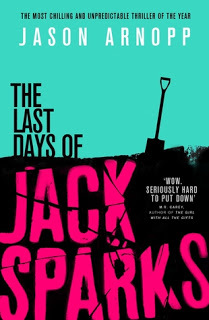 THE LAST DAYS OF JACK SPARKS
THE LAST DAYS OF JACK SPARKS by Jason Arnopp (2016)
Gonzo journalist and pop culture author, Jack Sparks, is the ultimate embodiment of the Me Generation. Self-important, narcissistic, hugely opinionated, convinced to a self-delusional degree that he’s intellectually superior to everyone he meets, arrogant, rude, you name it, he’s there, only occasionally taking time off from thinking about himself to socialise with roommate and buddy, Rebecca ‘Bex’ Lawson, though he desires her sexually as much as he wants to be her friend, so it’s not a genuine platonic relationship even then.
However, the big difference between Jack Sparks and many others of his ilk is that he is genuinely talented. A good writer, especially under pressure, scathingly witty, more than prepared to put in torturous hours to complete his assignments, and a powerpack in terms of youthful energy, he should have all the tools to go far.
Jack certainly thinks this. In fact, to Jack Sparks, success is inevitable; it’s his destiny, his entitlement. But what he is not allowing for are the two serious chinks in his armour.
First of all, he lacks discipline; so, for example, when writing the book Jack Sparks on Drugs – which needed to be completed by a ghost-writer! – he became addicted to cocaine, a habit that he’s never really thrown off. Secondly, he lacks objectivity. In many ways, Jack Sparks is not a real journalist. He goes looking for stories with preconceived notions and a determination to find the outcome that he wants, so when he settles on his comeback project, Jack Sparks on the Supernatural, it won’t be an even-handed investigation of the unknown, it will be a thorough debunking of it, a complete trashing of all those who believe.
Not everyone thinks this is a good idea. Jack’s agent and editor are no more than lukewarm about it. But Jack is adamant that he and his hipster audience are going to have a lot of laughs at the expense of the world’s gullible fools.
As he likes to travel, his first port of call is rural Italy, where he attends the exorcism of a village girl, Maria Corvi, by humourless Catholic priest, Father Primo di Stefano. Jack just about manages to keep a lid on it while the ancient rite unfolds. He’s already on the lookout for fakery, as he continually informs his fans via Twitter, but then, when the seeming heap of mumbo-jumbo becomes too much for him, he bursts out laughing.
As you can imagine, this doesn’t go down too well with those others involved, including the malevolent intelligence allegedly possessing Maria. But Jack isn’t fazed. Warnings from beyond mean nothing to him. But then someone posts an Mpeg on his YouTube account, depicting a curious and disturbing video. On the face of it, it’s the sort of thing that is commonplace online: an amateurish snippet of film depicting an alleged paranormal event – but there is something about this one that upsets everyone who sees it. People think it looks real, including Jack Sparks. The main problem, though, is that he isn’t the one who uploaded it; he doesn’t know what it’s even supposed to be. At the same time, he comes into possession of a mysterious book, which is such a shock to him that he barely mentions it in his notes – not initially.
Jack continues writing, even though he suspects that he’s being scammed by someone. But Jack is no longer quite himself. The unexplained video has unnerved him, and when his quest takes him next to Hong Kong, where, despite the guidance of eccentric Aussie medium, Sherilyn Chastain, he is even further alarmed by some of the things he experiences, an angst compounded by his determination not to accept the supernatrural. He even keeps a list of reasons why people profess belief in ghosts – THE SPOOKS LIST (Sparks’ Permanently Ongoing Overview of Kooky Shit) – and even though he continually finds himself extending it, until at one point it reads:
1) They’re trying to deceive others.2) They’ve been deceived by others.3) They’ve deceived themselves.
… while it may appear to represent modern analytical truth dressed in irreverent terms, it mainly perpetuates his narrative of scorn.
We know from the outset that none of this is going to end well. We are told from the start that ‘Jack Sparks died while writing this book’, but what we don’t know is how and why he died (or how horribly).
But neither we nor he could possibly expect it to occur in Los Angeles, where he eventually goes to meet the fat-bellied, woolly-headed Astral Way and his group of total believers, the Hollywood Paranormals, who want to him to document their attempts to create a thought-form. From the outset, and again Jack is almost pre-programmed to scoff, this feels like the biggest load of bunkum yet, but already a nervous wreck, he can’t imagine the mind-bending terror that awaits him …
The first thing to say about The Last Days of Jack Sparks is that it’s not a straightforward novel.
A lot of it is presented to us in linear format as written by Jack while he travels around the world, seeking to expose phonies. But it also contains letters, emails and footnotes written by others, his concerned but disapproving older brother, Alistair, for one. And this throws up some interesting dymanics.
For example, there are actually two Jacks. The one he and his juvenile audience believe in: the cool, smart intellect who is always ahead of the game, who can drink his rivals under the table and take out tough guys if he needs to. And the real one, a coked-out, alcoholic wreck, who fails to impress almost everyone he meets.
Okay, so Jack’s an unreliable narrator, but this device doesn’t just represent some bravura and highly original character-work by Jason Arnopp, it also plays a key role in the development of the story, because it is only gradually and through these secondary communications that we come to understand exactly how much more is going on than Jack will admit to, and how much more frightened he is than his own narrative would have us believe.
For all these reasons, I found The Last Days of Jack Sparks a completely compelling read. It turns and twists mercilessly; you literally never know what you’re going to encounter in the next chapter, and it isn’t as if stuff comes at you totally from left field, because if you read the book carefully, almost every surprise has been flagged beforehand, albeit in subtle, semi-concealed ways. In that regard, it’s an absolute romp of a thriller, but it’s also wildly, unexpectedly funny.
Some reviewers have described The Last Days of Jack Sparks as a comedy rather than a horror novel, but I think it’s probably about half-and-half. Jack’s acerbic asides are uproarious, often to the point where you briefly forget what a jerk he is. Again, this is hugely to the credit of the author, who doesn’t just use it to entertain us, but to keep us on our subconscious toes, because when we’re laughing we’re briefly distracted from what’s going on and are less ready for the next dollop of bad stuff just around the corner (and the scares eventually come thick and fast).
There is a slightly po-faced side to it as well, because in some ways The Last Days of Jack Sparks is an essay on the politics of self, with plenty of acid observations passed on the modern habit of living one’s life in the glare of social media, (or perhaps living a lie that passes for one’s life).
A terrific, highly entertaining new novel from an author who has gone out of his way to do something different with the genre and has comfortably succeeded.
And now, as always, I’m going to try and come up with a cast that might do a film or TV adaptation of The Last Days of Jack Sparksjustice. Just a bit of fun, of course. I have no expertise or authority in this field, and I have no idea whether or not the novel has been optioned, but it’s always an enjoyable exercise. So, here we go …
Jack Sparks – Taron EgertonRebecca ‘Bex’ Lawson – Elva TrillAlistair Sparks – Ben WhishawMaria Corvi – Siena AgudongSherilyn Chastain – Rachel GriffithsAstral Way – Haley Joel OsmentFather Primo di Stefano – Tony Sirico
Published on July 04, 2018 01:25



